Quick filters:
17th century germans Stock Photos and Images
 The figures represented here are all Germans in the 1600s. From left to right, they are: four man of rank. The illustration dates to 1882. Stock Photohttps://www.alamy.com/image-license-details/?v=1https://www.alamy.com/stock-photo-the-figures-represented-here-are-all-germans-in-the-1600s-from-left-115436872.html
The figures represented here are all Germans in the 1600s. From left to right, they are: four man of rank. The illustration dates to 1882. Stock Photohttps://www.alamy.com/image-license-details/?v=1https://www.alamy.com/stock-photo-the-figures-represented-here-are-all-germans-in-the-1600s-from-left-115436872.htmlRFGKPGWC–The figures represented here are all Germans in the 1600s. From left to right, they are: four man of rank. The illustration dates to 1882.
 The Sack of Rome of 1527 by Johannes Lingelbach (1622?1674). The Sack of Rome, then part of the Papal States, 1527, by the mutinous troops of Charles V, Holy Roman Emperor during his war with the League of Cognac. Despite being ordered not to storm the city, with Charles V intending to only use the threat of military action to make Pope Clement VII come to his terms, a largely unpaid Imperial army formed by 14,000 Germans, many of them Lutheran, 6,000 Spaniards and some Italian contingents occupied Rome and began looting, slaying and holding citizens for ransom. WHA 197 0249 Stock Photohttps://www.alamy.com/image-license-details/?v=1https://www.alamy.com/the-sack-of-rome-of-1527-by-johannes-lingelbach-16221674-the-sack-of-rome-then-part-of-the-papal-states-1527-by-the-mutinous-troops-of-charles-v-holy-roman-emperor-during-his-war-with-the-league-of-cognac-despite-being-ordered-not-to-storm-the-city-with-charles-v-intending-to-only-use-the-threat-of-military-action-to-make-pope-clement-vii-come-to-his-terms-a-largely-unpaid-imperial-army-formed-by-14000-germans-many-of-them-lutheran-6000-spaniards-and-some-italian-contingents-occupied-rome-and-began-looting-slaying-and-holding-citizens-for-ransom-wha-197-0249-image634317053.html
The Sack of Rome of 1527 by Johannes Lingelbach (1622?1674). The Sack of Rome, then part of the Papal States, 1527, by the mutinous troops of Charles V, Holy Roman Emperor during his war with the League of Cognac. Despite being ordered not to storm the city, with Charles V intending to only use the threat of military action to make Pope Clement VII come to his terms, a largely unpaid Imperial army formed by 14,000 Germans, many of them Lutheran, 6,000 Spaniards and some Italian contingents occupied Rome and began looting, slaying and holding citizens for ransom. WHA 197 0249 Stock Photohttps://www.alamy.com/image-license-details/?v=1https://www.alamy.com/the-sack-of-rome-of-1527-by-johannes-lingelbach-16221674-the-sack-of-rome-then-part-of-the-papal-states-1527-by-the-mutinous-troops-of-charles-v-holy-roman-emperor-during-his-war-with-the-league-of-cognac-despite-being-ordered-not-to-storm-the-city-with-charles-v-intending-to-only-use-the-threat-of-military-action-to-make-pope-clement-vii-come-to-his-terms-a-largely-unpaid-imperial-army-formed-by-14000-germans-many-of-them-lutheran-6000-spaniards-and-some-italian-contingents-occupied-rome-and-began-looting-slaying-and-holding-citizens-for-ransom-wha-197-0249-image634317053.htmlRM2YRYHTD–The Sack of Rome of 1527 by Johannes Lingelbach (1622?1674). The Sack of Rome, then part of the Papal States, 1527, by the mutinous troops of Charles V, Holy Roman Emperor during his war with the League of Cognac. Despite being ordered not to storm the city, with Charles V intending to only use the threat of military action to make Pope Clement VII come to his terms, a largely unpaid Imperial army formed by 14,000 Germans, many of them Lutheran, 6,000 Spaniards and some Italian contingents occupied Rome and began looting, slaying and holding citizens for ransom. WHA 197 0249
 Jacob Kettler (1610-1682). 3rd Duke of Curland and Semigallia (1642-1682). Portrait. Engraving. 17th century. Stock Photohttps://www.alamy.com/image-license-details/?v=1https://www.alamy.com/jacob-kettler-1610-1682-3rd-duke-of-curland-and-semigallia-1642-1682-portrait-engraving-17th-century-image558514575.html
Jacob Kettler (1610-1682). 3rd Duke of Curland and Semigallia (1642-1682). Portrait. Engraving. 17th century. Stock Photohttps://www.alamy.com/image-license-details/?v=1https://www.alamy.com/jacob-kettler-1610-1682-3rd-duke-of-curland-and-semigallia-1642-1682-portrait-engraving-17th-century-image558514575.htmlRM2RCJF13–Jacob Kettler (1610-1682). 3rd Duke of Curland and Semigallia (1642-1682). Portrait. Engraving. 17th century.
 Jacob Kettler (1610-1682). 3rd Duke of Curland and Semigallia (1642-1682). Portrait. Engraving. 17th century. Stock Photohttps://www.alamy.com/image-license-details/?v=1https://www.alamy.com/jacob-kettler-1610-1682-3rd-duke-of-curland-and-semigallia-1642-1682-portrait-engraving-17th-century-image591437264.html
Jacob Kettler (1610-1682). 3rd Duke of Curland and Semigallia (1642-1682). Portrait. Engraving. 17th century. Stock Photohttps://www.alamy.com/image-license-details/?v=1https://www.alamy.com/jacob-kettler-1610-1682-3rd-duke-of-curland-and-semigallia-1642-1682-portrait-engraving-17th-century-image591437264.htmlRM2WA687C–Jacob Kettler (1610-1682). 3rd Duke of Curland and Semigallia (1642-1682). Portrait. Engraving. 17th century.
 Utrecht masquerade of 1851: Germans, 70 AD. BC, the Germanic people. 70 AD (title on object), The Dutch History. from the earliest times to the end of the 17th century, in eight scenes, depicted in costume by H.H. Students of the Utrechtsche Hoogeschool, 25 June 1851 (series title on object), De Teutons, 70 AD. Procession with Claudius Civilis and Brinio returning the priestess Velleda after consulting her during the siege of Castra Vetera, during the Batavian Revolt. They carried Roman prisoners of war in the procession. Part of the series of eight prints of the masquerade of the students of Stock Photohttps://www.alamy.com/image-license-details/?v=1https://www.alamy.com/utrecht-masquerade-of-1851-germans-70-ad-bc-the-germanic-people-70-ad-title-on-object-the-dutch-history-from-the-earliest-times-to-the-end-of-the-17th-century-in-eight-scenes-depicted-in-costume-by-hh-students-of-the-utrechtsche-hoogeschool-25-june-1851-series-title-on-object-de-teutons-70-ad-procession-with-claudius-civilis-and-brinio-returning-the-priestess-velleda-after-consulting-her-during-the-siege-of-castra-vetera-during-the-batavian-revolt-they-carried-roman-prisoners-of-war-in-the-procession-part-of-the-series-of-eight-prints-of-the-masquerade-of-the-students-of-image606621375.html
Utrecht masquerade of 1851: Germans, 70 AD. BC, the Germanic people. 70 AD (title on object), The Dutch History. from the earliest times to the end of the 17th century, in eight scenes, depicted in costume by H.H. Students of the Utrechtsche Hoogeschool, 25 June 1851 (series title on object), De Teutons, 70 AD. Procession with Claudius Civilis and Brinio returning the priestess Velleda after consulting her during the siege of Castra Vetera, during the Batavian Revolt. They carried Roman prisoners of war in the procession. Part of the series of eight prints of the masquerade of the students of Stock Photohttps://www.alamy.com/image-license-details/?v=1https://www.alamy.com/utrecht-masquerade-of-1851-germans-70-ad-bc-the-germanic-people-70-ad-title-on-object-the-dutch-history-from-the-earliest-times-to-the-end-of-the-17th-century-in-eight-scenes-depicted-in-costume-by-hh-students-of-the-utrechtsche-hoogeschool-25-june-1851-series-title-on-object-de-teutons-70-ad-procession-with-claudius-civilis-and-brinio-returning-the-priestess-velleda-after-consulting-her-during-the-siege-of-castra-vetera-during-the-batavian-revolt-they-carried-roman-prisoners-of-war-in-the-procession-part-of-the-series-of-eight-prints-of-the-masquerade-of-the-students-of-image606621375.htmlRM2X6WYN3–Utrecht masquerade of 1851: Germans, 70 AD. BC, the Germanic people. 70 AD (title on object), The Dutch History. from the earliest times to the end of the 17th century, in eight scenes, depicted in costume by H.H. Students of the Utrechtsche Hoogeschool, 25 June 1851 (series title on object), De Teutons, 70 AD. Procession with Claudius Civilis and Brinio returning the priestess Velleda after consulting her during the siege of Castra Vetera, during the Batavian Revolt. They carried Roman prisoners of war in the procession. Part of the series of eight prints of the masquerade of the students of
 Three German noblemen at the Thirty Years War time, vintage engraving Stock Photohttps://www.alamy.com/image-license-details/?v=1https://www.alamy.com/stock-photo-three-german-noblemen-at-the-thirty-years-war-time-vintage-engraving-128724718.html
Three German noblemen at the Thirty Years War time, vintage engraving Stock Photohttps://www.alamy.com/image-license-details/?v=1https://www.alamy.com/stock-photo-three-german-noblemen-at-the-thirty-years-war-time-vintage-engraving-128724718.htmlRFHDBWKA–Three German noblemen at the Thirty Years War time, vintage engraving
 Jacob Kettler (1610-1682). 3rd Duke of Curland and Semigallia (1642-1682). Portrait. Engraving. 17th century. Stock Photohttps://www.alamy.com/image-license-details/?v=1https://www.alamy.com/jacob-kettler-1610-1682-3rd-duke-of-curland-and-semigallia-1642-1682-portrait-engraving-17th-century-image558826193.html
Jacob Kettler (1610-1682). 3rd Duke of Curland and Semigallia (1642-1682). Portrait. Engraving. 17th century. Stock Photohttps://www.alamy.com/image-license-details/?v=1https://www.alamy.com/jacob-kettler-1610-1682-3rd-duke-of-curland-and-semigallia-1642-1682-portrait-engraving-17th-century-image558826193.htmlRM2RD4ME9–Jacob Kettler (1610-1682). 3rd Duke of Curland and Semigallia (1642-1682). Portrait. Engraving. 17th century.
 St Germans church and Port Eliot, Cornwall, England, UK Stock Photohttps://www.alamy.com/image-license-details/?v=1https://www.alamy.com/stock-photo-st-germans-church-and-port-eliot-cornwall-england-uk-116330447.html
St Germans church and Port Eliot, Cornwall, England, UK Stock Photohttps://www.alamy.com/image-license-details/?v=1https://www.alamy.com/stock-photo-st-germans-church-and-port-eliot-cornwall-england-uk-116330447.htmlRMGN78JR–St Germans church and Port Eliot, Cornwall, England, UK
RM2HAR0NR–Moses and the People depicted in the Carpathian icon 'Last Judgment' from Bogliarka by an anonymous iconographer known as Monogrammist C.Z. dated from the 1660s, now on display in the Slovak National Gallery (Slovenská národná galéria) in Zvolen, Slovakia. The inscription in Carpathian Rusyn language lists the nations depicted from left to right: the Jews, the Germans, the Hungarians, the Turks, the Tatars and the Arabs.
 Interior of the renovated 17th century synagogue in the town of Sataniv which was once home to a large Jewish community and was annihilated by the Germans during the Second World War in the Horodok Raion, Khmelnytskyi Oblast, Ukraine. Stock Photohttps://www.alamy.com/image-license-details/?v=1https://www.alamy.com/interior-of-the-renovated-17th-century-synagogue-in-the-town-of-sataniv-which-was-once-home-to-a-large-jewish-community-and-was-annihilated-by-the-germans-during-the-second-world-war-in-the-horodok-raion-khmelnytskyi-oblast-ukraine-image256723809.html
Interior of the renovated 17th century synagogue in the town of Sataniv which was once home to a large Jewish community and was annihilated by the Germans during the Second World War in the Horodok Raion, Khmelnytskyi Oblast, Ukraine. Stock Photohttps://www.alamy.com/image-license-details/?v=1https://www.alamy.com/interior-of-the-renovated-17th-century-synagogue-in-the-town-of-sataniv-which-was-once-home-to-a-large-jewish-community-and-was-annihilated-by-the-germans-during-the-second-world-war-in-the-horodok-raion-khmelnytskyi-oblast-ukraine-image256723809.htmlRMTWJNRD–Interior of the renovated 17th century synagogue in the town of Sataniv which was once home to a large Jewish community and was annihilated by the Germans during the Second World War in the Horodok Raion, Khmelnytskyi Oblast, Ukraine.
 Beaker (Humpen) with the Ages of Man. 1595–1605. Bohemia. Colorless glass and enamel Visitors to Germany during the 17th century often commented on the amount of drinking that characterized entertainment and hospitality there, exemplified by the outsize drinking glasses that Germans favored. Honored guests were greeted with Willkommen sizable vessels whose entire contents visitors were expected to down. The most common form of Wilkommen were Humpen tall, cylindrical beakers often ornamented with narrative or symbolic motifs.Enameled glass, decorated by painting and firing colored powders onto Stock Photohttps://www.alamy.com/image-license-details/?v=1https://www.alamy.com/beaker-humpen-with-the-ages-of-man-15951605-bohemia-colorless-glass-and-enamel-visitors-to-germany-during-the-17th-century-often-commented-on-the-amount-of-drinking-that-characterized-entertainment-and-hospitality-there-exemplified-by-the-outsize-drinking-glasses-that-germans-favored-honored-guests-were-greeted-with-willkommen-sizable-vessels-whose-entire-contents-visitors-were-expected-to-down-the-most-common-form-of-wilkommen-were-humpen-tall-cylindrical-beakers-often-ornamented-with-narrative-or-symbolic-motifsenameled-glass-decorated-by-painting-and-firing-colored-powders-onto-image337966089.html
Beaker (Humpen) with the Ages of Man. 1595–1605. Bohemia. Colorless glass and enamel Visitors to Germany during the 17th century often commented on the amount of drinking that characterized entertainment and hospitality there, exemplified by the outsize drinking glasses that Germans favored. Honored guests were greeted with Willkommen sizable vessels whose entire contents visitors were expected to down. The most common form of Wilkommen were Humpen tall, cylindrical beakers often ornamented with narrative or symbolic motifs.Enameled glass, decorated by painting and firing colored powders onto Stock Photohttps://www.alamy.com/image-license-details/?v=1https://www.alamy.com/beaker-humpen-with-the-ages-of-man-15951605-bohemia-colorless-glass-and-enamel-visitors-to-germany-during-the-17th-century-often-commented-on-the-amount-of-drinking-that-characterized-entertainment-and-hospitality-there-exemplified-by-the-outsize-drinking-glasses-that-germans-favored-honored-guests-were-greeted-with-willkommen-sizable-vessels-whose-entire-contents-visitors-were-expected-to-down-the-most-common-form-of-wilkommen-were-humpen-tall-cylindrical-beakers-often-ornamented-with-narrative-or-symbolic-motifsenameled-glass-decorated-by-painting-and-firing-colored-powders-onto-image337966089.htmlRM2AHRK5D–Beaker (Humpen) with the Ages of Man. 1595–1605. Bohemia. Colorless glass and enamel Visitors to Germany during the 17th century often commented on the amount of drinking that characterized entertainment and hospitality there, exemplified by the outsize drinking glasses that Germans favored. Honored guests were greeted with Willkommen sizable vessels whose entire contents visitors were expected to down. The most common form of Wilkommen were Humpen tall, cylindrical beakers often ornamented with narrative or symbolic motifs.Enameled glass, decorated by painting and firing colored powders onto
 Queen Alexandra seen here unveils the memorial to nurse Edith Cavell who was shot for treason by the Germans in the First World War at Trafalgar Square. 17th March 1920 Stock Photohttps://www.alamy.com/image-license-details/?v=1https://www.alamy.com/stock-photo-queen-alexandra-seen-here-unveils-the-memorial-to-nurse-edith-cavell-82942342.html
Queen Alexandra seen here unveils the memorial to nurse Edith Cavell who was shot for treason by the Germans in the First World War at Trafalgar Square. 17th March 1920 Stock Photohttps://www.alamy.com/image-license-details/?v=1https://www.alamy.com/stock-photo-queen-alexandra-seen-here-unveils-the-memorial-to-nurse-edith-cavell-82942342.htmlRMEPX9PE–Queen Alexandra seen here unveils the memorial to nurse Edith Cavell who was shot for treason by the Germans in the First World War at Trafalgar Square. 17th March 1920
 FRIST PICTURES FROM EAST GERMANY OF 17th JUNE RIOTS 17.7.53. The first pictures taken in East Germany of the riots of the 17th June have just been smuggled out to the west. Photo shows Germans hoot and throw stones as lorry loads of Russian troops drive into Leipzig's main square. 17 July 1953 Stock Photohttps://www.alamy.com/image-license-details/?v=1https://www.alamy.com/frist-pictures-from-east-germany-of-17th-june-riots-17753-the-first-pictures-taken-in-east-germany-of-the-riots-of-the-17th-june-have-just-been-smuggled-out-to-the-west-photo-shows-germans-hoot-and-throw-stones-as-lorry-loads-of-russian-troops-drive-into-leipzigs-main-square-17-july-1953-image624400032.html
FRIST PICTURES FROM EAST GERMANY OF 17th JUNE RIOTS 17.7.53. The first pictures taken in East Germany of the riots of the 17th June have just been smuggled out to the west. Photo shows Germans hoot and throw stones as lorry loads of Russian troops drive into Leipzig's main square. 17 July 1953 Stock Photohttps://www.alamy.com/image-license-details/?v=1https://www.alamy.com/frist-pictures-from-east-germany-of-17th-june-riots-17753-the-first-pictures-taken-in-east-germany-of-the-riots-of-the-17th-june-have-just-been-smuggled-out-to-the-west-photo-shows-germans-hoot-and-throw-stones-as-lorry-loads-of-russian-troops-drive-into-leipzigs-main-square-17-july-1953-image624400032.htmlRM2Y7RTH4–FRIST PICTURES FROM EAST GERMANY OF 17th JUNE RIOTS 17.7.53. The first pictures taken in East Germany of the riots of the 17th June have just been smuggled out to the west. Photo shows Germans hoot and throw stones as lorry loads of Russian troops drive into Leipzig's main square. 17 July 1953
 Usti Nad Labem, Czech Republic. 17th Nov, 2021. Opening of permanent exhibition Our Germans in the presence of guests from Czechia and Germany was held on November 17, 2021, in Usti nad Labem, Czech Republic. Exhibition highlights history of Czech-German coexistence in territory of current Czech Republic from Middle Ages until 20th century. Credit: Ondrej Hajek/CTK Photo/Alamy Live News Stock Photohttps://www.alamy.com/image-license-details/?v=1https://www.alamy.com/usti-nad-labem-czech-republic-17th-nov-2021-opening-of-permanent-exhibition-our-germans-in-the-presence-of-guests-from-czechia-and-germany-was-held-on-november-17-2021-in-usti-nad-labem-czech-republic-exhibition-highlights-history-of-czech-german-coexistence-in-territory-of-current-czech-republic-from-middle-ages-until-20th-century-credit-ondrej-hajekctk-photoalamy-live-news-image451651550.html
Usti Nad Labem, Czech Republic. 17th Nov, 2021. Opening of permanent exhibition Our Germans in the presence of guests from Czechia and Germany was held on November 17, 2021, in Usti nad Labem, Czech Republic. Exhibition highlights history of Czech-German coexistence in territory of current Czech Republic from Middle Ages until 20th century. Credit: Ondrej Hajek/CTK Photo/Alamy Live News Stock Photohttps://www.alamy.com/image-license-details/?v=1https://www.alamy.com/usti-nad-labem-czech-republic-17th-nov-2021-opening-of-permanent-exhibition-our-germans-in-the-presence-of-guests-from-czechia-and-germany-was-held-on-november-17-2021-in-usti-nad-labem-czech-republic-exhibition-highlights-history-of-czech-german-coexistence-in-territory-of-current-czech-republic-from-middle-ages-until-20th-century-credit-ondrej-hajekctk-photoalamy-live-news-image451651550.htmlRM2H6PE4E–Usti Nad Labem, Czech Republic. 17th Nov, 2021. Opening of permanent exhibition Our Germans in the presence of guests from Czechia and Germany was held on November 17, 2021, in Usti nad Labem, Czech Republic. Exhibition highlights history of Czech-German coexistence in territory of current Czech Republic from Middle Ages until 20th century. Credit: Ondrej Hajek/CTK Photo/Alamy Live News
 Glass; Single Germans, Netherlands; End of the 17th century (1680-00-00-1700-00-00); Stock Photohttps://www.alamy.com/image-license-details/?v=1https://www.alamy.com/glass-single-germans-netherlands-end-of-the-17th-century-1680-00-00-1700-00-00-image598738544.html
Glass; Single Germans, Netherlands; End of the 17th century (1680-00-00-1700-00-00); Stock Photohttps://www.alamy.com/image-license-details/?v=1https://www.alamy.com/glass-single-germans-netherlands-end-of-the-17th-century-1680-00-00-1700-00-00-image598738544.htmlRM2WP2W3C–Glass; Single Germans, Netherlands; End of the 17th century (1680-00-00-1700-00-00);
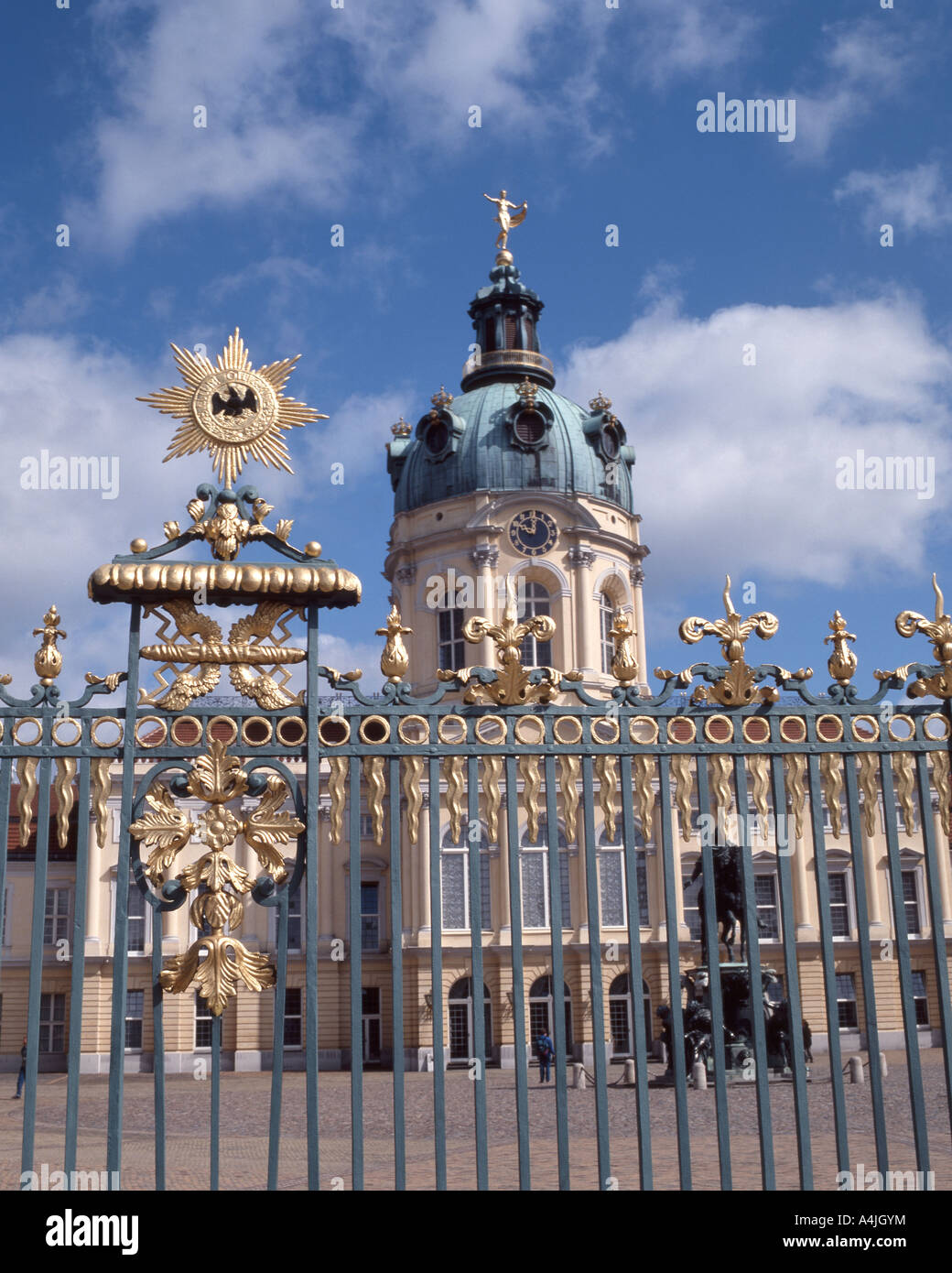 Front facade and gate of 17th century Charlottenburg Palace (Schloss Charlottenburg), Charlottenburg, Berlin, Federal Republic of Germany Stock Photohttps://www.alamy.com/image-license-details/?v=1https://www.alamy.com/stock-photo-front-facade-and-gate-of-17th-century-charlottenburg-palace-schloss-11063239.html
Front facade and gate of 17th century Charlottenburg Palace (Schloss Charlottenburg), Charlottenburg, Berlin, Federal Republic of Germany Stock Photohttps://www.alamy.com/image-license-details/?v=1https://www.alamy.com/stock-photo-front-facade-and-gate-of-17th-century-charlottenburg-palace-schloss-11063239.htmlRMA4JGYM–Front facade and gate of 17th century Charlottenburg Palace (Schloss Charlottenburg), Charlottenburg, Berlin, Federal Republic of Germany
 Matthäus Merian der Ältere (An der Entstehung Beteiligte r) Character and rite of the old Germans. etching 17. Century , 17th century Stock Photohttps://www.alamy.com/image-license-details/?v=1https://www.alamy.com/matthus-merian-der-ltere-an-der-entstehung-beteiligte-r-character-and-rite-of-the-old-germans-etching-17-century-17th-century-image572863820.html
Matthäus Merian der Ältere (An der Entstehung Beteiligte r) Character and rite of the old Germans. etching 17. Century , 17th century Stock Photohttps://www.alamy.com/image-license-details/?v=1https://www.alamy.com/matthus-merian-der-ltere-an-der-entstehung-beteiligte-r-character-and-rite-of-the-old-germans-etching-17-century-17th-century-image572863820.htmlRM2T805J4–Matthäus Merian der Ältere (An der Entstehung Beteiligte r) Character and rite of the old Germans. etching 17. Century , 17th century
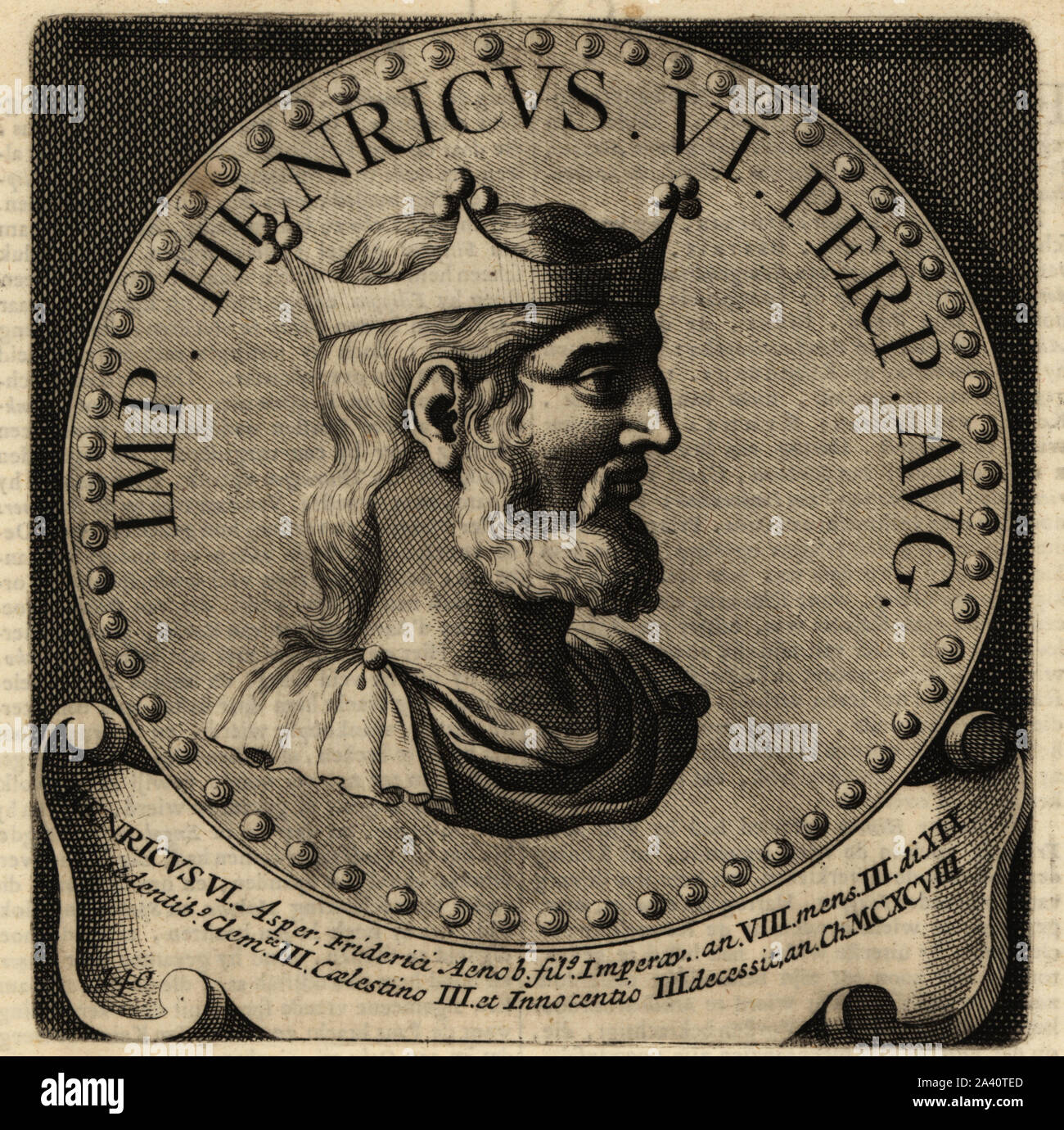 Holy Roman Emperor Henry VI, 1165-1197. Heinrich VI, Henricus VI, Asper, King of the Germans, King of Sicily. Copperplate engraving from Abraham Bogaert’s De Roomsche Monarchy, The Roman Monarchy, Francois Salma, Utrecht, 1697. Stock Photohttps://www.alamy.com/image-license-details/?v=1https://www.alamy.com/holy-roman-emperor-henry-vi-1165-1197-heinrich-vi-henricus-vi-asper-king-of-the-germans-king-of-sicily-copperplate-engraving-from-abraham-bogaerts-de-roomsche-monarchy-the-roman-monarchy-francois-salma-utrecht-1697-image329474837.html
Holy Roman Emperor Henry VI, 1165-1197. Heinrich VI, Henricus VI, Asper, King of the Germans, King of Sicily. Copperplate engraving from Abraham Bogaert’s De Roomsche Monarchy, The Roman Monarchy, Francois Salma, Utrecht, 1697. Stock Photohttps://www.alamy.com/image-license-details/?v=1https://www.alamy.com/holy-roman-emperor-henry-vi-1165-1197-heinrich-vi-henricus-vi-asper-king-of-the-germans-king-of-sicily-copperplate-engraving-from-abraham-bogaerts-de-roomsche-monarchy-the-roman-monarchy-francois-salma-utrecht-1697-image329474837.htmlRM2A40TED–Holy Roman Emperor Henry VI, 1165-1197. Heinrich VI, Henricus VI, Asper, King of the Germans, King of Sicily. Copperplate engraving from Abraham Bogaert’s De Roomsche Monarchy, The Roman Monarchy, Francois Salma, Utrecht, 1697.
![Francesco I d'Este Keeps his State Intact During the Descent of the Germans into Mantua, from L'Idea di un Principe ed Eroe Cristiano in Francesco I d'Este, di Modena e Reggio Duca VIII [...], 1659. Stock Photo Francesco I d'Este Keeps his State Intact During the Descent of the Germans into Mantua, from L'Idea di un Principe ed Eroe Cristiano in Francesco I d'Este, di Modena e Reggio Duca VIII [...], 1659. Stock Photo](https://c8.alamy.com/comp/2B7P92E/francesco-i-deste-keeps-his-state-intact-during-the-descent-of-the-germans-into-mantua-from-lidea-di-un-principe-ed-eroe-cristiano-in-francesco-i-deste-di-modena-e-reggio-duca-viii-1659-2B7P92E.jpg) Francesco I d'Este Keeps his State Intact During the Descent of the Germans into Mantua, from L'Idea di un Principe ed Eroe Cristiano in Francesco I d'Este, di Modena e Reggio Duca VIII [...], 1659. Stock Photohttps://www.alamy.com/image-license-details/?v=1https://www.alamy.com/francesco-i-deste-keeps-his-state-intact-during-the-descent-of-the-germans-into-mantua-from-lidea-di-un-principe-ed-eroe-cristiano-in-francesco-i-deste-di-modena-e-reggio-duca-viii-1659-image349000022.html
Francesco I d'Este Keeps his State Intact During the Descent of the Germans into Mantua, from L'Idea di un Principe ed Eroe Cristiano in Francesco I d'Este, di Modena e Reggio Duca VIII [...], 1659. Stock Photohttps://www.alamy.com/image-license-details/?v=1https://www.alamy.com/francesco-i-deste-keeps-his-state-intact-during-the-descent-of-the-germans-into-mantua-from-lidea-di-un-principe-ed-eroe-cristiano-in-francesco-i-deste-di-modena-e-reggio-duca-viii-1659-image349000022.htmlRM2B7P92E–Francesco I d'Este Keeps his State Intact During the Descent of the Germans into Mantua, from L'Idea di un Principe ed Eroe Cristiano in Francesco I d'Este, di Modena e Reggio Duca VIII [...], 1659.
 The figures represented here are all Germans in the 1600s. From left to right, they are: a man of rank, a woman of rank in mourning (1650-1700), and a man of rank. The illustration dates to 1882. Stock Photohttps://www.alamy.com/image-license-details/?v=1https://www.alamy.com/stock-photo-the-figures-represented-here-are-all-germans-in-the-1600s-from-left-115436887.html
The figures represented here are all Germans in the 1600s. From left to right, they are: a man of rank, a woman of rank in mourning (1650-1700), and a man of rank. The illustration dates to 1882. Stock Photohttps://www.alamy.com/image-license-details/?v=1https://www.alamy.com/stock-photo-the-figures-represented-here-are-all-germans-in-the-1600s-from-left-115436887.htmlRFGKPGWY–The figures represented here are all Germans in the 1600s. From left to right, they are: a man of rank, a woman of rank in mourning (1650-1700), and a man of rank. The illustration dates to 1882.
 San Antonio de los Alemanes Church. Madrid, Spain. Stock Photohttps://www.alamy.com/image-license-details/?v=1https://www.alamy.com/san-antonio-de-los-alemanes-church-madrid-spain-image572953258.html
San Antonio de los Alemanes Church. Madrid, Spain. Stock Photohttps://www.alamy.com/image-license-details/?v=1https://www.alamy.com/san-antonio-de-los-alemanes-church-madrid-spain-image572953258.htmlRF2T847MA–San Antonio de los Alemanes Church. Madrid, Spain.
 'Benediktbeuern was the first Benedictine monastery in the northern Alpine foothills in 739/740. Its monastery church was consecrated to Boniface, the ''Apostle of the Germans'' in 746. The Baroque monastery church (1680-86) contains vault frescoes with scenes from the history of salvation (1683/84) by Hans Georg Asam. In the monastery library was found the medieval song collection ''Carmina Burana''. (undated photo)' Stock Photohttps://www.alamy.com/image-license-details/?v=1https://www.alamy.com/benediktbeuern-was-the-first-benedictine-monastery-in-the-northern-alpine-foothills-in-739740-its-monastery-church-was-consecrated-to-boniface-the-apostle-of-the-germans-in-746-the-baroque-monastery-church-1680-86-contains-vault-frescoes-with-scenes-from-the-history-of-salvation-168384-by-hans-georg-asam-in-the-monastery-library-was-found-the-medieval-song-collection-carmina-burana-undated-photo-image550699604.html
'Benediktbeuern was the first Benedictine monastery in the northern Alpine foothills in 739/740. Its monastery church was consecrated to Boniface, the ''Apostle of the Germans'' in 746. The Baroque monastery church (1680-86) contains vault frescoes with scenes from the history of salvation (1683/84) by Hans Georg Asam. In the monastery library was found the medieval song collection ''Carmina Burana''. (undated photo)' Stock Photohttps://www.alamy.com/image-license-details/?v=1https://www.alamy.com/benediktbeuern-was-the-first-benedictine-monastery-in-the-northern-alpine-foothills-in-739740-its-monastery-church-was-consecrated-to-boniface-the-apostle-of-the-germans-in-746-the-baroque-monastery-church-1680-86-contains-vault-frescoes-with-scenes-from-the-history-of-salvation-168384-by-hans-georg-asam-in-the-monastery-library-was-found-the-medieval-song-collection-carmina-burana-undated-photo-image550699604.htmlRM2PYXEY0–'Benediktbeuern was the first Benedictine monastery in the northern Alpine foothills in 739/740. Its monastery church was consecrated to Boniface, the ''Apostle of the Germans'' in 746. The Baroque monastery church (1680-86) contains vault frescoes with scenes from the history of salvation (1683/84) by Hans Georg Asam. In the monastery library was found the medieval song collection ''Carmina Burana''. (undated photo)'
 Gregor Horstius, German Physician and Anatomist Stock Photohttps://www.alamy.com/image-license-details/?v=1https://www.alamy.com/stock-photo-gregor-horstius-german-physician-and-anatomist-135087485.html
Gregor Horstius, German Physician and Anatomist Stock Photohttps://www.alamy.com/image-license-details/?v=1https://www.alamy.com/stock-photo-gregor-horstius-german-physician-and-anatomist-135087485.htmlRMHRNND1–Gregor Horstius, German Physician and Anatomist
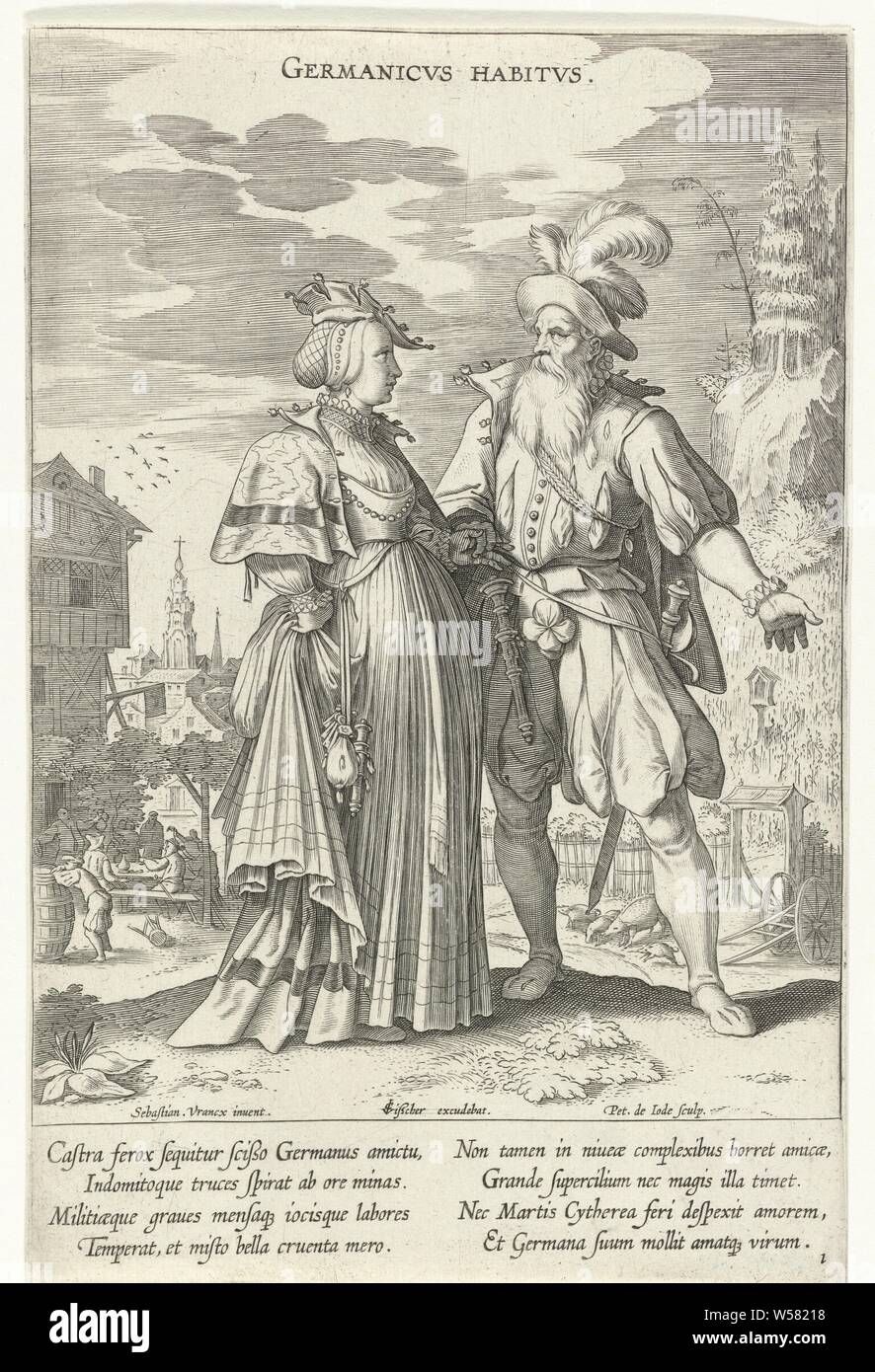 Variium Gentium Ornatus (Costumes of Different Nations) Couple dressed in German fashion ca. 1610 Germanicvs habitvs (title on object) Costumes from different countries (series title) Variarum Gentium Ornatus (series title), Landscape with a couple dressed in German fashion from the early 17th century. The woman is holding up her skirt. On the left in the background a tavern with partying and drinking figures. Right in the background a forest and pigs by a cart. In the margin, in two columns, a caption in Latin. First print from a series of ten with costumes from different countries, Europeans Stock Photohttps://www.alamy.com/image-license-details/?v=1https://www.alamy.com/variium-gentium-ornatus-costumes-of-different-nations-couple-dressed-in-german-fashion-ca-1610-germanicvs-habitvs-title-on-object-costumes-from-different-countries-series-title-variarum-gentium-ornatus-series-title-landscape-with-a-couple-dressed-in-german-fashion-from-the-early-17th-century-the-woman-is-holding-up-her-skirt-on-the-left-in-the-background-a-tavern-with-partying-and-drinking-figures-right-in-the-background-a-forest-and-pigs-by-a-cart-in-the-margin-in-two-columns-a-caption-in-latin-first-print-from-a-series-of-ten-with-costumes-from-different-countries-europeans-image261406020.html
Variium Gentium Ornatus (Costumes of Different Nations) Couple dressed in German fashion ca. 1610 Germanicvs habitvs (title on object) Costumes from different countries (series title) Variarum Gentium Ornatus (series title), Landscape with a couple dressed in German fashion from the early 17th century. The woman is holding up her skirt. On the left in the background a tavern with partying and drinking figures. Right in the background a forest and pigs by a cart. In the margin, in two columns, a caption in Latin. First print from a series of ten with costumes from different countries, Europeans Stock Photohttps://www.alamy.com/image-license-details/?v=1https://www.alamy.com/variium-gentium-ornatus-costumes-of-different-nations-couple-dressed-in-german-fashion-ca-1610-germanicvs-habitvs-title-on-object-costumes-from-different-countries-series-title-variarum-gentium-ornatus-series-title-landscape-with-a-couple-dressed-in-german-fashion-from-the-early-17th-century-the-woman-is-holding-up-her-skirt-on-the-left-in-the-background-a-tavern-with-partying-and-drinking-figures-right-in-the-background-a-forest-and-pigs-by-a-cart-in-the-margin-in-two-columns-a-caption-in-latin-first-print-from-a-series-of-ten-with-costumes-from-different-countries-europeans-image261406020.htmlRMW58218–Variium Gentium Ornatus (Costumes of Different Nations) Couple dressed in German fashion ca. 1610 Germanicvs habitvs (title on object) Costumes from different countries (series title) Variarum Gentium Ornatus (series title), Landscape with a couple dressed in German fashion from the early 17th century. The woman is holding up her skirt. On the left in the background a tavern with partying and drinking figures. Right in the background a forest and pigs by a cart. In the margin, in two columns, a caption in Latin. First print from a series of ten with costumes from different countries, Europeans
 tobacco, 'Der Teutsche Tabacktrincker' ('The German Tobacco-Drinker'), handbill against smoking, ADDITIONAL-RIGHTS-CLEARANCE-INFO-NOT-AVAILABLE Stock Photohttps://www.alamy.com/image-license-details/?v=1https://www.alamy.com/tobacco-der-teutsche-tabacktrincker-the-german-tobacco-drinker-handbill-against-smoking-additional-rights-clearance-info-not-available-image612558543.html
tobacco, 'Der Teutsche Tabacktrincker' ('The German Tobacco-Drinker'), handbill against smoking, ADDITIONAL-RIGHTS-CLEARANCE-INFO-NOT-AVAILABLE Stock Photohttps://www.alamy.com/image-license-details/?v=1https://www.alamy.com/tobacco-der-teutsche-tabacktrincker-the-german-tobacco-drinker-handbill-against-smoking-additional-rights-clearance-info-not-available-image612558543.htmlRM2XGGCJR–tobacco, 'Der Teutsche Tabacktrincker' ('The German Tobacco-Drinker'), handbill against smoking, ADDITIONAL-RIGHTS-CLEARANCE-INFO-NOT-AVAILABLE
 Martyrdom of Saint Andrew. Painting by a South German artist, first half of the 17th century. Oil on panel. Ala Ponzone Civic Museum. Cremona. Italy. Stock Photohttps://www.alamy.com/image-license-details/?v=1https://www.alamy.com/martyrdom-of-saint-andrew-painting-by-a-south-german-artist-first-half-of-the-17th-century-oil-on-panel-ala-ponzone-civic-museum-cremona-italy-image603765218.html
Martyrdom of Saint Andrew. Painting by a South German artist, first half of the 17th century. Oil on panel. Ala Ponzone Civic Museum. Cremona. Italy. Stock Photohttps://www.alamy.com/image-license-details/?v=1https://www.alamy.com/martyrdom-of-saint-andrew-painting-by-a-south-german-artist-first-half-of-the-17th-century-oil-on-panel-ala-ponzone-civic-museum-cremona-italy-image603765218.htmlRM2X27TKE–Martyrdom of Saint Andrew. Painting by a South German artist, first half of the 17th century. Oil on panel. Ala Ponzone Civic Museum. Cremona. Italy.
 Sir John Coke (1563-1644), MP and Secretary of State to King Charles I of England prior to the English Civil War, during the period from March 1629 to April 1640 when the king ruled without Parliament. One of Coke's sons supported Parliament and the other the King in the English Civil War. Square detail of engraving created in the 1700s by English engraver and artist, John Sturt (1658-1730). Stock Photohttps://www.alamy.com/image-license-details/?v=1https://www.alamy.com/sir-john-coke-1563-1644-mp-and-secretary-of-state-to-king-charles-i-of-england-prior-to-the-english-civil-war-during-the-period-from-march-1629-to-april-1640-when-the-king-ruled-without-parliament-one-of-cokes-sons-supported-parliament-and-the-other-the-king-in-the-english-civil-war-square-detail-of-engraving-created-in-the-1700s-by-english-engraver-and-artist-john-sturt-1658-1730-image550355442.html
Sir John Coke (1563-1644), MP and Secretary of State to King Charles I of England prior to the English Civil War, during the period from March 1629 to April 1640 when the king ruled without Parliament. One of Coke's sons supported Parliament and the other the King in the English Civil War. Square detail of engraving created in the 1700s by English engraver and artist, John Sturt (1658-1730). Stock Photohttps://www.alamy.com/image-license-details/?v=1https://www.alamy.com/sir-john-coke-1563-1644-mp-and-secretary-of-state-to-king-charles-i-of-england-prior-to-the-english-civil-war-during-the-period-from-march-1629-to-april-1640-when-the-king-ruled-without-parliament-one-of-cokes-sons-supported-parliament-and-the-other-the-king-in-the-english-civil-war-square-detail-of-engraving-created-in-the-1700s-by-english-engraver-and-artist-john-sturt-1658-1730-image550355442.htmlRF2PYARYE–Sir John Coke (1563-1644), MP and Secretary of State to King Charles I of England prior to the English Civil War, during the period from March 1629 to April 1640 when the king ruled without Parliament. One of Coke's sons supported Parliament and the other the King in the English Civil War. Square detail of engraving created in the 1700s by English engraver and artist, John Sturt (1658-1730).
 Portrait of Philipp Camerarius. 1670 Philipp Camerarius (born May 16, 1537 in Tübingen; died June 23, 1624 in Nuremberg) was a German legal scholar and polyhistor. Stock Photohttps://www.alamy.com/image-license-details/?v=1https://www.alamy.com/portrait-of-philipp-camerarius-1670-philipp-camerarius-born-may-16-1537-in-tbingen-died-june-23-1624-in-nuremberg-was-a-german-legal-scholar-and-polyhistor-image612029427.html
Portrait of Philipp Camerarius. 1670 Philipp Camerarius (born May 16, 1537 in Tübingen; died June 23, 1624 in Nuremberg) was a German legal scholar and polyhistor. Stock Photohttps://www.alamy.com/image-license-details/?v=1https://www.alamy.com/portrait-of-philipp-camerarius-1670-philipp-camerarius-born-may-16-1537-in-tbingen-died-june-23-1624-in-nuremberg-was-a-german-legal-scholar-and-polyhistor-image612029427.htmlRM2XFM9NR–Portrait of Philipp Camerarius. 1670 Philipp Camerarius (born May 16, 1537 in Tübingen; died June 23, 1624 in Nuremberg) was a German legal scholar and polyhistor.
 Interior of the renovated 17th century synagogue in the town of Sataniv which was once home to a large Jewish community and was annihilated, brutally, by the Germans during the Second World War in the Horodok Raion, Khmelnytskyi Oblast, Ukraine. Stock Photohttps://www.alamy.com/image-license-details/?v=1https://www.alamy.com/interior-of-the-renovated-17th-century-synagogue-in-the-town-of-sataniv-which-was-once-home-to-a-large-jewish-community-and-was-annihilated-brutally-by-the-germans-during-the-second-world-war-in-the-horodok-raion-khmelnytskyi-oblast-ukraine-image216965646.html
Interior of the renovated 17th century synagogue in the town of Sataniv which was once home to a large Jewish community and was annihilated, brutally, by the Germans during the Second World War in the Horodok Raion, Khmelnytskyi Oblast, Ukraine. Stock Photohttps://www.alamy.com/image-license-details/?v=1https://www.alamy.com/interior-of-the-renovated-17th-century-synagogue-in-the-town-of-sataniv-which-was-once-home-to-a-large-jewish-community-and-was-annihilated-brutally-by-the-germans-during-the-second-world-war-in-the-horodok-raion-khmelnytskyi-oblast-ukraine-image216965646.htmlRMPGYHW2–Interior of the renovated 17th century synagogue in the town of Sataniv which was once home to a large Jewish community and was annihilated, brutally, by the Germans during the Second World War in the Horodok Raion, Khmelnytskyi Oblast, Ukraine.
 Ernest I, called 'Ernest the Pious' 1601 – 1675, was a duke of Saxe-Gotha and Saxe-Altenburg, vintage illustration from 1842 Stock Photohttps://www.alamy.com/image-license-details/?v=1https://www.alamy.com/ernest-i-called-ernest-the-pious-1601-1675-was-a-duke-of-saxe-gotha-and-saxe-altenburg-vintage-illustration-from-1842-image396716838.html
Ernest I, called 'Ernest the Pious' 1601 – 1675, was a duke of Saxe-Gotha and Saxe-Altenburg, vintage illustration from 1842 Stock Photohttps://www.alamy.com/image-license-details/?v=1https://www.alamy.com/ernest-i-called-ernest-the-pious-1601-1675-was-a-duke-of-saxe-gotha-and-saxe-altenburg-vintage-illustration-from-1842-image396716838.htmlRM2E1C0AE–Ernest I, called 'Ernest the Pious' 1601 – 1675, was a duke of Saxe-Gotha and Saxe-Altenburg, vintage illustration from 1842
 Wallenstein move to Cheb, in the years 1634, Wallenstein at day before of his murder on the move in the city Cheb (24.02.1634) (hip downwards screen in sedan chair sitting, half right, the head in the left shore up) midst of his troops, on both sides of Walter (later count of) butler (+1634) and Giovanni Batt. Seni (1600-1656) on horse, in the foreground two gravedigger on a cemetery of a grave howk, the city Cheb. heliography based on painting (1861) V. Karl von Piloty (1826-1886), without legend. (with bract, on his forefront painter note and picture title, on his inner surface German legend Stock Photohttps://www.alamy.com/image-license-details/?v=1https://www.alamy.com/wallenstein-move-to-cheb-in-the-years-1634-wallenstein-at-day-before-of-his-murder-on-the-move-in-the-city-cheb-24021634-hip-downwards-screen-in-sedan-chair-sitting-half-right-the-head-in-the-left-shore-up-midst-of-his-troops-on-both-sides-of-walter-later-count-of-butler-1634-and-giovanni-batt-seni-1600-1656-on-horse-in-the-foreground-two-gravedigger-on-a-cemetery-of-a-grave-howk-the-city-cheb-heliography-based-on-painting-1861-v-karl-von-piloty-1826-1886-without-legend-with-bract-on-his-forefront-painter-note-and-picture-title-on-his-inner-surface-german-legend-image603239502.html
Wallenstein move to Cheb, in the years 1634, Wallenstein at day before of his murder on the move in the city Cheb (24.02.1634) (hip downwards screen in sedan chair sitting, half right, the head in the left shore up) midst of his troops, on both sides of Walter (later count of) butler (+1634) and Giovanni Batt. Seni (1600-1656) on horse, in the foreground two gravedigger on a cemetery of a grave howk, the city Cheb. heliography based on painting (1861) V. Karl von Piloty (1826-1886), without legend. (with bract, on his forefront painter note and picture title, on his inner surface German legend Stock Photohttps://www.alamy.com/image-license-details/?v=1https://www.alamy.com/wallenstein-move-to-cheb-in-the-years-1634-wallenstein-at-day-before-of-his-murder-on-the-move-in-the-city-cheb-24021634-hip-downwards-screen-in-sedan-chair-sitting-half-right-the-head-in-the-left-shore-up-midst-of-his-troops-on-both-sides-of-walter-later-count-of-butler-1634-and-giovanni-batt-seni-1600-1656-on-horse-in-the-foreground-two-gravedigger-on-a-cemetery-of-a-grave-howk-the-city-cheb-heliography-based-on-painting-1861-v-karl-von-piloty-1826-1886-without-legend-with-bract-on-his-forefront-painter-note-and-picture-title-on-his-inner-surface-german-legend-image603239502.htmlRM2X1BX3X–Wallenstein move to Cheb, in the years 1634, Wallenstein at day before of his murder on the move in the city Cheb (24.02.1634) (hip downwards screen in sedan chair sitting, half right, the head in the left shore up) midst of his troops, on both sides of Walter (later count of) butler (+1634) and Giovanni Batt. Seni (1600-1656) on horse, in the foreground two gravedigger on a cemetery of a grave howk, the city Cheb. heliography based on painting (1861) V. Karl von Piloty (1826-1886), without legend. (with bract, on his forefront painter note and picture title, on his inner surface German legend
 FRIST PICTURES FROM EAST GERMANY OF 17th JUNE RIOTS 17.7.53. The first pictures taken in East-Germany of the riots of the 17th June have just been smuggled out to the west. Photo shows The first demonstrator killed in Leipzig, by machine gun fire, is carried away by horrified Germans on an improvised stretcher made from coats. 17 July 1953 Stock Photohttps://www.alamy.com/image-license-details/?v=1https://www.alamy.com/frist-pictures-from-east-germany-of-17th-june-riots-17753-the-first-pictures-taken-in-east-germany-of-the-riots-of-the-17th-june-have-just-been-smuggled-out-to-the-west-photo-shows-the-first-demonstrator-killed-in-leipzig-by-machine-gun-fire-is-carried-away-by-horrified-germans-on-an-improvised-stretcher-made-from-coats-17-july-1953-image624399972.html
FRIST PICTURES FROM EAST GERMANY OF 17th JUNE RIOTS 17.7.53. The first pictures taken in East-Germany of the riots of the 17th June have just been smuggled out to the west. Photo shows The first demonstrator killed in Leipzig, by machine gun fire, is carried away by horrified Germans on an improvised stretcher made from coats. 17 July 1953 Stock Photohttps://www.alamy.com/image-license-details/?v=1https://www.alamy.com/frist-pictures-from-east-germany-of-17th-june-riots-17753-the-first-pictures-taken-in-east-germany-of-the-riots-of-the-17th-june-have-just-been-smuggled-out-to-the-west-photo-shows-the-first-demonstrator-killed-in-leipzig-by-machine-gun-fire-is-carried-away-by-horrified-germans-on-an-improvised-stretcher-made-from-coats-17-july-1953-image624399972.htmlRM2Y7RTF0–FRIST PICTURES FROM EAST GERMANY OF 17th JUNE RIOTS 17.7.53. The first pictures taken in East-Germany of the riots of the 17th June have just been smuggled out to the west. Photo shows The first demonstrator killed in Leipzig, by machine gun fire, is carried away by horrified Germans on an improvised stretcher made from coats. 17 July 1953
 Usti Nad Labem, Czech Republic. 17th Nov, 2021. Opening of permanent exhibition Our Germans in the presence of guests from Czechia and Germany was held on November 17, 2021, in Usti nad Labem, Czech Republic. Exhibition highlights history of Czech-German coexistence in territory of current Czech Republic from Middle Ages until 20th century. Credit: Ondrej Hajek/CTK Photo/Alamy Live News Stock Photohttps://www.alamy.com/image-license-details/?v=1https://www.alamy.com/usti-nad-labem-czech-republic-17th-nov-2021-opening-of-permanent-exhibition-our-germans-in-the-presence-of-guests-from-czechia-and-germany-was-held-on-november-17-2021-in-usti-nad-labem-czech-republic-exhibition-highlights-history-of-czech-german-coexistence-in-territory-of-current-czech-republic-from-middle-ages-until-20th-century-credit-ondrej-hajekctk-photoalamy-live-news-image451651446.html
Usti Nad Labem, Czech Republic. 17th Nov, 2021. Opening of permanent exhibition Our Germans in the presence of guests from Czechia and Germany was held on November 17, 2021, in Usti nad Labem, Czech Republic. Exhibition highlights history of Czech-German coexistence in territory of current Czech Republic from Middle Ages until 20th century. Credit: Ondrej Hajek/CTK Photo/Alamy Live News Stock Photohttps://www.alamy.com/image-license-details/?v=1https://www.alamy.com/usti-nad-labem-czech-republic-17th-nov-2021-opening-of-permanent-exhibition-our-germans-in-the-presence-of-guests-from-czechia-and-germany-was-held-on-november-17-2021-in-usti-nad-labem-czech-republic-exhibition-highlights-history-of-czech-german-coexistence-in-territory-of-current-czech-republic-from-middle-ages-until-20th-century-credit-ondrej-hajekctk-photoalamy-live-news-image451651446.htmlRM2H6PE0P–Usti Nad Labem, Czech Republic. 17th Nov, 2021. Opening of permanent exhibition Our Germans in the presence of guests from Czechia and Germany was held on November 17, 2021, in Usti nad Labem, Czech Republic. Exhibition highlights history of Czech-German coexistence in territory of current Czech Republic from Middle Ages until 20th century. Credit: Ondrej Hajek/CTK Photo/Alamy Live News
 Wilhelm III, Prince of Orange, King of England, as young one, victorious commander-in chief and proconsul of the coalescess Dutch provinces on horse in the foreground of a fighting scene: whole figure in linker profile, the face half from the left the viewer facing, with Allongehaar, in riding outfit and cuirassier armour, with facing sword pendants, truncheon in the raked, rein in the left, the horse with caparison and something strap jewellery, the foreleg soar, from top left, from heavenly host light jut, is reaching him a hand palm leaf and laurel wreath, top on the right of a scroll with Stock Photohttps://www.alamy.com/image-license-details/?v=1https://www.alamy.com/wilhelm-iii-prince-of-orange-king-of-england-as-young-one-victorious-commander-in-chief-and-proconsul-of-the-coalescess-dutch-provinces-on-horse-in-the-foreground-of-a-fighting-scene-whole-figure-in-linker-profile-the-face-half-from-the-left-the-viewer-facing-with-allongehaar-in-riding-outfit-and-cuirassier-armour-with-facing-sword-pendants-truncheon-in-the-raked-rein-in-the-left-the-horse-with-caparison-and-something-strap-jewellery-the-foreleg-soar-from-top-left-from-heavenly-host-light-jut-is-reaching-him-a-hand-palm-leaf-and-laurel-wreath-top-on-the-right-of-a-scroll-with-image603235394.html
Wilhelm III, Prince of Orange, King of England, as young one, victorious commander-in chief and proconsul of the coalescess Dutch provinces on horse in the foreground of a fighting scene: whole figure in linker profile, the face half from the left the viewer facing, with Allongehaar, in riding outfit and cuirassier armour, with facing sword pendants, truncheon in the raked, rein in the left, the horse with caparison and something strap jewellery, the foreleg soar, from top left, from heavenly host light jut, is reaching him a hand palm leaf and laurel wreath, top on the right of a scroll with Stock Photohttps://www.alamy.com/image-license-details/?v=1https://www.alamy.com/wilhelm-iii-prince-of-orange-king-of-england-as-young-one-victorious-commander-in-chief-and-proconsul-of-the-coalescess-dutch-provinces-on-horse-in-the-foreground-of-a-fighting-scene-whole-figure-in-linker-profile-the-face-half-from-the-left-the-viewer-facing-with-allongehaar-in-riding-outfit-and-cuirassier-armour-with-facing-sword-pendants-truncheon-in-the-raked-rein-in-the-left-the-horse-with-caparison-and-something-strap-jewellery-the-foreleg-soar-from-top-left-from-heavenly-host-light-jut-is-reaching-him-a-hand-palm-leaf-and-laurel-wreath-top-on-the-right-of-a-scroll-with-image603235394.htmlRM2X1BMW6–Wilhelm III, Prince of Orange, King of England, as young one, victorious commander-in chief and proconsul of the coalescess Dutch provinces on horse in the foreground of a fighting scene: whole figure in linker profile, the face half from the left the viewer facing, with Allongehaar, in riding outfit and cuirassier armour, with facing sword pendants, truncheon in the raked, rein in the left, the horse with caparison and something strap jewellery, the foreleg soar, from top left, from heavenly host light jut, is reaching him a hand palm leaf and laurel wreath, top on the right of a scroll with
![. The Jacob Paxson Temple collection of early American furniture and objects of art [electronic resource]. ad developedthese European models in a spirit of individuality, so that we can dis-tinguish at least three main lines of evolution:—the Xew Knglandstvle, the Pennsylvania!! style, and the style of the Southern states,to which we shall have to add the strange and great creations of thePennsylvania-Germans, which date back to the late 17th century. Theformal elegance of the South contrasts with the sturdy solidity of thefurniture from the Quaker city, while the Xew England furniturepleases Stock Photo . The Jacob Paxson Temple collection of early American furniture and objects of art [electronic resource]. ad developedthese European models in a spirit of individuality, so that we can dis-tinguish at least three main lines of evolution:—the Xew Knglandstvle, the Pennsylvania!! style, and the style of the Southern states,to which we shall have to add the strange and great creations of thePennsylvania-Germans, which date back to the late 17th century. Theformal elegance of the South contrasts with the sturdy solidity of thefurniture from the Quaker city, while the Xew England furniturepleases Stock Photo](https://c8.alamy.com/comp/2CENDCF/the-jacob-paxson-temple-collection-of-early-american-furniture-and-objects-of-art-electronic-resource-ad-developedthese-european-models-in-a-spirit-of-individuality-so-that-we-can-dis-tinguish-at-least-three-main-lines-of-evolutionthe-xew-knglandstvle-the-pennsylvania!!-style-and-the-style-of-the-southern-statesto-which-we-shall-have-to-add-the-strange-and-great-creations-of-thepennsylvania-germans-which-date-back-to-the-late-17th-century-theformal-elegance-of-the-south-contrasts-with-the-sturdy-solidity-of-thefurniture-from-the-quaker-city-while-the-xew-england-furniturepleases-2CENDCF.jpg) . The Jacob Paxson Temple collection of early American furniture and objects of art [electronic resource]. ad developedthese European models in a spirit of individuality, so that we can dis-tinguish at least three main lines of evolution:—the Xew Knglandstvle, the Pennsylvania!! style, and the style of the Southern states,to which we shall have to add the strange and great creations of thePennsylvania-Germans, which date back to the late 17th century. Theformal elegance of the South contrasts with the sturdy solidity of thefurniture from the Quaker city, while the Xew England furniturepleases Stock Photohttps://www.alamy.com/image-license-details/?v=1https://www.alamy.com/the-jacob-paxson-temple-collection-of-early-american-furniture-and-objects-of-art-electronic-resource-ad-developedthese-european-models-in-a-spirit-of-individuality-so-that-we-can-dis-tinguish-at-least-three-main-lines-of-evolutionthe-xew-knglandstvle-the-pennsylvania!!-style-and-the-style-of-the-southern-statesto-which-we-shall-have-to-add-the-strange-and-great-creations-of-thepennsylvania-germans-which-date-back-to-the-late-17th-century-theformal-elegance-of-the-south-contrasts-with-the-sturdy-solidity-of-thefurniture-from-the-quaker-city-while-the-xew-england-furniturepleases-image370494447.html
. The Jacob Paxson Temple collection of early American furniture and objects of art [electronic resource]. ad developedthese European models in a spirit of individuality, so that we can dis-tinguish at least three main lines of evolution:—the Xew Knglandstvle, the Pennsylvania!! style, and the style of the Southern states,to which we shall have to add the strange and great creations of thePennsylvania-Germans, which date back to the late 17th century. Theformal elegance of the South contrasts with the sturdy solidity of thefurniture from the Quaker city, while the Xew England furniturepleases Stock Photohttps://www.alamy.com/image-license-details/?v=1https://www.alamy.com/the-jacob-paxson-temple-collection-of-early-american-furniture-and-objects-of-art-electronic-resource-ad-developedthese-european-models-in-a-spirit-of-individuality-so-that-we-can-dis-tinguish-at-least-three-main-lines-of-evolutionthe-xew-knglandstvle-the-pennsylvania!!-style-and-the-style-of-the-southern-statesto-which-we-shall-have-to-add-the-strange-and-great-creations-of-thepennsylvania-germans-which-date-back-to-the-late-17th-century-theformal-elegance-of-the-south-contrasts-with-the-sturdy-solidity-of-thefurniture-from-the-quaker-city-while-the-xew-england-furniturepleases-image370494447.htmlRM2CENDCF–. The Jacob Paxson Temple collection of early American furniture and objects of art [electronic resource]. ad developedthese European models in a spirit of individuality, so that we can dis-tinguish at least three main lines of evolution:—the Xew Knglandstvle, the Pennsylvania!! style, and the style of the Southern states,to which we shall have to add the strange and great creations of thePennsylvania-Germans, which date back to the late 17th century. Theformal elegance of the South contrasts with the sturdy solidity of thefurniture from the Quaker city, while the Xew England furniturepleases
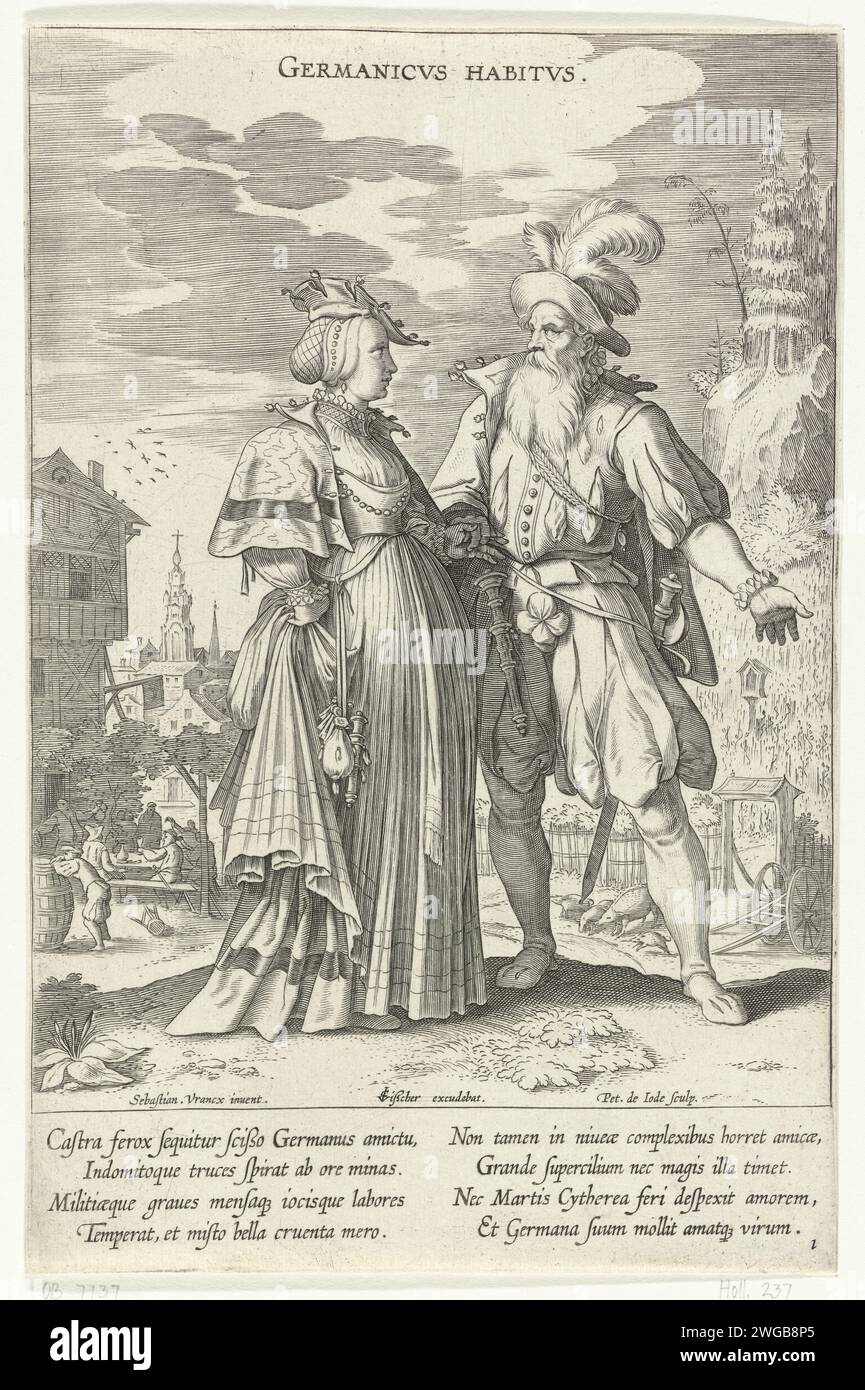 Varying Gentium (costumes of different nations), Pieter de Jode (1), after Sebastiaen Vrancx, 1605 - 1610 Landscape with a few, dressed according to German fashion from the beginning of the 17th century. The woman stops her overlay. On the left in the background a tavern with partying and drinking figures. On the right in the background a forest and pigs at a cart. In the margin, in two columns, a caption in Latin. First print from a series of ten with costumes from different countries. print maker: Antwerppublisher: Amsterdam paper engraving Europeans: Germans. head-gear: hat (+ men's clothe Stock Photohttps://www.alamy.com/image-license-details/?v=1https://www.alamy.com/varying-gentium-costumes-of-different-nations-pieter-de-jode-1-after-sebastiaen-vrancx-1605-1610-landscape-with-a-few-dressed-according-to-german-fashion-from-the-beginning-of-the-17th-century-the-woman-stops-her-overlay-on-the-left-in-the-background-a-tavern-with-partying-and-drinking-figures-on-the-right-in-the-background-a-forest-and-pigs-at-a-cart-in-the-margin-in-two-columns-a-caption-in-latin-first-print-from-a-series-of-ten-with-costumes-from-different-countries-print-maker-antwerppublisher-amsterdam-paper-engraving-europeans-germans-head-gear-hat-mens-clothe-image595235373.html
Varying Gentium (costumes of different nations), Pieter de Jode (1), after Sebastiaen Vrancx, 1605 - 1610 Landscape with a few, dressed according to German fashion from the beginning of the 17th century. The woman stops her overlay. On the left in the background a tavern with partying and drinking figures. On the right in the background a forest and pigs at a cart. In the margin, in two columns, a caption in Latin. First print from a series of ten with costumes from different countries. print maker: Antwerppublisher: Amsterdam paper engraving Europeans: Germans. head-gear: hat (+ men's clothe Stock Photohttps://www.alamy.com/image-license-details/?v=1https://www.alamy.com/varying-gentium-costumes-of-different-nations-pieter-de-jode-1-after-sebastiaen-vrancx-1605-1610-landscape-with-a-few-dressed-according-to-german-fashion-from-the-beginning-of-the-17th-century-the-woman-stops-her-overlay-on-the-left-in-the-background-a-tavern-with-partying-and-drinking-figures-on-the-right-in-the-background-a-forest-and-pigs-at-a-cart-in-the-margin-in-two-columns-a-caption-in-latin-first-print-from-a-series-of-ten-with-costumes-from-different-countries-print-maker-antwerppublisher-amsterdam-paper-engraving-europeans-germans-head-gear-hat-mens-clothe-image595235373.htmlRM2WGB8P5–Varying Gentium (costumes of different nations), Pieter de Jode (1), after Sebastiaen Vrancx, 1605 - 1610 Landscape with a few, dressed according to German fashion from the beginning of the 17th century. The woman stops her overlay. On the left in the background a tavern with partying and drinking figures. On the right in the background a forest and pigs at a cart. In the margin, in two columns, a caption in Latin. First print from a series of ten with costumes from different countries. print maker: Antwerppublisher: Amsterdam paper engraving Europeans: Germans. head-gear: hat (+ men's clothe
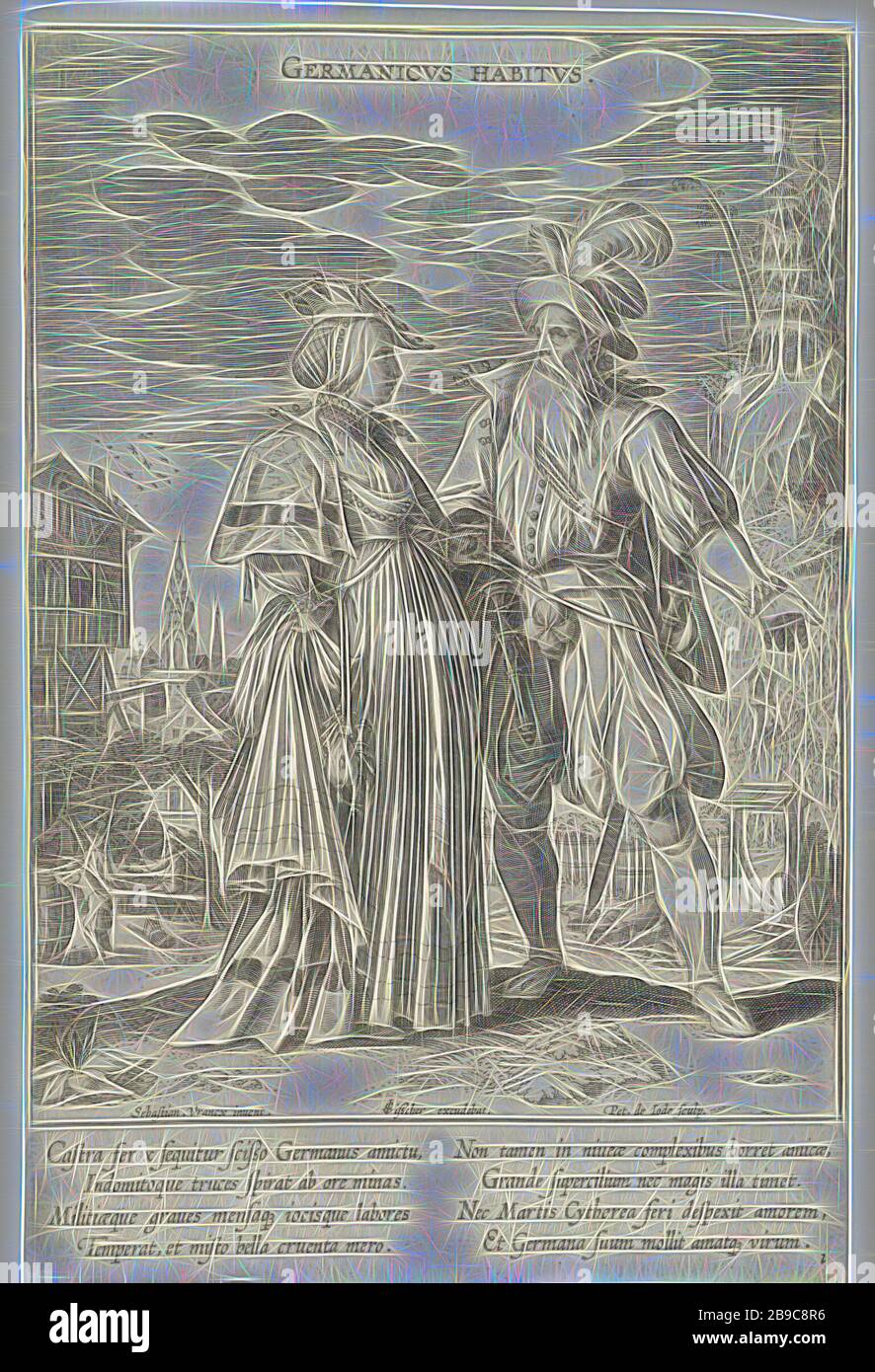 Variium Gentium Ornatus (Costumes of Different Nations) Couple dressed in German fashion ca. 1610 Germanicvs habitvs (title on object) Costumes from different countries (series title) Variarum Gentium Ornatus (series title), Landscape with a couple dressed in German fashion from the early 17th century. The woman is holding up her skirt. On the left in the background a tavern with partying and drinking figures. Right in the background a forest and pigs by a cart. In the margin, in two columns, a caption in Latin. First print from a series of ten with costumes from different countries, Europeans Stock Photohttps://www.alamy.com/image-license-details/?v=1https://www.alamy.com/variium-gentium-ornatus-costumes-of-different-nations-couple-dressed-in-german-fashion-ca-1610-germanicvs-habitvs-title-on-object-costumes-from-different-countries-series-title-variarum-gentium-ornatus-series-title-landscape-with-a-couple-dressed-in-german-fashion-from-the-early-17th-century-the-woman-is-holding-up-her-skirt-on-the-left-in-the-background-a-tavern-with-partying-and-drinking-figures-right-in-the-background-a-forest-and-pigs-by-a-cart-in-the-margin-in-two-columns-a-caption-in-latin-first-print-from-a-series-of-ten-with-costumes-from-different-countries-europeans-image350009610.html
Variium Gentium Ornatus (Costumes of Different Nations) Couple dressed in German fashion ca. 1610 Germanicvs habitvs (title on object) Costumes from different countries (series title) Variarum Gentium Ornatus (series title), Landscape with a couple dressed in German fashion from the early 17th century. The woman is holding up her skirt. On the left in the background a tavern with partying and drinking figures. Right in the background a forest and pigs by a cart. In the margin, in two columns, a caption in Latin. First print from a series of ten with costumes from different countries, Europeans Stock Photohttps://www.alamy.com/image-license-details/?v=1https://www.alamy.com/variium-gentium-ornatus-costumes-of-different-nations-couple-dressed-in-german-fashion-ca-1610-germanicvs-habitvs-title-on-object-costumes-from-different-countries-series-title-variarum-gentium-ornatus-series-title-landscape-with-a-couple-dressed-in-german-fashion-from-the-early-17th-century-the-woman-is-holding-up-her-skirt-on-the-left-in-the-background-a-tavern-with-partying-and-drinking-figures-right-in-the-background-a-forest-and-pigs-by-a-cart-in-the-margin-in-two-columns-a-caption-in-latin-first-print-from-a-series-of-ten-with-costumes-from-different-countries-europeans-image350009610.htmlRF2B9C8R6–Variium Gentium Ornatus (Costumes of Different Nations) Couple dressed in German fashion ca. 1610 Germanicvs habitvs (title on object) Costumes from different countries (series title) Variarum Gentium Ornatus (series title), Landscape with a couple dressed in German fashion from the early 17th century. The woman is holding up her skirt. On the left in the background a tavern with partying and drinking figures. Right in the background a forest and pigs by a cart. In the margin, in two columns, a caption in Latin. First print from a series of ten with costumes from different countries, Europeans
![Despite the Corageous Opposition of the Germans and the Spanish, Francesco I d'Este, at the Head of his Armies, Arrives at the Piazza di Valeneza, from L'Idea di un Principe ed Eroe Cristiano in Francesco I d'Este, di Modena e Reggio Duca VIII [...], 1659. Stock Photo Despite the Corageous Opposition of the Germans and the Spanish, Francesco I d'Este, at the Head of his Armies, Arrives at the Piazza di Valeneza, from L'Idea di un Principe ed Eroe Cristiano in Francesco I d'Este, di Modena e Reggio Duca VIII [...], 1659. Stock Photo](https://c8.alamy.com/comp/2B7P921/despite-the-corageous-opposition-of-the-germans-and-the-spanish-francesco-i-deste-at-the-head-of-his-armies-arrives-at-the-piazza-di-valeneza-from-lidea-di-un-principe-ed-eroe-cristiano-in-francesco-i-deste-di-modena-e-reggio-duca-viii-1659-2B7P921.jpg) Despite the Corageous Opposition of the Germans and the Spanish, Francesco I d'Este, at the Head of his Armies, Arrives at the Piazza di Valeneza, from L'Idea di un Principe ed Eroe Cristiano in Francesco I d'Este, di Modena e Reggio Duca VIII [...], 1659. Stock Photohttps://www.alamy.com/image-license-details/?v=1https://www.alamy.com/despite-the-corageous-opposition-of-the-germans-and-the-spanish-francesco-i-deste-at-the-head-of-his-armies-arrives-at-the-piazza-di-valeneza-from-lidea-di-un-principe-ed-eroe-cristiano-in-francesco-i-deste-di-modena-e-reggio-duca-viii-1659-image349000009.html
Despite the Corageous Opposition of the Germans and the Spanish, Francesco I d'Este, at the Head of his Armies, Arrives at the Piazza di Valeneza, from L'Idea di un Principe ed Eroe Cristiano in Francesco I d'Este, di Modena e Reggio Duca VIII [...], 1659. Stock Photohttps://www.alamy.com/image-license-details/?v=1https://www.alamy.com/despite-the-corageous-opposition-of-the-germans-and-the-spanish-francesco-i-deste-at-the-head-of-his-armies-arrives-at-the-piazza-di-valeneza-from-lidea-di-un-principe-ed-eroe-cristiano-in-francesco-i-deste-di-modena-e-reggio-duca-viii-1659-image349000009.htmlRM2B7P921–Despite the Corageous Opposition of the Germans and the Spanish, Francesco I d'Este, at the Head of his Armies, Arrives at the Piazza di Valeneza, from L'Idea di un Principe ed Eroe Cristiano in Francesco I d'Este, di Modena e Reggio Duca VIII [...], 1659.
 The figures represented here are German men of rank in the 1600s. The illustration dates to 1882. Stock Photohttps://www.alamy.com/image-license-details/?v=1https://www.alamy.com/stock-photo-the-figures-represented-here-are-german-men-of-rank-in-the-1600s-the-115436882.html
The figures represented here are German men of rank in the 1600s. The illustration dates to 1882. Stock Photohttps://www.alamy.com/image-license-details/?v=1https://www.alamy.com/stock-photo-the-figures-represented-here-are-german-men-of-rank-in-the-1600s-the-115436882.htmlRFGKPGWP–The figures represented here are German men of rank in the 1600s. The illustration dates to 1882.
 San Antonio de los Alemanes Church. Madrid, Spain. Stock Photohttps://www.alamy.com/image-license-details/?v=1https://www.alamy.com/san-antonio-de-los-alemanes-church-madrid-spain-image572953250.html
San Antonio de los Alemanes Church. Madrid, Spain. Stock Photohttps://www.alamy.com/image-license-details/?v=1https://www.alamy.com/san-antonio-de-los-alemanes-church-madrid-spain-image572953250.htmlRF2T847M2–San Antonio de los Alemanes Church. Madrid, Spain.
 'Benediktbeuern was the first Benedictine monastery in the northern Alpine foothills in 739/740. Its monastery church was consecrated to Boniface, the ''Apostle of the Germans'' in 746. The Baroque monastery church (1680-86) contains vault frescoes with scenes from the history of salvation (1683/84) by Hans Georg Asam. In the monastery library was found the medieval song collection ''Carmina Burana''. (undated photo)' Stock Photohttps://www.alamy.com/image-license-details/?v=1https://www.alamy.com/benediktbeuern-was-the-first-benedictine-monastery-in-the-northern-alpine-foothills-in-739740-its-monastery-church-was-consecrated-to-boniface-the-apostle-of-the-germans-in-746-the-baroque-monastery-church-1680-86-contains-vault-frescoes-with-scenes-from-the-history-of-salvation-168384-by-hans-georg-asam-in-the-monastery-library-was-found-the-medieval-song-collection-carmina-burana-undated-photo-image550699594.html
'Benediktbeuern was the first Benedictine monastery in the northern Alpine foothills in 739/740. Its monastery church was consecrated to Boniface, the ''Apostle of the Germans'' in 746. The Baroque monastery church (1680-86) contains vault frescoes with scenes from the history of salvation (1683/84) by Hans Georg Asam. In the monastery library was found the medieval song collection ''Carmina Burana''. (undated photo)' Stock Photohttps://www.alamy.com/image-license-details/?v=1https://www.alamy.com/benediktbeuern-was-the-first-benedictine-monastery-in-the-northern-alpine-foothills-in-739740-its-monastery-church-was-consecrated-to-boniface-the-apostle-of-the-germans-in-746-the-baroque-monastery-church-1680-86-contains-vault-frescoes-with-scenes-from-the-history-of-salvation-168384-by-hans-georg-asam-in-the-monastery-library-was-found-the-medieval-song-collection-carmina-burana-undated-photo-image550699594.htmlRM2PYXEXJ–'Benediktbeuern was the first Benedictine monastery in the northern Alpine foothills in 739/740. Its monastery church was consecrated to Boniface, the ''Apostle of the Germans'' in 746. The Baroque monastery church (1680-86) contains vault frescoes with scenes from the history of salvation (1683/84) by Hans Georg Asam. In the monastery library was found the medieval song collection ''Carmina Burana''. (undated photo)'
 Gregor Horstius, German Physician and Anatomist Stock Photohttps://www.alamy.com/image-license-details/?v=1https://www.alamy.com/stock-photo-gregor-horstius-german-physician-and-anatomist-135087491.html
Gregor Horstius, German Physician and Anatomist Stock Photohttps://www.alamy.com/image-license-details/?v=1https://www.alamy.com/stock-photo-gregor-horstius-german-physician-and-anatomist-135087491.htmlRMHRNND7–Gregor Horstius, German Physician and Anatomist
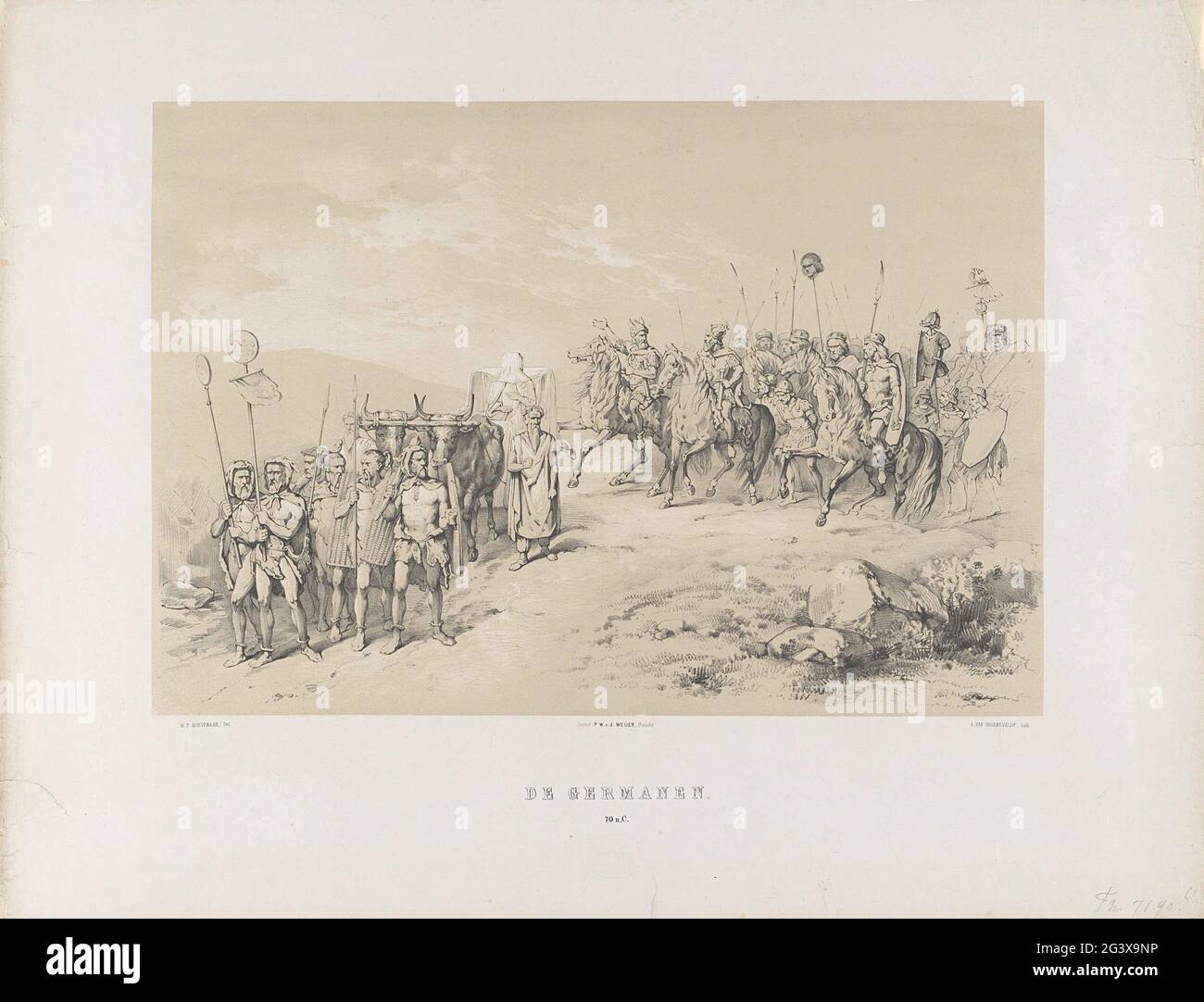 Utrecht masquerade of 1851: Germanen, 70 n. Chr.; The Germans. 70 N.C.; Patriotic history. From the earliest times to the end of the 17th century, in eight scenes, in a costume suggested by H.H. DTudenten der Utrechtsche Hoogeschool, Den 25 Juny 1851. De Germanen, 70 AD. Procession with Claudius Civilis and Brinio who reduce the priestess Velleda after having consulted her during the Siege of Castra Vetera, during the Batavian rebellion. They carry Roman prisoners of war in the procession. Part of the series of eight prints of the masquerade of the students of the Utrecht University of Applied Stock Photohttps://www.alamy.com/image-license-details/?v=1https://www.alamy.com/utrecht-masquerade-of-1851-germanen-70-n-chr-the-germans-70-nc-patriotic-history-from-the-earliest-times-to-the-end-of-the-17th-century-in-eight-scenes-in-a-costume-suggested-by-hh-dtudenten-der-utrechtsche-hoogeschool-den-25-juny-1851-de-germanen-70-ad-procession-with-claudius-civilis-and-brinio-who-reduce-the-priestess-velleda-after-having-consulted-her-during-the-siege-of-castra-vetera-during-the-batavian-rebellion-they-carry-roman-prisoners-of-war-in-the-procession-part-of-the-series-of-eight-prints-of-the-masquerade-of-the-students-of-the-utrecht-university-of-applied-image432681586.html
Utrecht masquerade of 1851: Germanen, 70 n. Chr.; The Germans. 70 N.C.; Patriotic history. From the earliest times to the end of the 17th century, in eight scenes, in a costume suggested by H.H. DTudenten der Utrechtsche Hoogeschool, Den 25 Juny 1851. De Germanen, 70 AD. Procession with Claudius Civilis and Brinio who reduce the priestess Velleda after having consulted her during the Siege of Castra Vetera, during the Batavian rebellion. They carry Roman prisoners of war in the procession. Part of the series of eight prints of the masquerade of the students of the Utrecht University of Applied Stock Photohttps://www.alamy.com/image-license-details/?v=1https://www.alamy.com/utrecht-masquerade-of-1851-germanen-70-n-chr-the-germans-70-nc-patriotic-history-from-the-earliest-times-to-the-end-of-the-17th-century-in-eight-scenes-in-a-costume-suggested-by-hh-dtudenten-der-utrechtsche-hoogeschool-den-25-juny-1851-de-germanen-70-ad-procession-with-claudius-civilis-and-brinio-who-reduce-the-priestess-velleda-after-having-consulted-her-during-the-siege-of-castra-vetera-during-the-batavian-rebellion-they-carry-roman-prisoners-of-war-in-the-procession-part-of-the-series-of-eight-prints-of-the-masquerade-of-the-students-of-the-utrecht-university-of-applied-image432681586.htmlRM2G3X9NP–Utrecht masquerade of 1851: Germanen, 70 n. Chr.; The Germans. 70 N.C.; Patriotic history. From the earliest times to the end of the 17th century, in eight scenes, in a costume suggested by H.H. DTudenten der Utrechtsche Hoogeschool, Den 25 Juny 1851. De Germanen, 70 AD. Procession with Claudius Civilis and Brinio who reduce the priestess Velleda after having consulted her during the Siege of Castra Vetera, during the Batavian rebellion. They carry Roman prisoners of war in the procession. Part of the series of eight prints of the masquerade of the students of the Utrecht University of Applied
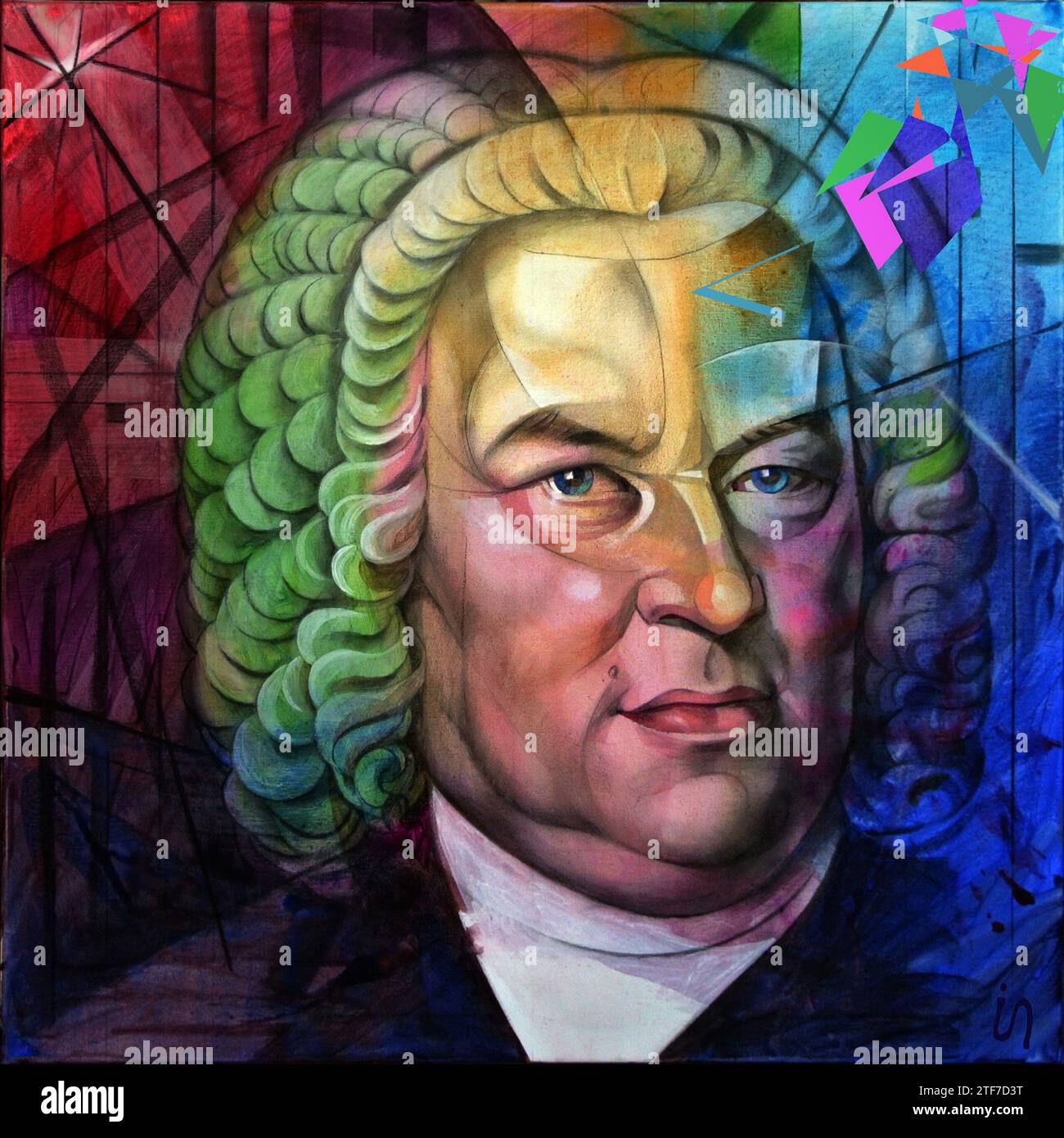 Portrait of Johann Sebastian Bach Stock Photohttps://www.alamy.com/image-license-details/?v=1https://www.alamy.com/portrait-of-johann-sebastian-bach-image577325948.html
Portrait of Johann Sebastian Bach Stock Photohttps://www.alamy.com/image-license-details/?v=1https://www.alamy.com/portrait-of-johann-sebastian-bach-image577325948.htmlRF2TF7D3T–Portrait of Johann Sebastian Bach
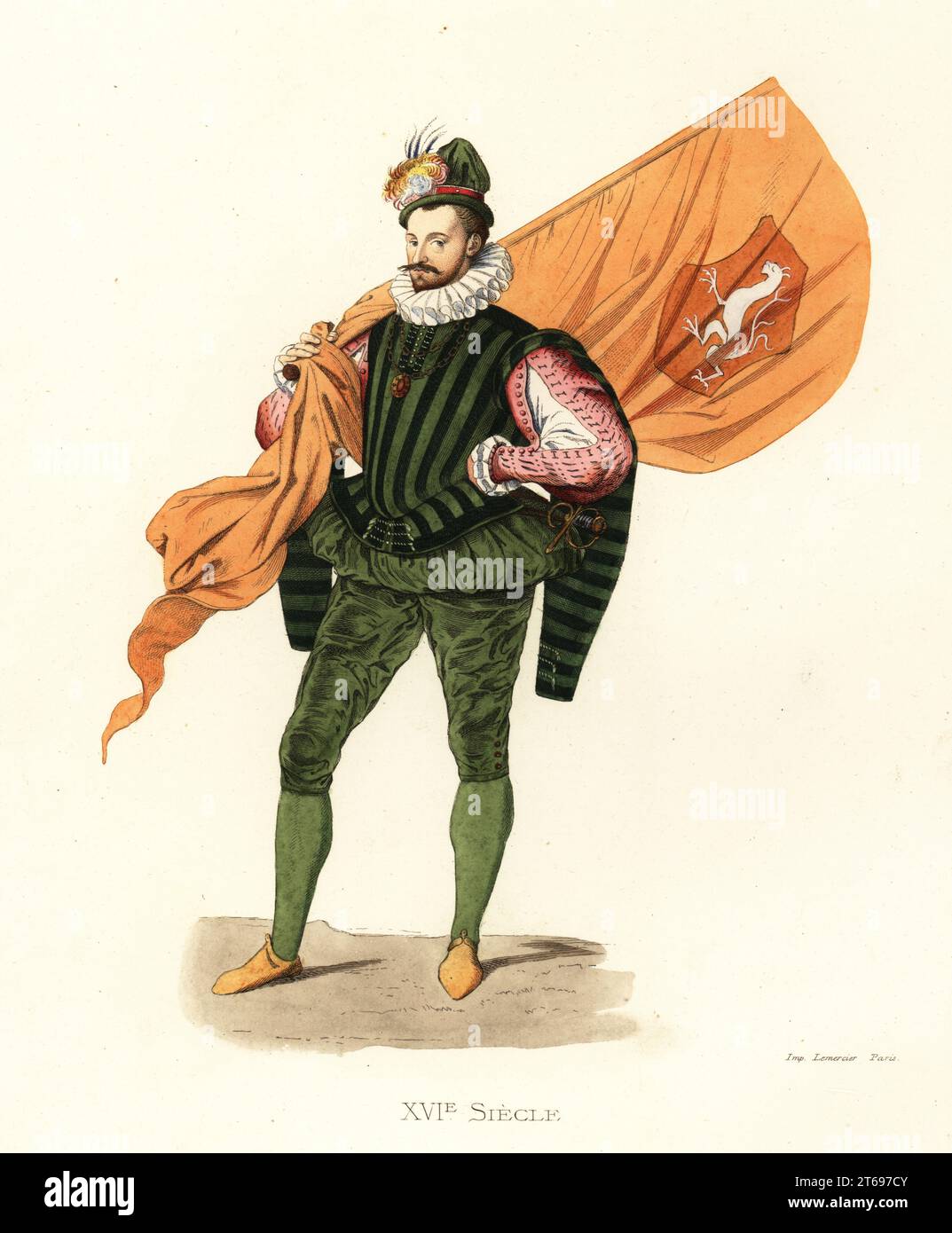 German noble standard-bearer, 16th century. He wears a green doublet in silk and velvet, justaucorps, silk breeches, slashed scarlet sleeves, muslin ruff collar. Allemagne, Porte-Enseigne. After an oil painting of the era. Handcolored lithograph after an illustration by Edmond Lechevallier-Chevignard from Georges Duplessis's Costumes historiques des XVIe, XVIIe et XVIIIe siecles (Historical costumes of the 16th, 17th and 18th centuries), Paris, 1867. Edmond Lechevallier-Chevignard was an artist, book illustrator, and interior designer. Stock Photohttps://www.alamy.com/image-license-details/?v=1https://www.alamy.com/german-noble-standard-bearer-16th-century-he-wears-a-green-doublet-in-silk-and-velvet-justaucorps-silk-breeches-slashed-scarlet-sleeves-muslin-ruff-collar-allemagne-porte-enseigne-after-an-oil-painting-of-the-era-handcolored-lithograph-after-an-illustration-by-edmond-lechevallier-chevignard-from-georges-duplessiss-costumes-historiques-des-xvie-xviie-et-xviiie-siecles-historical-costumes-of-the-16th-17th-and-18th-centuries-paris-1867-edmond-lechevallier-chevignard-was-an-artist-book-illustrator-and-interior-designer-image571833499.html
German noble standard-bearer, 16th century. He wears a green doublet in silk and velvet, justaucorps, silk breeches, slashed scarlet sleeves, muslin ruff collar. Allemagne, Porte-Enseigne. After an oil painting of the era. Handcolored lithograph after an illustration by Edmond Lechevallier-Chevignard from Georges Duplessis's Costumes historiques des XVIe, XVIIe et XVIIIe siecles (Historical costumes of the 16th, 17th and 18th centuries), Paris, 1867. Edmond Lechevallier-Chevignard was an artist, book illustrator, and interior designer. Stock Photohttps://www.alamy.com/image-license-details/?v=1https://www.alamy.com/german-noble-standard-bearer-16th-century-he-wears-a-green-doublet-in-silk-and-velvet-justaucorps-silk-breeches-slashed-scarlet-sleeves-muslin-ruff-collar-allemagne-porte-enseigne-after-an-oil-painting-of-the-era-handcolored-lithograph-after-an-illustration-by-edmond-lechevallier-chevignard-from-georges-duplessiss-costumes-historiques-des-xvie-xviie-et-xviiie-siecles-historical-costumes-of-the-16th-17th-and-18th-centuries-paris-1867-edmond-lechevallier-chevignard-was-an-artist-book-illustrator-and-interior-designer-image571833499.htmlRM2T697CY–German noble standard-bearer, 16th century. He wears a green doublet in silk and velvet, justaucorps, silk breeches, slashed scarlet sleeves, muslin ruff collar. Allemagne, Porte-Enseigne. After an oil painting of the era. Handcolored lithograph after an illustration by Edmond Lechevallier-Chevignard from Georges Duplessis's Costumes historiques des XVIe, XVIIe et XVIIIe siecles (Historical costumes of the 16th, 17th and 18th centuries), Paris, 1867. Edmond Lechevallier-Chevignard was an artist, book illustrator, and interior designer.
 Sir John Coke (1563-1644), MP, Staunch royalist and Secretary of State to King Charles I of England prior to the English Civil War, during the period from March 1629 to April 1640 when the king ruled without Parliament. One of Coke's sons supported Parliament and the other the King in the English Civil War. Engraving created in the 1700s by English engraver and artist, John Sturt (1658-1730). Stock Photohttps://www.alamy.com/image-license-details/?v=1https://www.alamy.com/sir-john-coke-1563-1644-mp-staunch-royalist-and-secretary-of-state-to-king-charles-i-of-england-prior-to-the-english-civil-war-during-the-period-from-march-1629-to-april-1640-when-the-king-ruled-without-parliament-one-of-cokes-sons-supported-parliament-and-the-other-the-king-in-the-english-civil-war-engraving-created-in-the-1700s-by-english-engraver-and-artist-john-sturt-1658-1730-image350572293.html
Sir John Coke (1563-1644), MP, Staunch royalist and Secretary of State to King Charles I of England prior to the English Civil War, during the period from March 1629 to April 1640 when the king ruled without Parliament. One of Coke's sons supported Parliament and the other the King in the English Civil War. Engraving created in the 1700s by English engraver and artist, John Sturt (1658-1730). Stock Photohttps://www.alamy.com/image-license-details/?v=1https://www.alamy.com/sir-john-coke-1563-1644-mp-staunch-royalist-and-secretary-of-state-to-king-charles-i-of-england-prior-to-the-english-civil-war-during-the-period-from-march-1629-to-april-1640-when-the-king-ruled-without-parliament-one-of-cokes-sons-supported-parliament-and-the-other-the-king-in-the-english-civil-war-engraving-created-in-the-1700s-by-english-engraver-and-artist-john-sturt-1658-1730-image350572293.htmlRF2BA9XF1–Sir John Coke (1563-1644), MP, Staunch royalist and Secretary of State to King Charles I of England prior to the English Civil War, during the period from March 1629 to April 1640 when the king ruled without Parliament. One of Coke's sons supported Parliament and the other the King in the English Civil War. Engraving created in the 1700s by English engraver and artist, John Sturt (1658-1730).
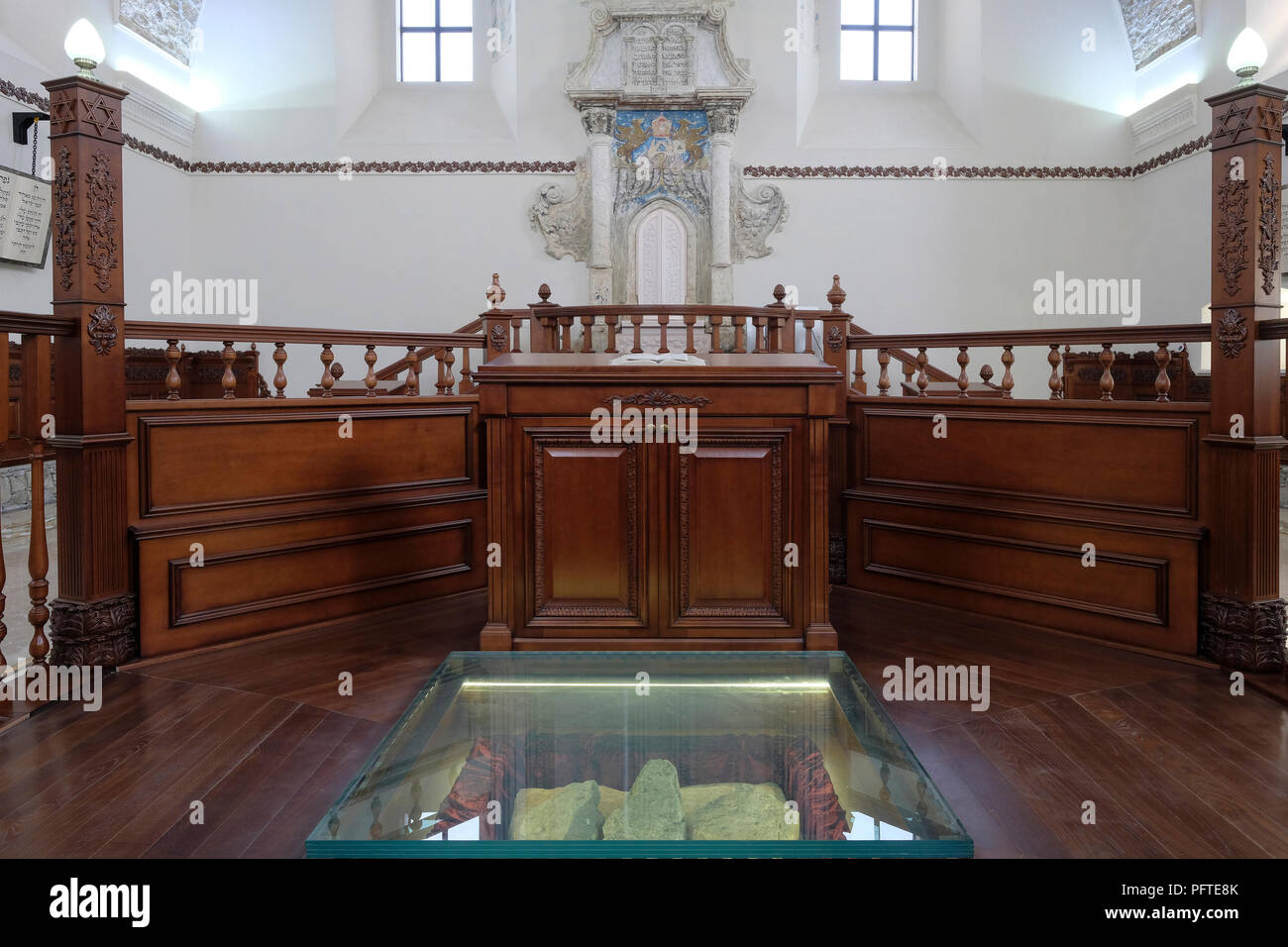 Interior of the renovated 17th century synagogue in the town of Sataniv which was once home to a large Jewish community and was annihilated, brutally, by the Germans during the Second World War in the Horodok Raion, Khmelnytskyi Oblast, Ukraine. Stock Photohttps://www.alamy.com/image-license-details/?v=1https://www.alamy.com/interior-of-the-renovated-17th-century-synagogue-in-the-town-of-sataniv-which-was-once-home-to-a-large-jewish-community-and-was-annihilated-brutally-by-the-germans-during-the-second-world-war-in-the-horodok-raion-khmelnytskyi-oblast-ukraine-image216282323.html
Interior of the renovated 17th century synagogue in the town of Sataniv which was once home to a large Jewish community and was annihilated, brutally, by the Germans during the Second World War in the Horodok Raion, Khmelnytskyi Oblast, Ukraine. Stock Photohttps://www.alamy.com/image-license-details/?v=1https://www.alamy.com/interior-of-the-renovated-17th-century-synagogue-in-the-town-of-sataniv-which-was-once-home-to-a-large-jewish-community-and-was-annihilated-brutally-by-the-germans-during-the-second-world-war-in-the-horodok-raion-khmelnytskyi-oblast-ukraine-image216282323.htmlRMPFTE8K–Interior of the renovated 17th century synagogue in the town of Sataniv which was once home to a large Jewish community and was annihilated, brutally, by the Germans during the Second World War in the Horodok Raion, Khmelnytskyi Oblast, Ukraine.
 Usti Nad Labem, Czech Republic. 17th Nov, 2021. Opening of permanent exhibition Our Germans in the presence of guests from Czechia and Germany was held on November 17, 2021, in Usti nad Labem, Czech Republic. Exhibition highlights history of Czech-German coexistence in territory of current Czech Republic from Middle Ages until 20th century. Credit: Ondrej Hajek/CTK Photo/Alamy Live News Stock Photohttps://www.alamy.com/image-license-details/?v=1https://www.alamy.com/usti-nad-labem-czech-republic-17th-nov-2021-opening-of-permanent-exhibition-our-germans-in-the-presence-of-guests-from-czechia-and-germany-was-held-on-november-17-2021-in-usti-nad-labem-czech-republic-exhibition-highlights-history-of-czech-german-coexistence-in-territory-of-current-czech-republic-from-middle-ages-until-20th-century-credit-ondrej-hajekctk-photoalamy-live-news-image451651447.html
Usti Nad Labem, Czech Republic. 17th Nov, 2021. Opening of permanent exhibition Our Germans in the presence of guests from Czechia and Germany was held on November 17, 2021, in Usti nad Labem, Czech Republic. Exhibition highlights history of Czech-German coexistence in territory of current Czech Republic from Middle Ages until 20th century. Credit: Ondrej Hajek/CTK Photo/Alamy Live News Stock Photohttps://www.alamy.com/image-license-details/?v=1https://www.alamy.com/usti-nad-labem-czech-republic-17th-nov-2021-opening-of-permanent-exhibition-our-germans-in-the-presence-of-guests-from-czechia-and-germany-was-held-on-november-17-2021-in-usti-nad-labem-czech-republic-exhibition-highlights-history-of-czech-german-coexistence-in-territory-of-current-czech-republic-from-middle-ages-until-20th-century-credit-ondrej-hajekctk-photoalamy-live-news-image451651447.htmlRM2H6PE0R–Usti Nad Labem, Czech Republic. 17th Nov, 2021. Opening of permanent exhibition Our Germans in the presence of guests from Czechia and Germany was held on November 17, 2021, in Usti nad Labem, Czech Republic. Exhibition highlights history of Czech-German coexistence in territory of current Czech Republic from Middle Ages until 20th century. Credit: Ondrej Hajek/CTK Photo/Alamy Live News
 Civilis Separates Germans and Dutch Troops, Publshed 1612. From The War of the Romans Against the Batavians, pl. 22. Stock Photohttps://www.alamy.com/image-license-details/?v=1https://www.alamy.com/civilis-separates-germans-and-dutch-troops-publshed-1612-from-the-war-of-the-romans-against-the-batavians-pl-22-image571890852.html
Civilis Separates Germans and Dutch Troops, Publshed 1612. From The War of the Romans Against the Batavians, pl. 22. Stock Photohttps://www.alamy.com/image-license-details/?v=1https://www.alamy.com/civilis-separates-germans-and-dutch-troops-publshed-1612-from-the-war-of-the-romans-against-the-batavians-pl-22-image571890852.htmlRM2T6BTH8–Civilis Separates Germans and Dutch Troops, Publshed 1612. From The War of the Romans Against the Batavians, pl. 22.
 The figures represented here are all Germans in the 1600s. From left to right, they are: four man of rank, a Protestant clergyman, a man of rank, a woman of rank in mourning (1650-1700), and a man of rank. The illustration dates to 1882. Stock Photohttps://www.alamy.com/image-license-details/?v=1https://www.alamy.com/stock-photo-the-figures-represented-here-are-all-germans-in-the-1600s-from-left-115436869.html
The figures represented here are all Germans in the 1600s. From left to right, they are: four man of rank, a Protestant clergyman, a man of rank, a woman of rank in mourning (1650-1700), and a man of rank. The illustration dates to 1882. Stock Photohttps://www.alamy.com/image-license-details/?v=1https://www.alamy.com/stock-photo-the-figures-represented-here-are-all-germans-in-the-1600s-from-left-115436869.htmlRFGKPGW9–The figures represented here are all Germans in the 1600s. From left to right, they are: four man of rank, a Protestant clergyman, a man of rank, a woman of rank in mourning (1650-1700), and a man of rank. The illustration dates to 1882.
 San Antonio de los Alemanes Church. Madrid, Spain. Stock Photohttps://www.alamy.com/image-license-details/?v=1https://www.alamy.com/san-antonio-de-los-alemanes-church-madrid-spain-image572953406.html
San Antonio de los Alemanes Church. Madrid, Spain. Stock Photohttps://www.alamy.com/image-license-details/?v=1https://www.alamy.com/san-antonio-de-los-alemanes-church-madrid-spain-image572953406.htmlRF2T847WJ–San Antonio de los Alemanes Church. Madrid, Spain.
 'Benediktbeuern was the first Benedictine monastery in the northern Alpine foothills in 739/740. Its monastery church was consecrated to Boniface, the ''Apostle of the Germans'' in 746. The Baroque monastery church (1680-86) contains vault frescoes with scenes from the history of salvation (1683/84) by Hans Georg Asam. In addition to the choir of the monastery church, Johann Michael Fischer built the splendidly equipped Anastasiakapelle (yellow) in 1751-58. In the monastery library was found the medieval song collection ''Carmina Burana''. (undated photo)' Stock Photohttps://www.alamy.com/image-license-details/?v=1https://www.alamy.com/benediktbeuern-was-the-first-benedictine-monastery-in-the-northern-alpine-foothills-in-739740-its-monastery-church-was-consecrated-to-boniface-the-apostle-of-the-germans-in-746-the-baroque-monastery-church-1680-86-contains-vault-frescoes-with-scenes-from-the-history-of-salvation-168384-by-hans-georg-asam-in-addition-to-the-choir-of-the-monastery-church-johann-michael-fischer-built-the-splendidly-equipped-anastasiakapelle-yellow-in-1751-58-in-the-monastery-library-was-found-the-medieval-song-collection-carmina-burana-undated-photo-image550699580.html
'Benediktbeuern was the first Benedictine monastery in the northern Alpine foothills in 739/740. Its monastery church was consecrated to Boniface, the ''Apostle of the Germans'' in 746. The Baroque monastery church (1680-86) contains vault frescoes with scenes from the history of salvation (1683/84) by Hans Georg Asam. In addition to the choir of the monastery church, Johann Michael Fischer built the splendidly equipped Anastasiakapelle (yellow) in 1751-58. In the monastery library was found the medieval song collection ''Carmina Burana''. (undated photo)' Stock Photohttps://www.alamy.com/image-license-details/?v=1https://www.alamy.com/benediktbeuern-was-the-first-benedictine-monastery-in-the-northern-alpine-foothills-in-739740-its-monastery-church-was-consecrated-to-boniface-the-apostle-of-the-germans-in-746-the-baroque-monastery-church-1680-86-contains-vault-frescoes-with-scenes-from-the-history-of-salvation-168384-by-hans-georg-asam-in-addition-to-the-choir-of-the-monastery-church-johann-michael-fischer-built-the-splendidly-equipped-anastasiakapelle-yellow-in-1751-58-in-the-monastery-library-was-found-the-medieval-song-collection-carmina-burana-undated-photo-image550699580.htmlRM2PYXEX4–'Benediktbeuern was the first Benedictine monastery in the northern Alpine foothills in 739/740. Its monastery church was consecrated to Boniface, the ''Apostle of the Germans'' in 746. The Baroque monastery church (1680-86) contains vault frescoes with scenes from the history of salvation (1683/84) by Hans Georg Asam. In addition to the choir of the monastery church, Johann Michael Fischer built the splendidly equipped Anastasiakapelle (yellow) in 1751-58. In the monastery library was found the medieval song collection ''Carmina Burana''. (undated photo)'
 Gregor Horstius, German Physician and Anatomist Stock Photohttps://www.alamy.com/image-license-details/?v=1https://www.alamy.com/stock-photo-gregor-horstius-german-physician-and-anatomist-135087502.html
Gregor Horstius, German Physician and Anatomist Stock Photohttps://www.alamy.com/image-license-details/?v=1https://www.alamy.com/stock-photo-gregor-horstius-german-physician-and-anatomist-135087502.htmlRMHRNNDJ–Gregor Horstius, German Physician and Anatomist
 German Landsknechte drummer, 16th century. In blue felt hat with plumes, slashed buff justaucorps, puff sleeves adorned with ribbons, parti-coloured breeches and hose. Allemagne, Tambourin. After a colour woodcut by Hans Guldenmundt. Handcolored lithograph after an illustration by Edmond Lechevallier-Chevignard from Georges Duplessis's Costumes historiques des XVIe, XVIIe et XVIIIe siecles (Historical costumes of the 16th, 17th and 18th centuries), Paris, 1867. Edmond Lechevallier-Chevignard was an artist, book illustrator, and interior designer. Stock Photohttps://www.alamy.com/image-license-details/?v=1https://www.alamy.com/german-landsknechte-drummer-16th-century-in-blue-felt-hat-with-plumes-slashed-buff-justaucorps-puff-sleeves-adorned-with-ribbons-parti-coloured-breeches-and-hose-allemagne-tambourin-after-a-colour-woodcut-by-hans-guldenmundt-handcolored-lithograph-after-an-illustration-by-edmond-lechevallier-chevignard-from-georges-duplessiss-costumes-historiques-des-xvie-xviie-et-xviiie-siecles-historical-costumes-of-the-16th-17th-and-18th-centuries-paris-1867-edmond-lechevallier-chevignard-was-an-artist-book-illustrator-and-interior-designer-image571912369.html
German Landsknechte drummer, 16th century. In blue felt hat with plumes, slashed buff justaucorps, puff sleeves adorned with ribbons, parti-coloured breeches and hose. Allemagne, Tambourin. After a colour woodcut by Hans Guldenmundt. Handcolored lithograph after an illustration by Edmond Lechevallier-Chevignard from Georges Duplessis's Costumes historiques des XVIe, XVIIe et XVIIIe siecles (Historical costumes of the 16th, 17th and 18th centuries), Paris, 1867. Edmond Lechevallier-Chevignard was an artist, book illustrator, and interior designer. Stock Photohttps://www.alamy.com/image-license-details/?v=1https://www.alamy.com/german-landsknechte-drummer-16th-century-in-blue-felt-hat-with-plumes-slashed-buff-justaucorps-puff-sleeves-adorned-with-ribbons-parti-coloured-breeches-and-hose-allemagne-tambourin-after-a-colour-woodcut-by-hans-guldenmundt-handcolored-lithograph-after-an-illustration-by-edmond-lechevallier-chevignard-from-georges-duplessiss-costumes-historiques-des-xvie-xviie-et-xviiie-siecles-historical-costumes-of-the-16th-17th-and-18th-centuries-paris-1867-edmond-lechevallier-chevignard-was-an-artist-book-illustrator-and-interior-designer-image571912369.htmlRM2T6CT1N–German Landsknechte drummer, 16th century. In blue felt hat with plumes, slashed buff justaucorps, puff sleeves adorned with ribbons, parti-coloured breeches and hose. Allemagne, Tambourin. After a colour woodcut by Hans Guldenmundt. Handcolored lithograph after an illustration by Edmond Lechevallier-Chevignard from Georges Duplessis's Costumes historiques des XVIe, XVIIe et XVIIIe siecles (Historical costumes of the 16th, 17th and 18th centuries), Paris, 1867. Edmond Lechevallier-Chevignard was an artist, book illustrator, and interior designer.
 Interior of the renovated 17th century synagogue in the town of Sataniv which was once home to a large Jewish community and was annihilated, brutally, by the Germans during the Second World War in the Horodok Raion, Khmelnytskyi Oblast, Ukraine. Stock Photohttps://www.alamy.com/image-license-details/?v=1https://www.alamy.com/interior-of-the-renovated-17th-century-synagogue-in-the-town-of-sataniv-which-was-once-home-to-a-large-jewish-community-and-was-annihilated-brutally-by-the-germans-during-the-second-world-war-in-the-horodok-raion-khmelnytskyi-oblast-ukraine-image216282312.html
Interior of the renovated 17th century synagogue in the town of Sataniv which was once home to a large Jewish community and was annihilated, brutally, by the Germans during the Second World War in the Horodok Raion, Khmelnytskyi Oblast, Ukraine. Stock Photohttps://www.alamy.com/image-license-details/?v=1https://www.alamy.com/interior-of-the-renovated-17th-century-synagogue-in-the-town-of-sataniv-which-was-once-home-to-a-large-jewish-community-and-was-annihilated-brutally-by-the-germans-during-the-second-world-war-in-the-horodok-raion-khmelnytskyi-oblast-ukraine-image216282312.htmlRMPFTE88–Interior of the renovated 17th century synagogue in the town of Sataniv which was once home to a large Jewish community and was annihilated, brutally, by the Germans during the Second World War in the Horodok Raion, Khmelnytskyi Oblast, Ukraine.
 Usti Nad Labem, Czech Republic. 17th Nov, 2021. Opening of permanent exhibition Our Germans in the presence of guests from Czechia and Germany was held on November 17, 2021, in Usti nad Labem, Czech Republic. Exhibition highlights history of Czech-German coexistence in territory of current Czech Republic from Middle Ages until 20th century. Credit: Ondrej Hajek/CTK Photo/Alamy Live News Stock Photohttps://www.alamy.com/image-license-details/?v=1https://www.alamy.com/usti-nad-labem-czech-republic-17th-nov-2021-opening-of-permanent-exhibition-our-germans-in-the-presence-of-guests-from-czechia-and-germany-was-held-on-november-17-2021-in-usti-nad-labem-czech-republic-exhibition-highlights-history-of-czech-german-coexistence-in-territory-of-current-czech-republic-from-middle-ages-until-20th-century-credit-ondrej-hajekctk-photoalamy-live-news-image451651452.html
Usti Nad Labem, Czech Republic. 17th Nov, 2021. Opening of permanent exhibition Our Germans in the presence of guests from Czechia and Germany was held on November 17, 2021, in Usti nad Labem, Czech Republic. Exhibition highlights history of Czech-German coexistence in territory of current Czech Republic from Middle Ages until 20th century. Credit: Ondrej Hajek/CTK Photo/Alamy Live News Stock Photohttps://www.alamy.com/image-license-details/?v=1https://www.alamy.com/usti-nad-labem-czech-republic-17th-nov-2021-opening-of-permanent-exhibition-our-germans-in-the-presence-of-guests-from-czechia-and-germany-was-held-on-november-17-2021-in-usti-nad-labem-czech-republic-exhibition-highlights-history-of-czech-german-coexistence-in-territory-of-current-czech-republic-from-middle-ages-until-20th-century-credit-ondrej-hajekctk-photoalamy-live-news-image451651452.htmlRM2H6PE10–Usti Nad Labem, Czech Republic. 17th Nov, 2021. Opening of permanent exhibition Our Germans in the presence of guests from Czechia and Germany was held on November 17, 2021, in Usti nad Labem, Czech Republic. Exhibition highlights history of Czech-German coexistence in territory of current Czech Republic from Middle Ages until 20th century. Credit: Ondrej Hajek/CTK Photo/Alamy Live News
 Dutch and Germans Attack the Roman Camp and Capture Cerialis' Boat, Publshed 1612. From The War of the Romans Against the Batavians, pl. 32. Stock Photohttps://www.alamy.com/image-license-details/?v=1https://www.alamy.com/dutch-and-germans-attack-the-roman-camp-and-capture-cerialis-boat-publshed-1612-from-the-war-of-the-romans-against-the-batavians-pl-32-image571890844.html
Dutch and Germans Attack the Roman Camp and Capture Cerialis' Boat, Publshed 1612. From The War of the Romans Against the Batavians, pl. 32. Stock Photohttps://www.alamy.com/image-license-details/?v=1https://www.alamy.com/dutch-and-germans-attack-the-roman-camp-and-capture-cerialis-boat-publshed-1612-from-the-war-of-the-romans-against-the-batavians-pl-32-image571890844.htmlRM2T6BTH0–Dutch and Germans Attack the Roman Camp and Capture Cerialis' Boat, Publshed 1612. From The War of the Romans Against the Batavians, pl. 32.
 The figures represented here are all Germans in the 1600s. From left to right, they are: a man of rank, a woman of rank in mourning (1600-1650), and a man of rank (around 1650). The illustration dates to 1882. Stock Photohttps://www.alamy.com/image-license-details/?v=1https://www.alamy.com/stock-photo-the-figures-represented-here-are-all-germans-in-the-1600s-from-left-118763367.html
The figures represented here are all Germans in the 1600s. From left to right, they are: a man of rank, a woman of rank in mourning (1600-1650), and a man of rank (around 1650). The illustration dates to 1882. Stock Photohttps://www.alamy.com/image-license-details/?v=1https://www.alamy.com/stock-photo-the-figures-represented-here-are-all-germans-in-the-1600s-from-left-118763367.htmlRFGW63TR–The figures represented here are all Germans in the 1600s. From left to right, they are: a man of rank, a woman of rank in mourning (1600-1650), and a man of rank (around 1650). The illustration dates to 1882.
 San Antonio de los Alemanes Church. Madrid, Spain. Stock Photohttps://www.alamy.com/image-license-details/?v=1https://www.alamy.com/san-antonio-de-los-alemanes-church-madrid-spain-image572953071.html
San Antonio de los Alemanes Church. Madrid, Spain. Stock Photohttps://www.alamy.com/image-license-details/?v=1https://www.alamy.com/san-antonio-de-los-alemanes-church-madrid-spain-image572953071.htmlRF2T847DK–San Antonio de los Alemanes Church. Madrid, Spain.
 Gregor Horstius, German Physician and Anatomist Stock Photohttps://www.alamy.com/image-license-details/?v=1https://www.alamy.com/stock-photo-gregor-horstius-german-physician-and-anatomist-135092501.html
Gregor Horstius, German Physician and Anatomist Stock Photohttps://www.alamy.com/image-license-details/?v=1https://www.alamy.com/stock-photo-gregor-horstius-german-physician-and-anatomist-135092501.htmlRMHRNYT5–Gregor Horstius, German Physician and Anatomist
 Valtein, GermanLandsknechte halberdier, 16th century. Swordsman who fought in Denmark. In plumed hat, gold full-sleeved doublet, striped stockings, garters, carrying a sword and halberd. Hallebardier. After a print by Hans Guldenmundt. Handcolored lithograph after an illustration by Edmond Lechevallier-Chevignard from Georges Duplessis's Costumes historiques des XVIe, XVIIe et XVIIIe siecles (Historical costumes of the 16th, 17th and 18th centuries), Paris, 1867. Edmond Lechevallier-Chevignard was an artist, book illustrator, and interior designer. Stock Photohttps://www.alamy.com/image-license-details/?v=1https://www.alamy.com/valtein-germanlandsknechte-halberdier-16th-century-swordsman-who-fought-in-denmark-in-plumed-hat-gold-full-sleeved-doublet-striped-stockings-garters-carrying-a-sword-and-halberd-hallebardier-after-a-print-by-hans-guldenmundt-handcolored-lithograph-after-an-illustration-by-edmond-lechevallier-chevignard-from-georges-duplessiss-costumes-historiques-des-xvie-xviie-et-xviiie-siecles-historical-costumes-of-the-16th-17th-and-18th-centuries-paris-1867-edmond-lechevallier-chevignard-was-an-artist-book-illustrator-and-interior-designer-image571825330.html
Valtein, GermanLandsknechte halberdier, 16th century. Swordsman who fought in Denmark. In plumed hat, gold full-sleeved doublet, striped stockings, garters, carrying a sword and halberd. Hallebardier. After a print by Hans Guldenmundt. Handcolored lithograph after an illustration by Edmond Lechevallier-Chevignard from Georges Duplessis's Costumes historiques des XVIe, XVIIe et XVIIIe siecles (Historical costumes of the 16th, 17th and 18th centuries), Paris, 1867. Edmond Lechevallier-Chevignard was an artist, book illustrator, and interior designer. Stock Photohttps://www.alamy.com/image-license-details/?v=1https://www.alamy.com/valtein-germanlandsknechte-halberdier-16th-century-swordsman-who-fought-in-denmark-in-plumed-hat-gold-full-sleeved-doublet-striped-stockings-garters-carrying-a-sword-and-halberd-hallebardier-after-a-print-by-hans-guldenmundt-handcolored-lithograph-after-an-illustration-by-edmond-lechevallier-chevignard-from-georges-duplessiss-costumes-historiques-des-xvie-xviie-et-xviiie-siecles-historical-costumes-of-the-16th-17th-and-18th-centuries-paris-1867-edmond-lechevallier-chevignard-was-an-artist-book-illustrator-and-interior-designer-image571825330.htmlRM2T68W16–Valtein, GermanLandsknechte halberdier, 16th century. Swordsman who fought in Denmark. In plumed hat, gold full-sleeved doublet, striped stockings, garters, carrying a sword and halberd. Hallebardier. After a print by Hans Guldenmundt. Handcolored lithograph after an illustration by Edmond Lechevallier-Chevignard from Georges Duplessis's Costumes historiques des XVIe, XVIIe et XVIIIe siecles (Historical costumes of the 16th, 17th and 18th centuries), Paris, 1867. Edmond Lechevallier-Chevignard was an artist, book illustrator, and interior designer.
 Interior of the renovated 17th century synagogue in the town of Sataniv which was once home to a large Jewish community and was annihilated, brutally, by the Germans during the Second World War in the Horodok Raion, Khmelnytskyi Oblast, Ukraine. Stock Photohttps://www.alamy.com/image-license-details/?v=1https://www.alamy.com/interior-of-the-renovated-17th-century-synagogue-in-the-town-of-sataniv-which-was-once-home-to-a-large-jewish-community-and-was-annihilated-brutally-by-the-germans-during-the-second-world-war-in-the-horodok-raion-khmelnytskyi-oblast-ukraine-image216282142.html
Interior of the renovated 17th century synagogue in the town of Sataniv which was once home to a large Jewish community and was annihilated, brutally, by the Germans during the Second World War in the Horodok Raion, Khmelnytskyi Oblast, Ukraine. Stock Photohttps://www.alamy.com/image-license-details/?v=1https://www.alamy.com/interior-of-the-renovated-17th-century-synagogue-in-the-town-of-sataniv-which-was-once-home-to-a-large-jewish-community-and-was-annihilated-brutally-by-the-germans-during-the-second-world-war-in-the-horodok-raion-khmelnytskyi-oblast-ukraine-image216282142.htmlRMPFTE26–Interior of the renovated 17th century synagogue in the town of Sataniv which was once home to a large Jewish community and was annihilated, brutally, by the Germans during the Second World War in the Horodok Raion, Khmelnytskyi Oblast, Ukraine.
 Usti Nad Labem, Czech Republic. 17th Nov, 2021. Opening of permanent exhibition Our Germans in the presence of guests from Czechia and Germany was held on November 17, 2021, in Usti nad Labem, Czech Republic. Exhibition highlights history of Czech-German coexistence in territory of current Czech Republic from Middle Ages until 20th century. Credit: Ondrej Hajek/CTK Photo/Alamy Live News Stock Photohttps://www.alamy.com/image-license-details/?v=1https://www.alamy.com/usti-nad-labem-czech-republic-17th-nov-2021-opening-of-permanent-exhibition-our-germans-in-the-presence-of-guests-from-czechia-and-germany-was-held-on-november-17-2021-in-usti-nad-labem-czech-republic-exhibition-highlights-history-of-czech-german-coexistence-in-territory-of-current-czech-republic-from-middle-ages-until-20th-century-credit-ondrej-hajekctk-photoalamy-live-news-image451651508.html
Usti Nad Labem, Czech Republic. 17th Nov, 2021. Opening of permanent exhibition Our Germans in the presence of guests from Czechia and Germany was held on November 17, 2021, in Usti nad Labem, Czech Republic. Exhibition highlights history of Czech-German coexistence in territory of current Czech Republic from Middle Ages until 20th century. Credit: Ondrej Hajek/CTK Photo/Alamy Live News Stock Photohttps://www.alamy.com/image-license-details/?v=1https://www.alamy.com/usti-nad-labem-czech-republic-17th-nov-2021-opening-of-permanent-exhibition-our-germans-in-the-presence-of-guests-from-czechia-and-germany-was-held-on-november-17-2021-in-usti-nad-labem-czech-republic-exhibition-highlights-history-of-czech-german-coexistence-in-territory-of-current-czech-republic-from-middle-ages-until-20th-century-credit-ondrej-hajekctk-photoalamy-live-news-image451651508.htmlRM2H6PE30–Usti Nad Labem, Czech Republic. 17th Nov, 2021. Opening of permanent exhibition Our Germans in the presence of guests from Czechia and Germany was held on November 17, 2021, in Usti nad Labem, Czech Republic. Exhibition highlights history of Czech-German coexistence in territory of current Czech Republic from Middle Ages until 20th century. Credit: Ondrej Hajek/CTK Photo/Alamy Live News
 The figures represented here are all Germans in the 1600s. From left to right, they are: a man of rank, a woman of rank (1600-1650), a man of rank (around 1650), a woman of rank in mourning (1650-1700), and a man of rank (1690-1700). The illustration dates to 1882. Stock Photohttps://www.alamy.com/image-license-details/?v=1https://www.alamy.com/stock-photo-the-figures-represented-here-are-all-germans-in-the-1600s-from-left-118763365.html
The figures represented here are all Germans in the 1600s. From left to right, they are: a man of rank, a woman of rank (1600-1650), a man of rank (around 1650), a woman of rank in mourning (1650-1700), and a man of rank (1690-1700). The illustration dates to 1882. Stock Photohttps://www.alamy.com/image-license-details/?v=1https://www.alamy.com/stock-photo-the-figures-represented-here-are-all-germans-in-the-1600s-from-left-118763365.htmlRFGW63TN–The figures represented here are all Germans in the 1600s. From left to right, they are: a man of rank, a woman of rank (1600-1650), a man of rank (around 1650), a woman of rank in mourning (1650-1700), and a man of rank (1690-1700). The illustration dates to 1882.
 San Antonio de los Alemanes Church. Madrid, Spain. Stock Photohttps://www.alamy.com/image-license-details/?v=1https://www.alamy.com/san-antonio-de-los-alemanes-church-madrid-spain-image572953220.html
San Antonio de los Alemanes Church. Madrid, Spain. Stock Photohttps://www.alamy.com/image-license-details/?v=1https://www.alamy.com/san-antonio-de-los-alemanes-church-madrid-spain-image572953220.htmlRF2T847K0–San Antonio de los Alemanes Church. Madrid, Spain.
 Bathsua Reginald Makin, c.1600-1675, English woman teacher, linguist and feminist. Critic of woman's position in the domestic and public spheres in 17th-century England. Skilled in Greek, Latin, Hebrew, German, Spanish, French and Italian. Bathsua Makin Princip Elizab Latinis Graecis & Hebraeis. Fascimile from an almost unique print by William Marshall. Copperplate engraving from Samuel Woodburns Gallery of Rare Portraits Consisting of Original Plates, George Jones, 102 St Martins Lane, London, 1816. Stock Photohttps://www.alamy.com/image-license-details/?v=1https://www.alamy.com/bathsua-reginald-makin-c1600-1675-english-woman-teacher-linguist-and-feminist-critic-of-womans-position-in-the-domestic-and-public-spheres-in-17th-century-england-skilled-in-greek-latin-hebrew-german-spanish-french-and-italian-bathsua-makin-princip-elizab-latinis-graecis-hebraeis-fascimile-from-an-almost-unique-print-by-william-marshall-copperplate-engraving-from-samuel-woodburns-gallery-of-rare-portraits-consisting-of-original-plates-george-jones-102-st-martins-lane-london-1816-image571831939.html
Bathsua Reginald Makin, c.1600-1675, English woman teacher, linguist and feminist. Critic of woman's position in the domestic and public spheres in 17th-century England. Skilled in Greek, Latin, Hebrew, German, Spanish, French and Italian. Bathsua Makin Princip Elizab Latinis Graecis & Hebraeis. Fascimile from an almost unique print by William Marshall. Copperplate engraving from Samuel Woodburns Gallery of Rare Portraits Consisting of Original Plates, George Jones, 102 St Martins Lane, London, 1816. Stock Photohttps://www.alamy.com/image-license-details/?v=1https://www.alamy.com/bathsua-reginald-makin-c1600-1675-english-woman-teacher-linguist-and-feminist-critic-of-womans-position-in-the-domestic-and-public-spheres-in-17th-century-england-skilled-in-greek-latin-hebrew-german-spanish-french-and-italian-bathsua-makin-princip-elizab-latinis-graecis-hebraeis-fascimile-from-an-almost-unique-print-by-william-marshall-copperplate-engraving-from-samuel-woodburns-gallery-of-rare-portraits-consisting-of-original-plates-george-jones-102-st-martins-lane-london-1816-image571831939.htmlRM2T695D7–Bathsua Reginald Makin, c.1600-1675, English woman teacher, linguist and feminist. Critic of woman's position in the domestic and public spheres in 17th-century England. Skilled in Greek, Latin, Hebrew, German, Spanish, French and Italian. Bathsua Makin Princip Elizab Latinis Graecis & Hebraeis. Fascimile from an almost unique print by William Marshall. Copperplate engraving from Samuel Woodburns Gallery of Rare Portraits Consisting of Original Plates, George Jones, 102 St Martins Lane, London, 1816.
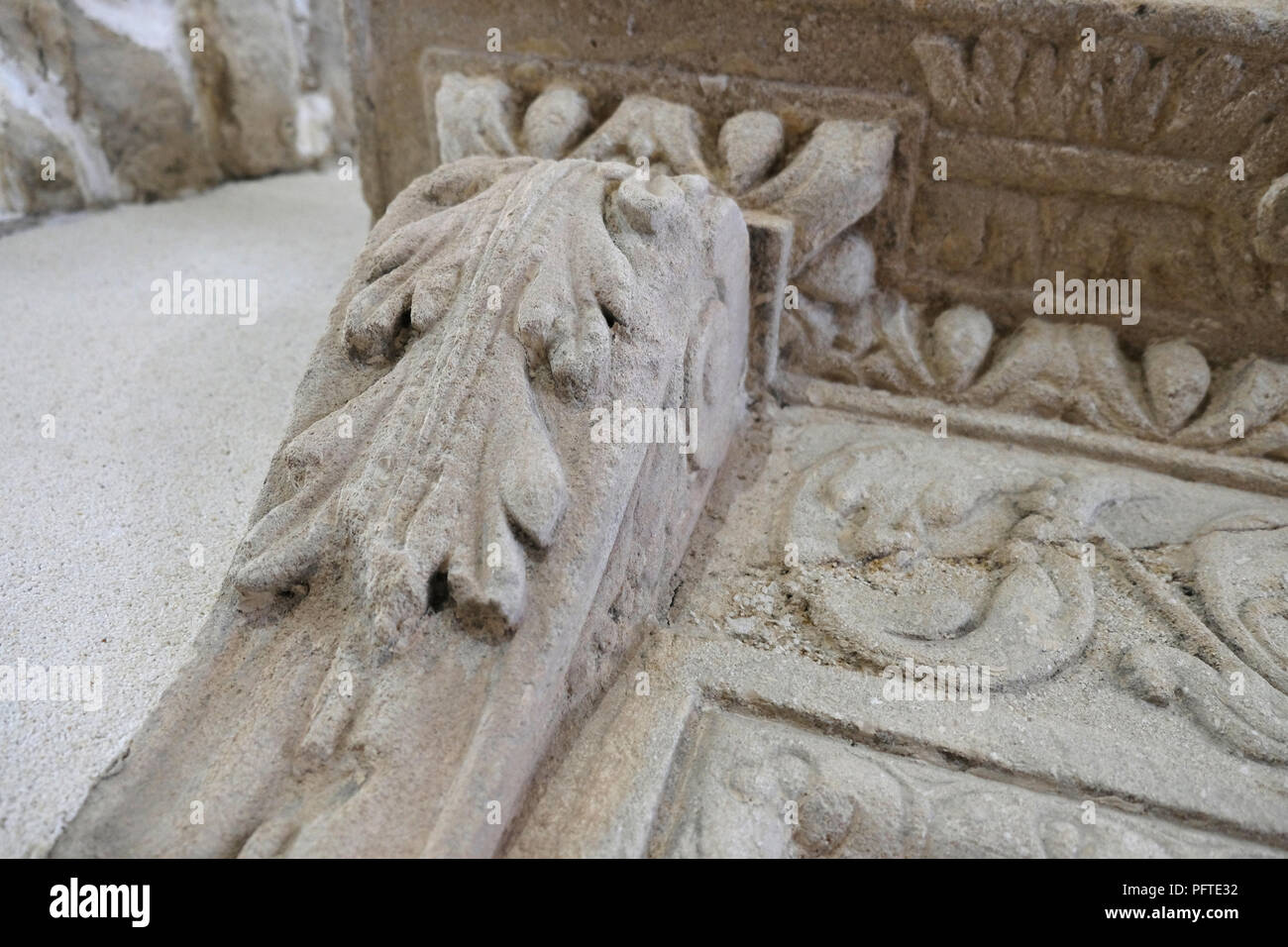 Remain of the original 17th century synagogue now renovated in the town of Sataniv which was once home to a large Jewish community and was annihilated, brutally, by the Germans during the Second World War in the Horodok Raion, Khmelnytskyi Oblast, Ukraine. Stock Photohttps://www.alamy.com/image-license-details/?v=1https://www.alamy.com/remain-of-the-original-17th-century-synagogue-now-renovated-in-the-town-of-sataniv-which-was-once-home-to-a-large-jewish-community-and-was-annihilated-brutally-by-the-germans-during-the-second-world-war-in-the-horodok-raion-khmelnytskyi-oblast-ukraine-image216282166.html
Remain of the original 17th century synagogue now renovated in the town of Sataniv which was once home to a large Jewish community and was annihilated, brutally, by the Germans during the Second World War in the Horodok Raion, Khmelnytskyi Oblast, Ukraine. Stock Photohttps://www.alamy.com/image-license-details/?v=1https://www.alamy.com/remain-of-the-original-17th-century-synagogue-now-renovated-in-the-town-of-sataniv-which-was-once-home-to-a-large-jewish-community-and-was-annihilated-brutally-by-the-germans-during-the-second-world-war-in-the-horodok-raion-khmelnytskyi-oblast-ukraine-image216282166.htmlRMPFTE32–Remain of the original 17th century synagogue now renovated in the town of Sataniv which was once home to a large Jewish community and was annihilated, brutally, by the Germans during the Second World War in the Horodok Raion, Khmelnytskyi Oblast, Ukraine.
 Usti Nad Labem, Czech Republic. 17th Nov, 2021. Opening of permanent exhibition Our Germans in the presence of guests from Czechia and Germany was held on November 17, 2021, in Usti nad Labem, Czech Republic. Exhibition highlights history of Czech-German coexistence in territory of current Czech Republic from Middle Ages until 20th century. Credit: Ondrej Hajek/CTK Photo/Alamy Live News Stock Photohttps://www.alamy.com/image-license-details/?v=1https://www.alamy.com/usti-nad-labem-czech-republic-17th-nov-2021-opening-of-permanent-exhibition-our-germans-in-the-presence-of-guests-from-czechia-and-germany-was-held-on-november-17-2021-in-usti-nad-labem-czech-republic-exhibition-highlights-history-of-czech-german-coexistence-in-territory-of-current-czech-republic-from-middle-ages-until-20th-century-credit-ondrej-hajekctk-photoalamy-live-news-image451651458.html
Usti Nad Labem, Czech Republic. 17th Nov, 2021. Opening of permanent exhibition Our Germans in the presence of guests from Czechia and Germany was held on November 17, 2021, in Usti nad Labem, Czech Republic. Exhibition highlights history of Czech-German coexistence in territory of current Czech Republic from Middle Ages until 20th century. Credit: Ondrej Hajek/CTK Photo/Alamy Live News Stock Photohttps://www.alamy.com/image-license-details/?v=1https://www.alamy.com/usti-nad-labem-czech-republic-17th-nov-2021-opening-of-permanent-exhibition-our-germans-in-the-presence-of-guests-from-czechia-and-germany-was-held-on-november-17-2021-in-usti-nad-labem-czech-republic-exhibition-highlights-history-of-czech-german-coexistence-in-territory-of-current-czech-republic-from-middle-ages-until-20th-century-credit-ondrej-hajekctk-photoalamy-live-news-image451651458.htmlRM2H6PE16–Usti Nad Labem, Czech Republic. 17th Nov, 2021. Opening of permanent exhibition Our Germans in the presence of guests from Czechia and Germany was held on November 17, 2021, in Usti nad Labem, Czech Republic. Exhibition highlights history of Czech-German coexistence in territory of current Czech Republic from Middle Ages until 20th century. Credit: Ondrej Hajek/CTK Photo/Alamy Live News
 The figure represented here is a German clergyman in the 1600s. The illustration dates to 1882. Stock Photohttps://www.alamy.com/image-license-details/?v=1https://www.alamy.com/stock-photo-the-figure-represented-here-is-a-german-clergyman-in-the-1600s-the-115436884.html
The figure represented here is a German clergyman in the 1600s. The illustration dates to 1882. Stock Photohttps://www.alamy.com/image-license-details/?v=1https://www.alamy.com/stock-photo-the-figure-represented-here-is-a-german-clergyman-in-the-1600s-the-115436884.htmlRFGKPGWT–The figure represented here is a German clergyman in the 1600s. The illustration dates to 1882.
 San Antonio de los Alemanes Church. Madrid, Spain. Stock Photohttps://www.alamy.com/image-license-details/?v=1https://www.alamy.com/san-antonio-de-los-alemanes-church-madrid-spain-image572953239.html
San Antonio de los Alemanes Church. Madrid, Spain. Stock Photohttps://www.alamy.com/image-license-details/?v=1https://www.alamy.com/san-antonio-de-los-alemanes-church-madrid-spain-image572953239.htmlRF2T847KK–San Antonio de los Alemanes Church. Madrid, Spain.
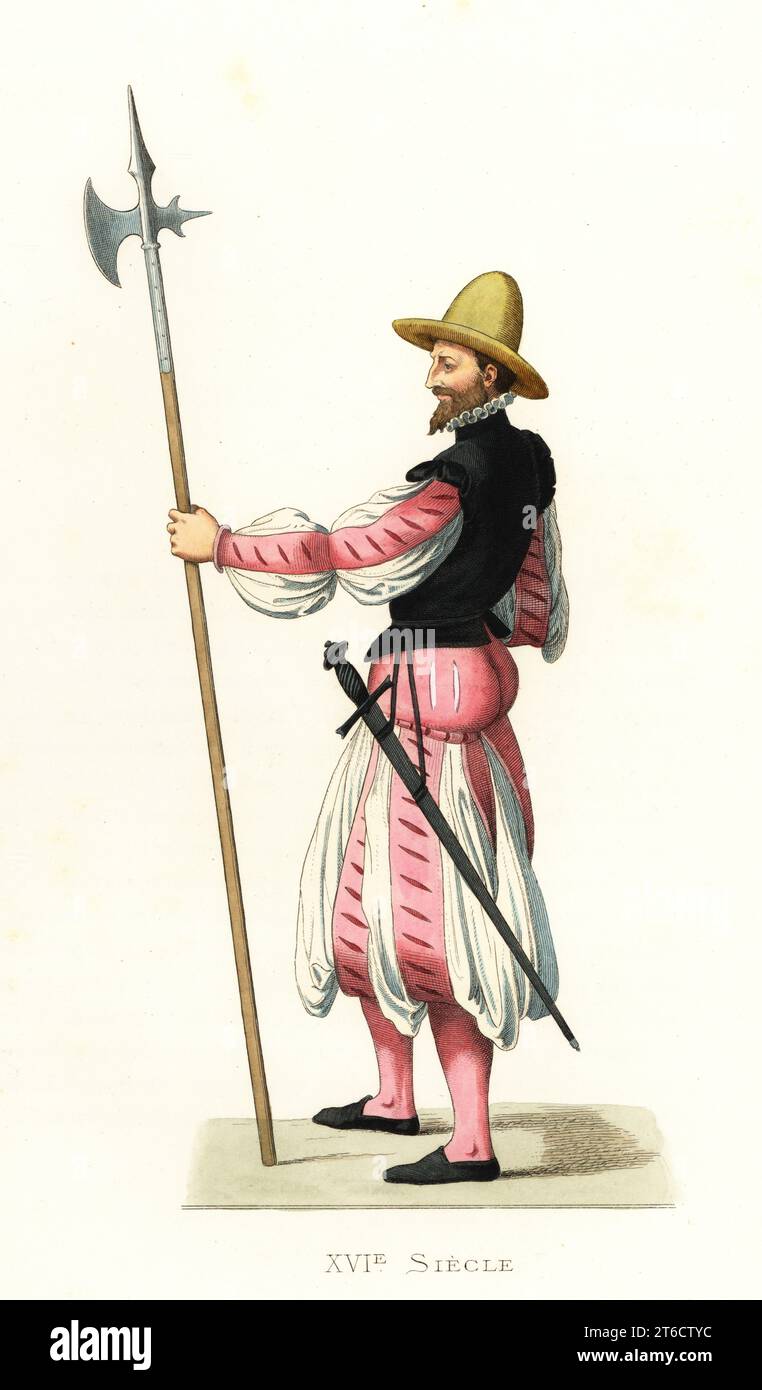 German mercenary soldier or Landsknecht, 16th century. In felt hat, black doublet, long slashed culottes in pink and white, ruff collar, armed with halberd and sword. Soldat Allemand. After a print in the Cabinet des estampes, Bibliotheque imperiale, Paris. Handcolored lithograph after an illustration by Edmond Lechevallier-Chevignard from Georges Duplessis's Costumes historiques des XVIe, XVIIe et XVIIIe siecles (Historical costumes of the 16th, 17th and 18th centuries), Paris, 1867. Edmond Lechevallier-Chevignard was an artist, book illustrator, and interior designer. Stock Photohttps://www.alamy.com/image-license-details/?v=1https://www.alamy.com/german-mercenary-soldier-or-landsknecht-16th-century-in-felt-hat-black-doublet-long-slashed-culottes-in-pink-and-white-ruff-collar-armed-with-halberd-and-sword-soldat-allemand-after-a-print-in-the-cabinet-des-estampes-bibliotheque-imperiale-paris-handcolored-lithograph-after-an-illustration-by-edmond-lechevallier-chevignard-from-georges-duplessiss-costumes-historiques-des-xvie-xviie-et-xviiie-siecles-historical-costumes-of-the-16th-17th-and-18th-centuries-paris-1867-edmond-lechevallier-chevignard-was-an-artist-book-illustrator-and-interior-designer-image571913088.html
German mercenary soldier or Landsknecht, 16th century. In felt hat, black doublet, long slashed culottes in pink and white, ruff collar, armed with halberd and sword. Soldat Allemand. After a print in the Cabinet des estampes, Bibliotheque imperiale, Paris. Handcolored lithograph after an illustration by Edmond Lechevallier-Chevignard from Georges Duplessis's Costumes historiques des XVIe, XVIIe et XVIIIe siecles (Historical costumes of the 16th, 17th and 18th centuries), Paris, 1867. Edmond Lechevallier-Chevignard was an artist, book illustrator, and interior designer. Stock Photohttps://www.alamy.com/image-license-details/?v=1https://www.alamy.com/german-mercenary-soldier-or-landsknecht-16th-century-in-felt-hat-black-doublet-long-slashed-culottes-in-pink-and-white-ruff-collar-armed-with-halberd-and-sword-soldat-allemand-after-a-print-in-the-cabinet-des-estampes-bibliotheque-imperiale-paris-handcolored-lithograph-after-an-illustration-by-edmond-lechevallier-chevignard-from-georges-duplessiss-costumes-historiques-des-xvie-xviie-et-xviiie-siecles-historical-costumes-of-the-16th-17th-and-18th-centuries-paris-1867-edmond-lechevallier-chevignard-was-an-artist-book-illustrator-and-interior-designer-image571913088.htmlRM2T6CTYC–German mercenary soldier or Landsknecht, 16th century. In felt hat, black doublet, long slashed culottes in pink and white, ruff collar, armed with halberd and sword. Soldat Allemand. After a print in the Cabinet des estampes, Bibliotheque imperiale, Paris. Handcolored lithograph after an illustration by Edmond Lechevallier-Chevignard from Georges Duplessis's Costumes historiques des XVIe, XVIIe et XVIIIe siecles (Historical costumes of the 16th, 17th and 18th centuries), Paris, 1867. Edmond Lechevallier-Chevignard was an artist, book illustrator, and interior designer.
 Remain of the original 17th century synagogue now renovated in the town of Sataniv which was once home to a large Jewish community and was annihilated, brutally, by the Germans during the Second World War in the Horodok Raion, Khmelnytskyi Oblast, Ukraine. Stock Photohttps://www.alamy.com/image-license-details/?v=1https://www.alamy.com/remain-of-the-original-17th-century-synagogue-now-renovated-in-the-town-of-sataniv-which-was-once-home-to-a-large-jewish-community-and-was-annihilated-brutally-by-the-germans-during-the-second-world-war-in-the-horodok-raion-khmelnytskyi-oblast-ukraine-image216282292.html
Remain of the original 17th century synagogue now renovated in the town of Sataniv which was once home to a large Jewish community and was annihilated, brutally, by the Germans during the Second World War in the Horodok Raion, Khmelnytskyi Oblast, Ukraine. Stock Photohttps://www.alamy.com/image-license-details/?v=1https://www.alamy.com/remain-of-the-original-17th-century-synagogue-now-renovated-in-the-town-of-sataniv-which-was-once-home-to-a-large-jewish-community-and-was-annihilated-brutally-by-the-germans-during-the-second-world-war-in-the-horodok-raion-khmelnytskyi-oblast-ukraine-image216282292.htmlRMPFTE7G–Remain of the original 17th century synagogue now renovated in the town of Sataniv which was once home to a large Jewish community and was annihilated, brutally, by the Germans during the Second World War in the Horodok Raion, Khmelnytskyi Oblast, Ukraine.
 Usti Nad Labem, Czech Republic. 17th Nov, 2021. Opening of permanent exhibition Our Germans in the presence of guests from Czechia and Germany was held on November 17, 2021, in Usti nad Labem, Czech Republic. Exhibition highlights history of Czech-German coexistence in territory of current Czech Republic from Middle Ages until 20th century. Credit: Ondrej Hajek/CTK Photo/Alamy Live News Stock Photohttps://www.alamy.com/image-license-details/?v=1https://www.alamy.com/usti-nad-labem-czech-republic-17th-nov-2021-opening-of-permanent-exhibition-our-germans-in-the-presence-of-guests-from-czechia-and-germany-was-held-on-november-17-2021-in-usti-nad-labem-czech-republic-exhibition-highlights-history-of-czech-german-coexistence-in-territory-of-current-czech-republic-from-middle-ages-until-20th-century-credit-ondrej-hajekctk-photoalamy-live-news-image451651412.html
Usti Nad Labem, Czech Republic. 17th Nov, 2021. Opening of permanent exhibition Our Germans in the presence of guests from Czechia and Germany was held on November 17, 2021, in Usti nad Labem, Czech Republic. Exhibition highlights history of Czech-German coexistence in territory of current Czech Republic from Middle Ages until 20th century. Credit: Ondrej Hajek/CTK Photo/Alamy Live News Stock Photohttps://www.alamy.com/image-license-details/?v=1https://www.alamy.com/usti-nad-labem-czech-republic-17th-nov-2021-opening-of-permanent-exhibition-our-germans-in-the-presence-of-guests-from-czechia-and-germany-was-held-on-november-17-2021-in-usti-nad-labem-czech-republic-exhibition-highlights-history-of-czech-german-coexistence-in-territory-of-current-czech-republic-from-middle-ages-until-20th-century-credit-ondrej-hajekctk-photoalamy-live-news-image451651412.htmlRM2H6PDYG–Usti Nad Labem, Czech Republic. 17th Nov, 2021. Opening of permanent exhibition Our Germans in the presence of guests from Czechia and Germany was held on November 17, 2021, in Usti nad Labem, Czech Republic. Exhibition highlights history of Czech-German coexistence in territory of current Czech Republic from Middle Ages until 20th century. Credit: Ondrej Hajek/CTK Photo/Alamy Live News
 The figure represented here are a German man of rank in the 1600s. The illustration dates to 1882. Stock Photohttps://www.alamy.com/image-license-details/?v=1https://www.alamy.com/stock-photo-the-figure-represented-here-are-a-german-man-of-rank-in-the-1600s-115436876.html
The figure represented here are a German man of rank in the 1600s. The illustration dates to 1882. Stock Photohttps://www.alamy.com/image-license-details/?v=1https://www.alamy.com/stock-photo-the-figure-represented-here-are-a-german-man-of-rank-in-the-1600s-115436876.htmlRFGKPGWG–The figure represented here are a German man of rank in the 1600s. The illustration dates to 1882.
 San Antonio de los Alemanes Church. Madrid, Spain. Stock Photohttps://www.alamy.com/image-license-details/?v=1https://www.alamy.com/san-antonio-de-los-alemanes-church-madrid-spain-image572953050.html
San Antonio de los Alemanes Church. Madrid, Spain. Stock Photohttps://www.alamy.com/image-license-details/?v=1https://www.alamy.com/san-antonio-de-los-alemanes-church-madrid-spain-image572953050.htmlRF2T847CX–San Antonio de los Alemanes Church. Madrid, Spain.
 German noblemens costumes from the late 15th century. Nobleman A from a fresco in the Basilica in Siena. Aristocrat B from a painting in Frankfurt State Institute. Chromolithograph from Hefner-Alteneck's Costumes, Artworks and Appliances from the Middle Ages to the 17th Century, Frankfurt, 1889. Dr. Hefner-Alteneck (1811 - 1903) was a German museum curator, archaeologist, art historian, illustrator and etcher. Stock Photohttps://www.alamy.com/image-license-details/?v=1https://www.alamy.com/german-noblemens-costumes-from-the-late-15th-century-nobleman-a-from-a-fresco-in-the-basilica-in-siena-aristocrat-b-from-a-painting-in-frankfurt-state-institute-chromolithograph-from-hefner-altenecks-costumes-artworks-and-appliances-from-the-middle-ages-to-the-17th-century-frankfurt-1889-dr-hefner-alteneck-1811-1903-was-a-german-museum-curator-archaeologist-art-historian-illustrator-and-etcher-image571810441.html
German noblemens costumes from the late 15th century. Nobleman A from a fresco in the Basilica in Siena. Aristocrat B from a painting in Frankfurt State Institute. Chromolithograph from Hefner-Alteneck's Costumes, Artworks and Appliances from the Middle Ages to the 17th Century, Frankfurt, 1889. Dr. Hefner-Alteneck (1811 - 1903) was a German museum curator, archaeologist, art historian, illustrator and etcher. Stock Photohttps://www.alamy.com/image-license-details/?v=1https://www.alamy.com/german-noblemens-costumes-from-the-late-15th-century-nobleman-a-from-a-fresco-in-the-basilica-in-siena-aristocrat-b-from-a-painting-in-frankfurt-state-institute-chromolithograph-from-hefner-altenecks-costumes-artworks-and-appliances-from-the-middle-ages-to-the-17th-century-frankfurt-1889-dr-hefner-alteneck-1811-1903-was-a-german-museum-curator-archaeologist-art-historian-illustrator-and-etcher-image571810441.htmlRM2T6861D–German noblemens costumes from the late 15th century. Nobleman A from a fresco in the Basilica in Siena. Aristocrat B from a painting in Frankfurt State Institute. Chromolithograph from Hefner-Alteneck's Costumes, Artworks and Appliances from the Middle Ages to the 17th Century, Frankfurt, 1889. Dr. Hefner-Alteneck (1811 - 1903) was a German museum curator, archaeologist, art historian, illustrator and etcher.
 Remain of the original 17th century synagogue now renovated in the town of Sataniv which was once home to a large Jewish community and was annihilated, brutally, by the Germans during the Second World War in the Horodok Raion, Khmelnytskyi Oblast, Ukraine. Stock Photohttps://www.alamy.com/image-license-details/?v=1https://www.alamy.com/remain-of-the-original-17th-century-synagogue-now-renovated-in-the-town-of-sataniv-which-was-once-home-to-a-large-jewish-community-and-was-annihilated-brutally-by-the-germans-during-the-second-world-war-in-the-horodok-raion-khmelnytskyi-oblast-ukraine-image216282155.html
Remain of the original 17th century synagogue now renovated in the town of Sataniv which was once home to a large Jewish community and was annihilated, brutally, by the Germans during the Second World War in the Horodok Raion, Khmelnytskyi Oblast, Ukraine. Stock Photohttps://www.alamy.com/image-license-details/?v=1https://www.alamy.com/remain-of-the-original-17th-century-synagogue-now-renovated-in-the-town-of-sataniv-which-was-once-home-to-a-large-jewish-community-and-was-annihilated-brutally-by-the-germans-during-the-second-world-war-in-the-horodok-raion-khmelnytskyi-oblast-ukraine-image216282155.htmlRMPFTE2K–Remain of the original 17th century synagogue now renovated in the town of Sataniv which was once home to a large Jewish community and was annihilated, brutally, by the Germans during the Second World War in the Horodok Raion, Khmelnytskyi Oblast, Ukraine.
 Usti Nad Labem, Czech Republic. 17th Nov, 2021. Opening of permanent exhibition Our Germans in the presence of guests from Czechia and Germany was held on November 17, 2021, in Usti nad Labem, Czech Republic. Exhibition highlights history of Czech-German coexistence in territory of current Czech Republic from Middle Ages until 20th century. Credit: Ondrej Hajek/CTK Photo/Alamy Live News Stock Photohttps://www.alamy.com/image-license-details/?v=1https://www.alamy.com/usti-nad-labem-czech-republic-17th-nov-2021-opening-of-permanent-exhibition-our-germans-in-the-presence-of-guests-from-czechia-and-germany-was-held-on-november-17-2021-in-usti-nad-labem-czech-republic-exhibition-highlights-history-of-czech-german-coexistence-in-territory-of-current-czech-republic-from-middle-ages-until-20th-century-credit-ondrej-hajekctk-photoalamy-live-news-image451651505.html
Usti Nad Labem, Czech Republic. 17th Nov, 2021. Opening of permanent exhibition Our Germans in the presence of guests from Czechia and Germany was held on November 17, 2021, in Usti nad Labem, Czech Republic. Exhibition highlights history of Czech-German coexistence in territory of current Czech Republic from Middle Ages until 20th century. Credit: Ondrej Hajek/CTK Photo/Alamy Live News Stock Photohttps://www.alamy.com/image-license-details/?v=1https://www.alamy.com/usti-nad-labem-czech-republic-17th-nov-2021-opening-of-permanent-exhibition-our-germans-in-the-presence-of-guests-from-czechia-and-germany-was-held-on-november-17-2021-in-usti-nad-labem-czech-republic-exhibition-highlights-history-of-czech-german-coexistence-in-territory-of-current-czech-republic-from-middle-ages-until-20th-century-credit-ondrej-hajekctk-photoalamy-live-news-image451651505.htmlRM2H6PE2W–Usti Nad Labem, Czech Republic. 17th Nov, 2021. Opening of permanent exhibition Our Germans in the presence of guests from Czechia and Germany was held on November 17, 2021, in Usti nad Labem, Czech Republic. Exhibition highlights history of Czech-German coexistence in territory of current Czech Republic from Middle Ages until 20th century. Credit: Ondrej Hajek/CTK Photo/Alamy Live News
 The figure represented here is a German man of rank (1690-1700). The illustration dates to 1882. Stock Photohttps://www.alamy.com/image-license-details/?v=1https://www.alamy.com/stock-photo-the-figure-represented-here-is-a-german-man-of-rank-1690-1700-the-118763372.html
The figure represented here is a German man of rank (1690-1700). The illustration dates to 1882. Stock Photohttps://www.alamy.com/image-license-details/?v=1https://www.alamy.com/stock-photo-the-figure-represented-here-is-a-german-man-of-rank-1690-1700-the-118763372.htmlRFGW63W0–The figure represented here is a German man of rank (1690-1700). The illustration dates to 1882.
 San Antonio de los Alemanes Church. Madrid, Spain. Stock Photohttps://www.alamy.com/image-license-details/?v=1https://www.alamy.com/san-antonio-de-los-alemanes-church-madrid-spain-image572953228.html
San Antonio de los Alemanes Church. Madrid, Spain. Stock Photohttps://www.alamy.com/image-license-details/?v=1https://www.alamy.com/san-antonio-de-los-alemanes-church-madrid-spain-image572953228.htmlRF2T847K8–San Antonio de los Alemanes Church. Madrid, Spain.
 Costumes of young German noblemen, late 15th century. Both are cleanshaven with long hair, and mi-parti clothes. One in long gold-embroidered doublet, the other in short cape. They wear their swords in front or to the right. Chromolithograph from Hefner-Alteneck's Costumes, Artworks and Appliances from the Middle Ages to the 17th Century, Frankfurt, 1889. Dr. Hefner-Alteneck (1811 - 1903) was a German museum curator, archaeologist, art historian, illustrator and etcher. Stock Photohttps://www.alamy.com/image-license-details/?v=1https://www.alamy.com/costumes-of-young-german-noblemen-late-15th-century-both-are-cleanshaven-with-long-hair-and-mi-parti-clothes-one-in-long-gold-embroidered-doublet-the-other-in-short-cape-they-wear-their-swords-in-front-or-to-the-right-chromolithograph-from-hefner-altenecks-costumes-artworks-and-appliances-from-the-middle-ages-to-the-17th-century-frankfurt-1889-dr-hefner-alteneck-1811-1903-was-a-german-museum-curator-archaeologist-art-historian-illustrator-and-etcher-image571832550.html
Costumes of young German noblemen, late 15th century. Both are cleanshaven with long hair, and mi-parti clothes. One in long gold-embroidered doublet, the other in short cape. They wear their swords in front or to the right. Chromolithograph from Hefner-Alteneck's Costumes, Artworks and Appliances from the Middle Ages to the 17th Century, Frankfurt, 1889. Dr. Hefner-Alteneck (1811 - 1903) was a German museum curator, archaeologist, art historian, illustrator and etcher. Stock Photohttps://www.alamy.com/image-license-details/?v=1https://www.alamy.com/costumes-of-young-german-noblemen-late-15th-century-both-are-cleanshaven-with-long-hair-and-mi-parti-clothes-one-in-long-gold-embroidered-doublet-the-other-in-short-cape-they-wear-their-swords-in-front-or-to-the-right-chromolithograph-from-hefner-altenecks-costumes-artworks-and-appliances-from-the-middle-ages-to-the-17th-century-frankfurt-1889-dr-hefner-alteneck-1811-1903-was-a-german-museum-curator-archaeologist-art-historian-illustrator-and-etcher-image571832550.htmlRM2T69672–Costumes of young German noblemen, late 15th century. Both are cleanshaven with long hair, and mi-parti clothes. One in long gold-embroidered doublet, the other in short cape. They wear their swords in front or to the right. Chromolithograph from Hefner-Alteneck's Costumes, Artworks and Appliances from the Middle Ages to the 17th Century, Frankfurt, 1889. Dr. Hefner-Alteneck (1811 - 1903) was a German museum curator, archaeologist, art historian, illustrator and etcher.
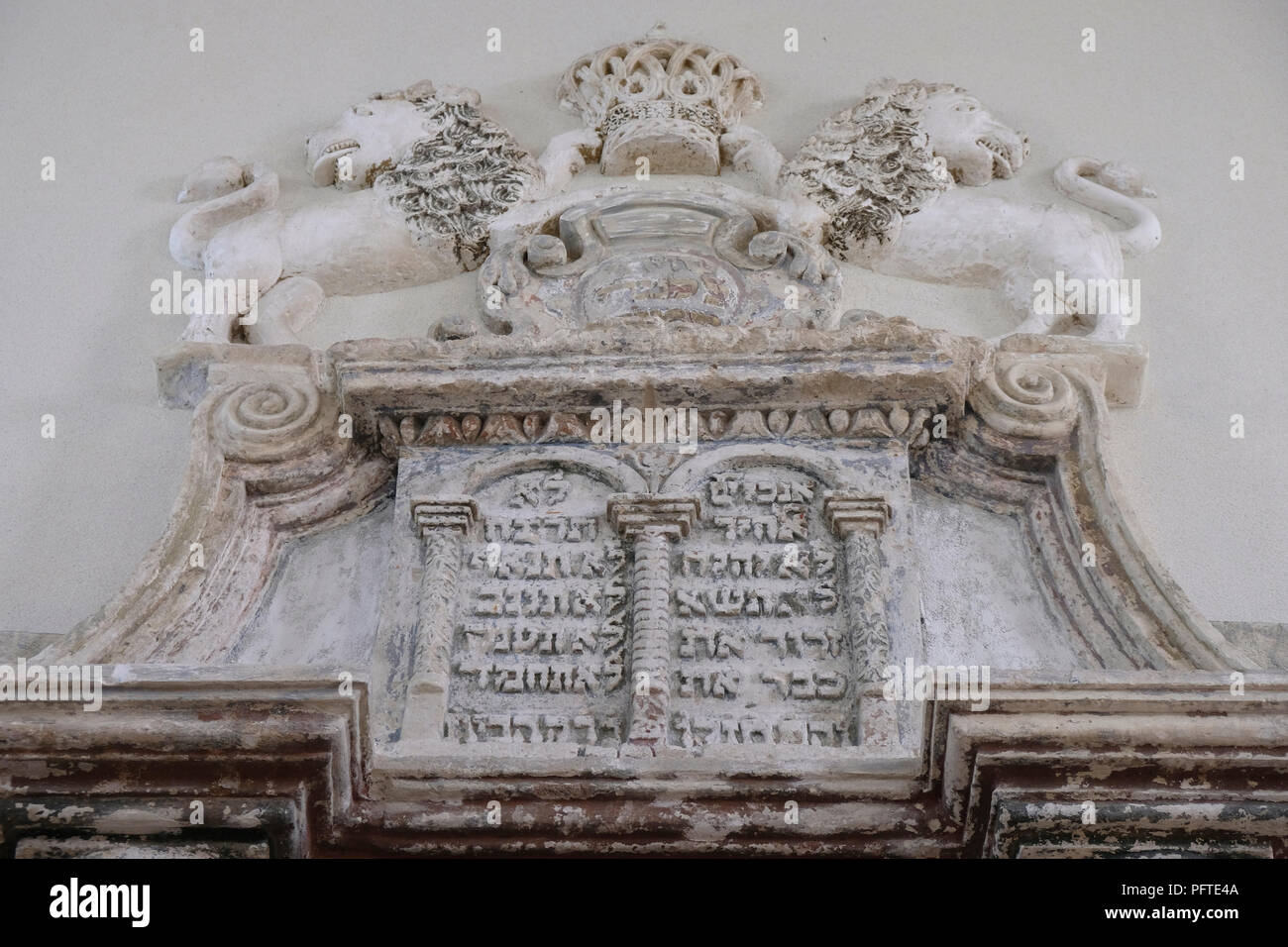 Remain of the original Torah Ark at the renovated 17th century synagogue in the town of Sataniv which was once home to a large Jewish community and was annihilated, brutally, by the Germans during the Second World War in the Horodok Raion, Khmelnytskyi Oblast, Ukraine. Stock Photohttps://www.alamy.com/image-license-details/?v=1https://www.alamy.com/remain-of-the-original-torah-ark-at-the-renovated-17th-century-synagogue-in-the-town-of-sataniv-which-was-once-home-to-a-large-jewish-community-and-was-annihilated-brutally-by-the-germans-during-the-second-world-war-in-the-horodok-raion-khmelnytskyi-oblast-ukraine-image216282202.html
Remain of the original Torah Ark at the renovated 17th century synagogue in the town of Sataniv which was once home to a large Jewish community and was annihilated, brutally, by the Germans during the Second World War in the Horodok Raion, Khmelnytskyi Oblast, Ukraine. Stock Photohttps://www.alamy.com/image-license-details/?v=1https://www.alamy.com/remain-of-the-original-torah-ark-at-the-renovated-17th-century-synagogue-in-the-town-of-sataniv-which-was-once-home-to-a-large-jewish-community-and-was-annihilated-brutally-by-the-germans-during-the-second-world-war-in-the-horodok-raion-khmelnytskyi-oblast-ukraine-image216282202.htmlRMPFTE4A–Remain of the original Torah Ark at the renovated 17th century synagogue in the town of Sataniv which was once home to a large Jewish community and was annihilated, brutally, by the Germans during the Second World War in the Horodok Raion, Khmelnytskyi Oblast, Ukraine.
 Usti Nad Labem, Czech Republic. 17th Nov, 2021. Opening of permanent exhibition Our Germans in the presence of guests from Czechia and Germany was held on November 17, 2021, in Usti nad Labem, Czech Republic. Exhibition highlights history of Czech-German coexistence in territory of current Czech Republic from Middle Ages until 20th century. Credit: Ondrej Hajek/CTK Photo/Alamy Live News Stock Photohttps://www.alamy.com/image-license-details/?v=1https://www.alamy.com/usti-nad-labem-czech-republic-17th-nov-2021-opening-of-permanent-exhibition-our-germans-in-the-presence-of-guests-from-czechia-and-germany-was-held-on-november-17-2021-in-usti-nad-labem-czech-republic-exhibition-highlights-history-of-czech-german-coexistence-in-territory-of-current-czech-republic-from-middle-ages-until-20th-century-credit-ondrej-hajekctk-photoalamy-live-news-image451651495.html
Usti Nad Labem, Czech Republic. 17th Nov, 2021. Opening of permanent exhibition Our Germans in the presence of guests from Czechia and Germany was held on November 17, 2021, in Usti nad Labem, Czech Republic. Exhibition highlights history of Czech-German coexistence in territory of current Czech Republic from Middle Ages until 20th century. Credit: Ondrej Hajek/CTK Photo/Alamy Live News Stock Photohttps://www.alamy.com/image-license-details/?v=1https://www.alamy.com/usti-nad-labem-czech-republic-17th-nov-2021-opening-of-permanent-exhibition-our-germans-in-the-presence-of-guests-from-czechia-and-germany-was-held-on-november-17-2021-in-usti-nad-labem-czech-republic-exhibition-highlights-history-of-czech-german-coexistence-in-territory-of-current-czech-republic-from-middle-ages-until-20th-century-credit-ondrej-hajekctk-photoalamy-live-news-image451651495.htmlRM2H6PE2F–Usti Nad Labem, Czech Republic. 17th Nov, 2021. Opening of permanent exhibition Our Germans in the presence of guests from Czechia and Germany was held on November 17, 2021, in Usti nad Labem, Czech Republic. Exhibition highlights history of Czech-German coexistence in territory of current Czech Republic from Middle Ages until 20th century. Credit: Ondrej Hajek/CTK Photo/Alamy Live News
 The figure represented here is a German man of rank around 1650. The illustration dates to 1882. Stock Photohttps://www.alamy.com/image-license-details/?v=1https://www.alamy.com/stock-photo-the-figure-represented-here-is-a-german-man-of-rank-around-1650-the-118763368.html
The figure represented here is a German man of rank around 1650. The illustration dates to 1882. Stock Photohttps://www.alamy.com/image-license-details/?v=1https://www.alamy.com/stock-photo-the-figure-represented-here-is-a-german-man-of-rank-around-1650-the-118763368.htmlRFGW63TT–The figure represented here is a German man of rank around 1650. The illustration dates to 1882.
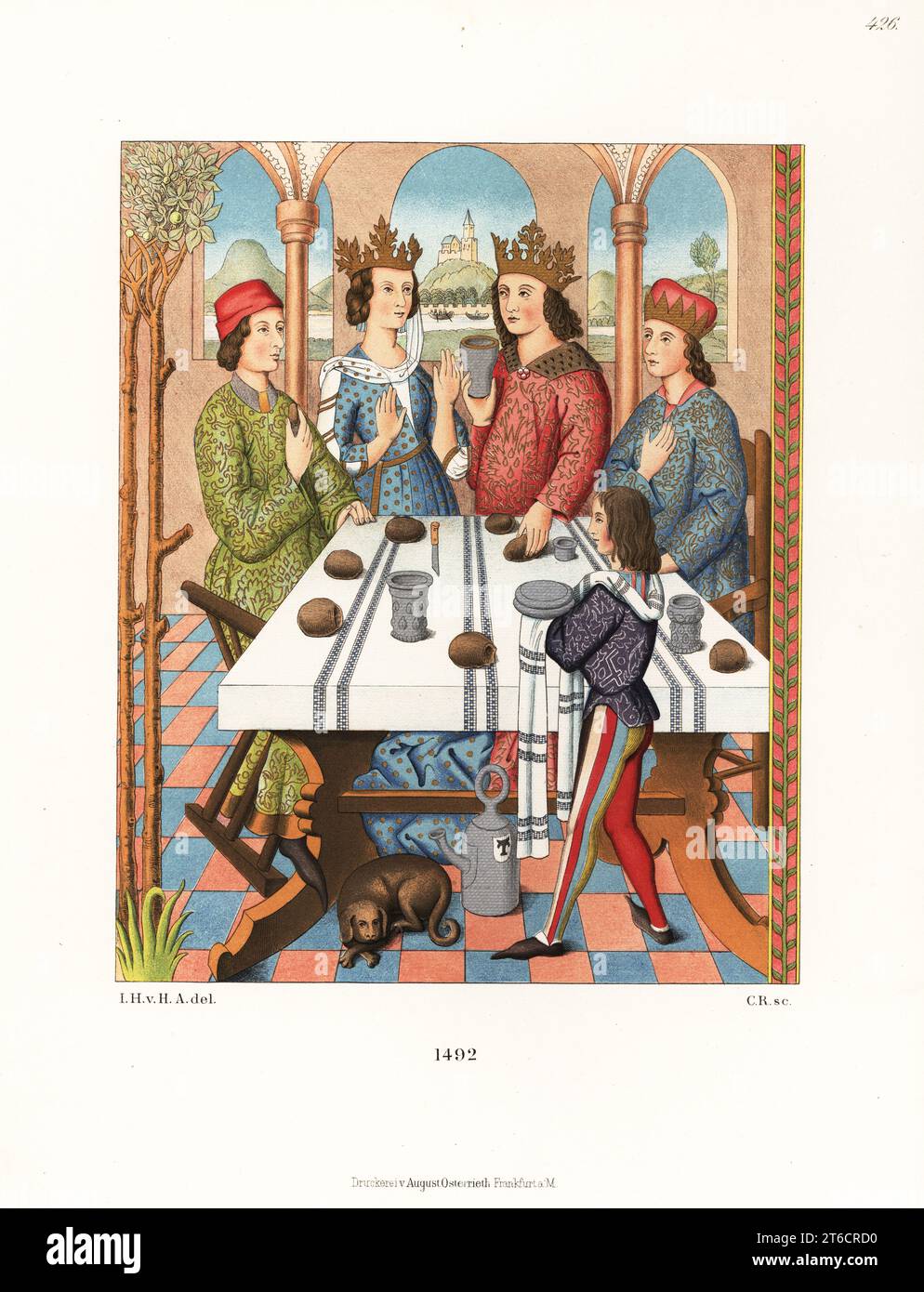 A German royal couple wearing crowns sits at a table laid with bread, knife and cups, 1492. A noble boy in mi-parti hose plays a game. From an embroidered carpet in Nuremberg Museum. Chromolithograph from Hefner-Alteneck's Costumes, Artworks and Appliances from the Middle Ages to the 17th Century, Frankfurt, 1889. Illustration by Dr. Jakob Heinrich von Hefner-Alteneck, lithographed by C. Regnier. Dr. Hefner-Alteneck (1811 - 1903) was a German museum curator, archaeologist, art historian, illustrator and etcher. Stock Photohttps://www.alamy.com/image-license-details/?v=1https://www.alamy.com/a-german-royal-couple-wearing-crowns-sits-at-a-table-laid-with-bread-knife-and-cups-1492-a-noble-boy-in-mi-parti-hose-plays-a-game-from-an-embroidered-carpet-in-nuremberg-museum-chromolithograph-from-hefner-altenecks-costumes-artworks-and-appliances-from-the-middle-ages-to-the-17th-century-frankfurt-1889-illustration-by-dr-jakob-heinrich-von-hefner-alteneck-lithographed-by-c-regnier-dr-hefner-alteneck-1811-1903-was-a-german-museum-curator-archaeologist-art-historian-illustrator-and-etcher-image571911900.html
A German royal couple wearing crowns sits at a table laid with bread, knife and cups, 1492. A noble boy in mi-parti hose plays a game. From an embroidered carpet in Nuremberg Museum. Chromolithograph from Hefner-Alteneck's Costumes, Artworks and Appliances from the Middle Ages to the 17th Century, Frankfurt, 1889. Illustration by Dr. Jakob Heinrich von Hefner-Alteneck, lithographed by C. Regnier. Dr. Hefner-Alteneck (1811 - 1903) was a German museum curator, archaeologist, art historian, illustrator and etcher. Stock Photohttps://www.alamy.com/image-license-details/?v=1https://www.alamy.com/a-german-royal-couple-wearing-crowns-sits-at-a-table-laid-with-bread-knife-and-cups-1492-a-noble-boy-in-mi-parti-hose-plays-a-game-from-an-embroidered-carpet-in-nuremberg-museum-chromolithograph-from-hefner-altenecks-costumes-artworks-and-appliances-from-the-middle-ages-to-the-17th-century-frankfurt-1889-illustration-by-dr-jakob-heinrich-von-hefner-alteneck-lithographed-by-c-regnier-dr-hefner-alteneck-1811-1903-was-a-german-museum-curator-archaeologist-art-historian-illustrator-and-etcher-image571911900.htmlRM2T6CRD0–A German royal couple wearing crowns sits at a table laid with bread, knife and cups, 1492. A noble boy in mi-parti hose plays a game. From an embroidered carpet in Nuremberg Museum. Chromolithograph from Hefner-Alteneck's Costumes, Artworks and Appliances from the Middle Ages to the 17th Century, Frankfurt, 1889. Illustration by Dr. Jakob Heinrich von Hefner-Alteneck, lithographed by C. Regnier. Dr. Hefner-Alteneck (1811 - 1903) was a German museum curator, archaeologist, art historian, illustrator and etcher.
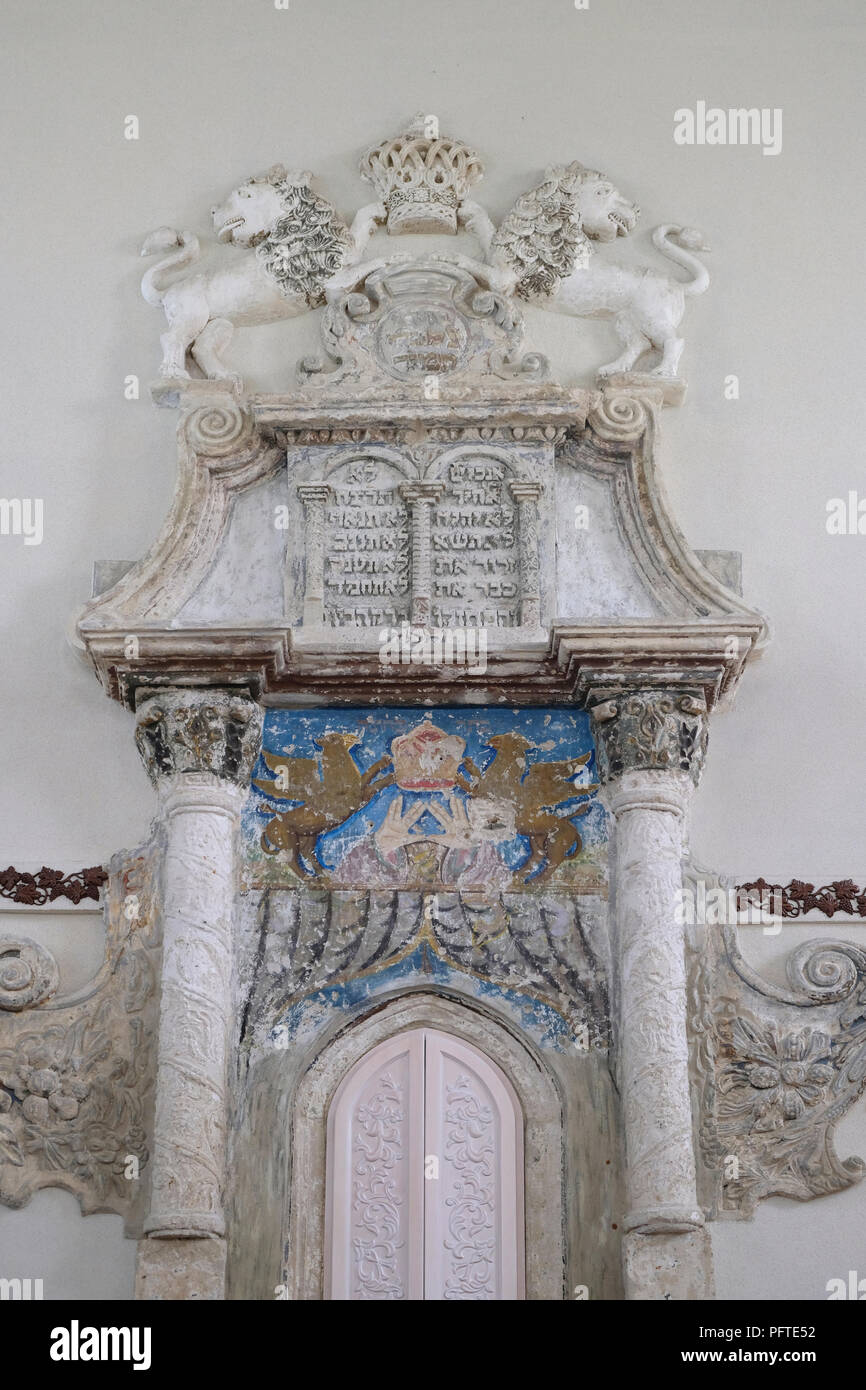 Remain of the original Torah Ark at the renovated 17th century synagogue in the town of Sataniv which was once home to a large Jewish community and was annihilated, brutally, by the Germans during the Second World War in the Horodok Raion, Khmelnytskyi Oblast, Ukraine. Stock Photohttps://www.alamy.com/image-license-details/?v=1https://www.alamy.com/remain-of-the-original-torah-ark-at-the-renovated-17th-century-synagogue-in-the-town-of-sataniv-which-was-once-home-to-a-large-jewish-community-and-was-annihilated-brutally-by-the-germans-during-the-second-world-war-in-the-horodok-raion-khmelnytskyi-oblast-ukraine-image216282222.html
Remain of the original Torah Ark at the renovated 17th century synagogue in the town of Sataniv which was once home to a large Jewish community and was annihilated, brutally, by the Germans during the Second World War in the Horodok Raion, Khmelnytskyi Oblast, Ukraine. Stock Photohttps://www.alamy.com/image-license-details/?v=1https://www.alamy.com/remain-of-the-original-torah-ark-at-the-renovated-17th-century-synagogue-in-the-town-of-sataniv-which-was-once-home-to-a-large-jewish-community-and-was-annihilated-brutally-by-the-germans-during-the-second-world-war-in-the-horodok-raion-khmelnytskyi-oblast-ukraine-image216282222.htmlRMPFTE52–Remain of the original Torah Ark at the renovated 17th century synagogue in the town of Sataniv which was once home to a large Jewish community and was annihilated, brutally, by the Germans during the Second World War in the Horodok Raion, Khmelnytskyi Oblast, Ukraine.
 Usti Nad Labem, Czech Republic. 17th Nov, 2021. Opening of permanent exhibition Our Germans in the presence of guests from Czechia and Germany was held on November 17, 2021, in Usti nad Labem, Czech Republic. Exhibition highlights history of Czech-German coexistence in territory of current Czech Republic from Middle Ages until 20th century. On the photo is seen Petr Koura, historian and head of the Collegium Bohemicum. Credit: Ondrej Hajek/CTK Photo/Alamy Live News Stock Photohttps://www.alamy.com/image-license-details/?v=1https://www.alamy.com/usti-nad-labem-czech-republic-17th-nov-2021-opening-of-permanent-exhibition-our-germans-in-the-presence-of-guests-from-czechia-and-germany-was-held-on-november-17-2021-in-usti-nad-labem-czech-republic-exhibition-highlights-history-of-czech-german-coexistence-in-territory-of-current-czech-republic-from-middle-ages-until-20th-century-on-the-photo-is-seen-petr-koura-historian-and-head-of-the-collegium-bohemicum-credit-ondrej-hajekctk-photoalamy-live-news-image451651504.html
Usti Nad Labem, Czech Republic. 17th Nov, 2021. Opening of permanent exhibition Our Germans in the presence of guests from Czechia and Germany was held on November 17, 2021, in Usti nad Labem, Czech Republic. Exhibition highlights history of Czech-German coexistence in territory of current Czech Republic from Middle Ages until 20th century. On the photo is seen Petr Koura, historian and head of the Collegium Bohemicum. Credit: Ondrej Hajek/CTK Photo/Alamy Live News Stock Photohttps://www.alamy.com/image-license-details/?v=1https://www.alamy.com/usti-nad-labem-czech-republic-17th-nov-2021-opening-of-permanent-exhibition-our-germans-in-the-presence-of-guests-from-czechia-and-germany-was-held-on-november-17-2021-in-usti-nad-labem-czech-republic-exhibition-highlights-history-of-czech-german-coexistence-in-territory-of-current-czech-republic-from-middle-ages-until-20th-century-on-the-photo-is-seen-petr-koura-historian-and-head-of-the-collegium-bohemicum-credit-ondrej-hajekctk-photoalamy-live-news-image451651504.htmlRM2H6PE2T–Usti Nad Labem, Czech Republic. 17th Nov, 2021. Opening of permanent exhibition Our Germans in the presence of guests from Czechia and Germany was held on November 17, 2021, in Usti nad Labem, Czech Republic. Exhibition highlights history of Czech-German coexistence in territory of current Czech Republic from Middle Ages until 20th century. On the photo is seen Petr Koura, historian and head of the Collegium Bohemicum. Credit: Ondrej Hajek/CTK Photo/Alamy Live News
 The figure represented here is a German man of rank in the 1600s. The illustration dates to 1882. Stock Photohttps://www.alamy.com/image-license-details/?v=1https://www.alamy.com/stock-photo-the-figure-represented-here-is-a-german-man-of-rank-in-the-1600s-the-115436890.html
The figure represented here is a German man of rank in the 1600s. The illustration dates to 1882. Stock Photohttps://www.alamy.com/image-license-details/?v=1https://www.alamy.com/stock-photo-the-figure-represented-here-is-a-german-man-of-rank-in-the-1600s-the-115436890.htmlRFGKPGX2–The figure represented here is a German man of rank in the 1600s. The illustration dates to 1882.
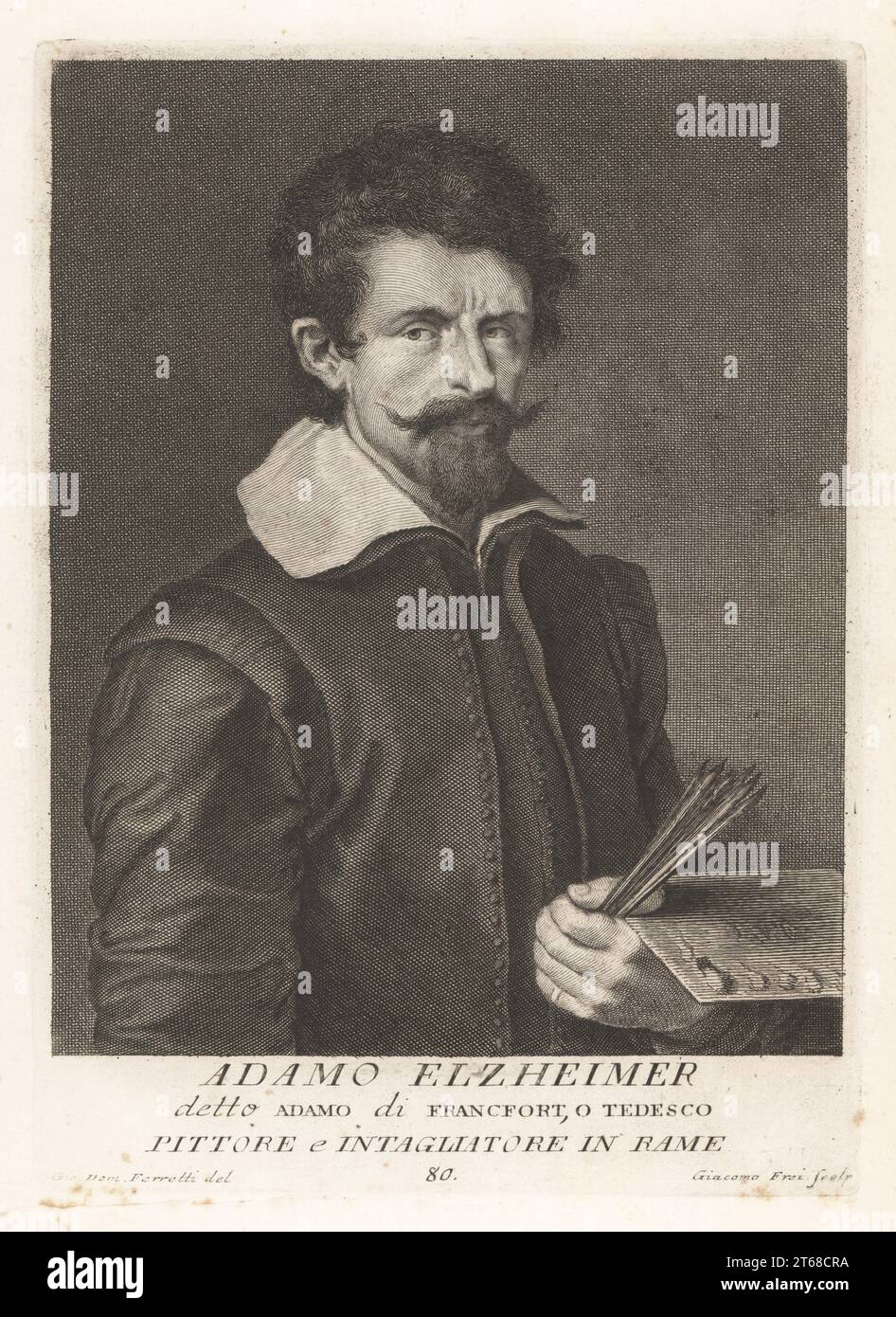 Adam Elsheimer, German painter and engraver working in Rome, 1578-1610. influential in the early 17th century in the field of Baroque paintings. Depicted with paint brushes and palette. Adamo Elzheimer, detto Adamo di Francfort, o Tedesco, pittore e intagliore in rame. Copperplate engraving by Jacob Frey after Giovanni Domenico Ferretti after a self portrait by the artist from Francesco Moucke's Museo Florentino (Museum Florentinum), Serie di Ritratti de Pittori (Series of Portraits of Painters) stamperia Mouckiana, Florence, 1752-62. Stock Photohttps://www.alamy.com/image-license-details/?v=1https://www.alamy.com/adam-elsheimer-german-painter-and-engraver-working-in-rome-1578-1610-influential-in-the-early-17th-century-in-the-field-of-baroque-paintings-depicted-with-paint-brushes-and-palette-adamo-elzheimer-detto-adamo-di-francfort-o-tedesco-pittore-e-intagliore-in-rame-copperplate-engraving-by-jacob-frey-after-giovanni-domenico-ferretti-after-a-self-portrait-by-the-artist-from-francesco-mouckes-museo-florentino-museum-florentinum-serie-di-ritratti-de-pittori-series-of-portraits-of-painters-stamperia-mouckiana-florence-1752-62-image571815758.html
Adam Elsheimer, German painter and engraver working in Rome, 1578-1610. influential in the early 17th century in the field of Baroque paintings. Depicted with paint brushes and palette. Adamo Elzheimer, detto Adamo di Francfort, o Tedesco, pittore e intagliore in rame. Copperplate engraving by Jacob Frey after Giovanni Domenico Ferretti after a self portrait by the artist from Francesco Moucke's Museo Florentino (Museum Florentinum), Serie di Ritratti de Pittori (Series of Portraits of Painters) stamperia Mouckiana, Florence, 1752-62. Stock Photohttps://www.alamy.com/image-license-details/?v=1https://www.alamy.com/adam-elsheimer-german-painter-and-engraver-working-in-rome-1578-1610-influential-in-the-early-17th-century-in-the-field-of-baroque-paintings-depicted-with-paint-brushes-and-palette-adamo-elzheimer-detto-adamo-di-francfort-o-tedesco-pittore-e-intagliore-in-rame-copperplate-engraving-by-jacob-frey-after-giovanni-domenico-ferretti-after-a-self-portrait-by-the-artist-from-francesco-mouckes-museo-florentino-museum-florentinum-serie-di-ritratti-de-pittori-series-of-portraits-of-painters-stamperia-mouckiana-florence-1752-62-image571815758.htmlRM2T68CRA–Adam Elsheimer, German painter and engraver working in Rome, 1578-1610. influential in the early 17th century in the field of Baroque paintings. Depicted with paint brushes and palette. Adamo Elzheimer, detto Adamo di Francfort, o Tedesco, pittore e intagliore in rame. Copperplate engraving by Jacob Frey after Giovanni Domenico Ferretti after a self portrait by the artist from Francesco Moucke's Museo Florentino (Museum Florentinum), Serie di Ritratti de Pittori (Series of Portraits of Painters) stamperia Mouckiana, Florence, 1752-62.
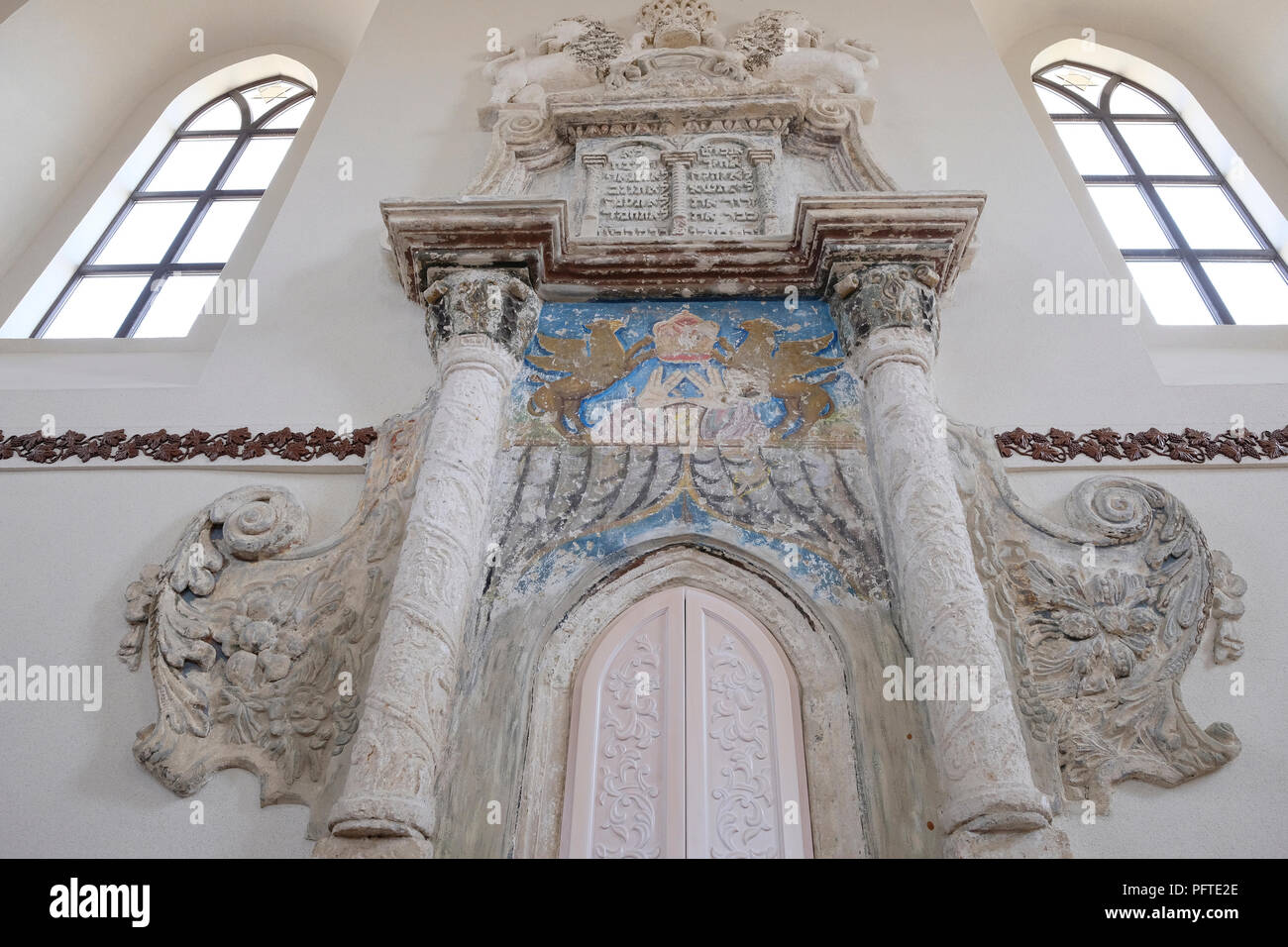 Remain of the original Torah Ark at the renovated 17th century synagogue in the town of Sataniv which was once home to a large Jewish community and was annihilated, brutally, by the Germans during the Second World War in the Horodok Raion, Khmelnytskyi Oblast, Ukraine. Stock Photohttps://www.alamy.com/image-license-details/?v=1https://www.alamy.com/remain-of-the-original-torah-ark-at-the-renovated-17th-century-synagogue-in-the-town-of-sataniv-which-was-once-home-to-a-large-jewish-community-and-was-annihilated-brutally-by-the-germans-during-the-second-world-war-in-the-horodok-raion-khmelnytskyi-oblast-ukraine-image216282150.html
Remain of the original Torah Ark at the renovated 17th century synagogue in the town of Sataniv which was once home to a large Jewish community and was annihilated, brutally, by the Germans during the Second World War in the Horodok Raion, Khmelnytskyi Oblast, Ukraine. Stock Photohttps://www.alamy.com/image-license-details/?v=1https://www.alamy.com/remain-of-the-original-torah-ark-at-the-renovated-17th-century-synagogue-in-the-town-of-sataniv-which-was-once-home-to-a-large-jewish-community-and-was-annihilated-brutally-by-the-germans-during-the-second-world-war-in-the-horodok-raion-khmelnytskyi-oblast-ukraine-image216282150.htmlRMPFTE2E–Remain of the original Torah Ark at the renovated 17th century synagogue in the town of Sataniv which was once home to a large Jewish community and was annihilated, brutally, by the Germans during the Second World War in the Horodok Raion, Khmelnytskyi Oblast, Ukraine.
 Usti Nad Labem, Czech Republic. 17th Nov, 2021. Opening of permanent exhibition Our Germans in the presence of guests from Czechia and Germany was held on November 17, 2021, in Usti nad Labem, Czech Republic. Exhibition highlights history of Czech-German coexistence in territory of current Czech Republic from Middle Ages until 20th century. On the photo is seen Petr Koura, historian and head of the Collegium Bohemicum. Credit: Ondrej Hajek/CTK Photo/Alamy Live News Stock Photohttps://www.alamy.com/image-license-details/?v=1https://www.alamy.com/usti-nad-labem-czech-republic-17th-nov-2021-opening-of-permanent-exhibition-our-germans-in-the-presence-of-guests-from-czechia-and-germany-was-held-on-november-17-2021-in-usti-nad-labem-czech-republic-exhibition-highlights-history-of-czech-german-coexistence-in-territory-of-current-czech-republic-from-middle-ages-until-20th-century-on-the-photo-is-seen-petr-koura-historian-and-head-of-the-collegium-bohemicum-credit-ondrej-hajekctk-photoalamy-live-news-image451651493.html
Usti Nad Labem, Czech Republic. 17th Nov, 2021. Opening of permanent exhibition Our Germans in the presence of guests from Czechia and Germany was held on November 17, 2021, in Usti nad Labem, Czech Republic. Exhibition highlights history of Czech-German coexistence in territory of current Czech Republic from Middle Ages until 20th century. On the photo is seen Petr Koura, historian and head of the Collegium Bohemicum. Credit: Ondrej Hajek/CTK Photo/Alamy Live News Stock Photohttps://www.alamy.com/image-license-details/?v=1https://www.alamy.com/usti-nad-labem-czech-republic-17th-nov-2021-opening-of-permanent-exhibition-our-germans-in-the-presence-of-guests-from-czechia-and-germany-was-held-on-november-17-2021-in-usti-nad-labem-czech-republic-exhibition-highlights-history-of-czech-german-coexistence-in-territory-of-current-czech-republic-from-middle-ages-until-20th-century-on-the-photo-is-seen-petr-koura-historian-and-head-of-the-collegium-bohemicum-credit-ondrej-hajekctk-photoalamy-live-news-image451651493.htmlRM2H6PE2D–Usti Nad Labem, Czech Republic. 17th Nov, 2021. Opening of permanent exhibition Our Germans in the presence of guests from Czechia and Germany was held on November 17, 2021, in Usti nad Labem, Czech Republic. Exhibition highlights history of Czech-German coexistence in territory of current Czech Republic from Middle Ages until 20th century. On the photo is seen Petr Koura, historian and head of the Collegium Bohemicum. Credit: Ondrej Hajek/CTK Photo/Alamy Live News
 Holy Roman Emperor Henry VI, 1165-1197. Heinrich VI, Henricus VI, Asper, King of the Germans, King of Sicily. Copperplate engraving from Abraham Bogaerts De Roomsche Monarchy, The Roman Monarchy, Francois Salma, Utrecht, 1697. Stock Photohttps://www.alamy.com/image-license-details/?v=1https://www.alamy.com/holy-roman-emperor-henry-vi-1165-1197-heinrich-vi-henricus-vi-asper-king-of-the-germans-king-of-sicily-copperplate-engraving-from-abraham-bogaerts-de-roomsche-monarchy-the-roman-monarchy-francois-salma-utrecht-1697-image359062581.html
Holy Roman Emperor Henry VI, 1165-1197. Heinrich VI, Henricus VI, Asper, King of the Germans, King of Sicily. Copperplate engraving from Abraham Bogaerts De Roomsche Monarchy, The Roman Monarchy, Francois Salma, Utrecht, 1697. Stock Photohttps://www.alamy.com/image-license-details/?v=1https://www.alamy.com/holy-roman-emperor-henry-vi-1165-1197-heinrich-vi-henricus-vi-asper-king-of-the-germans-king-of-sicily-copperplate-engraving-from-abraham-bogaerts-de-roomsche-monarchy-the-roman-monarchy-francois-salma-utrecht-1697-image359062581.htmlRM2BT4KYH–Holy Roman Emperor Henry VI, 1165-1197. Heinrich VI, Henricus VI, Asper, King of the Germans, King of Sicily. Copperplate engraving from Abraham Bogaerts De Roomsche Monarchy, The Roman Monarchy, Francois Salma, Utrecht, 1697.
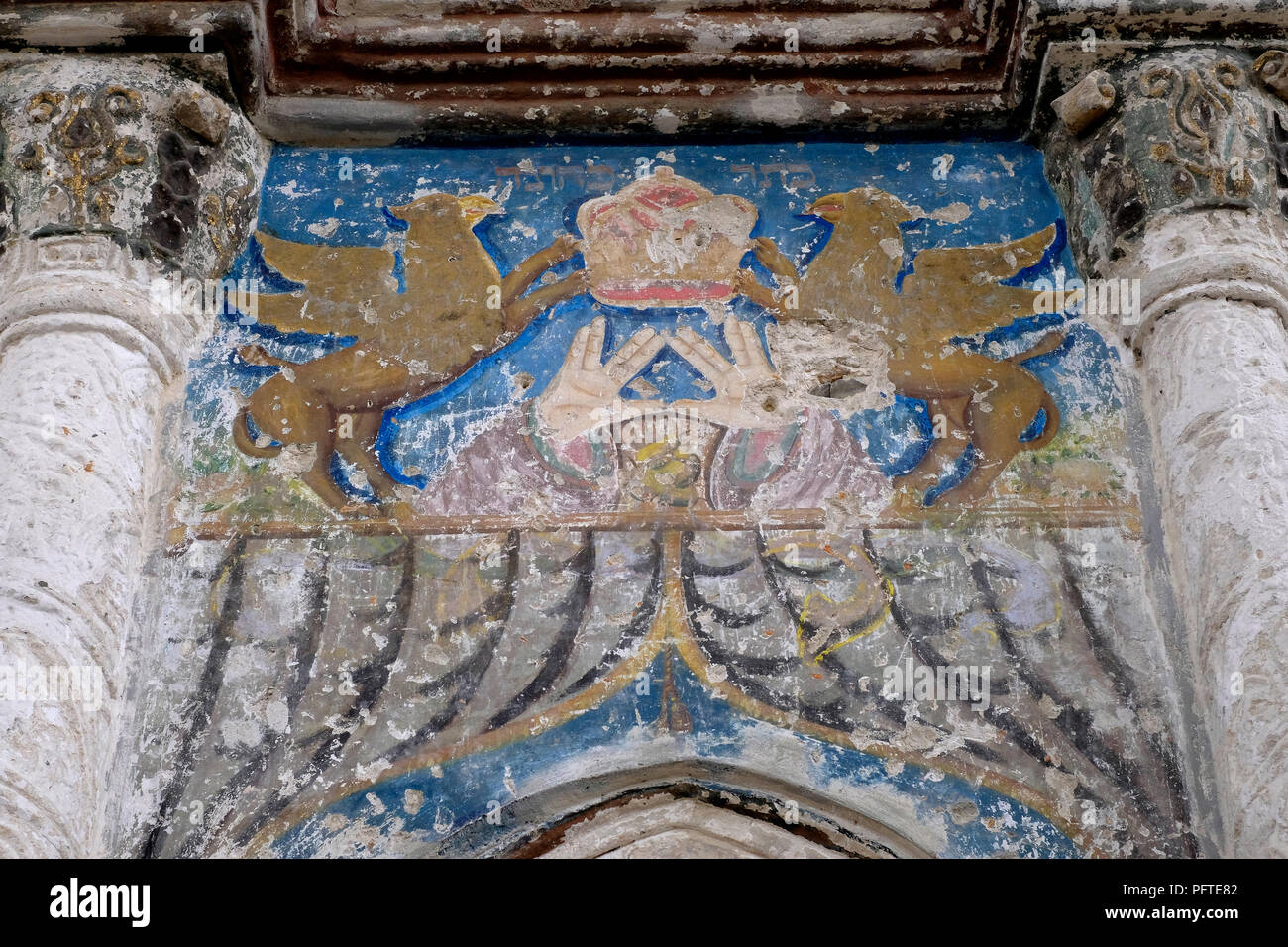 Remain of a decoration above the Torah Ark at the renovated 17th century synagogue in the town of Sataniv which was once home to a large Jewish community and was annihilated, brutally, by the Germans during the Second World War in the Horodok Raion, Khmelnytskyi Oblast, Ukraine. Stock Photohttps://www.alamy.com/image-license-details/?v=1https://www.alamy.com/remain-of-a-decoration-above-the-torah-ark-at-the-renovated-17th-century-synagogue-in-the-town-of-sataniv-which-was-once-home-to-a-large-jewish-community-and-was-annihilated-brutally-by-the-germans-during-the-second-world-war-in-the-horodok-raion-khmelnytskyi-oblast-ukraine-image216282306.html
Remain of a decoration above the Torah Ark at the renovated 17th century synagogue in the town of Sataniv which was once home to a large Jewish community and was annihilated, brutally, by the Germans during the Second World War in the Horodok Raion, Khmelnytskyi Oblast, Ukraine. Stock Photohttps://www.alamy.com/image-license-details/?v=1https://www.alamy.com/remain-of-a-decoration-above-the-torah-ark-at-the-renovated-17th-century-synagogue-in-the-town-of-sataniv-which-was-once-home-to-a-large-jewish-community-and-was-annihilated-brutally-by-the-germans-during-the-second-world-war-in-the-horodok-raion-khmelnytskyi-oblast-ukraine-image216282306.htmlRMPFTE82–Remain of a decoration above the Torah Ark at the renovated 17th century synagogue in the town of Sataniv which was once home to a large Jewish community and was annihilated, brutally, by the Germans during the Second World War in the Horodok Raion, Khmelnytskyi Oblast, Ukraine.
 Usti Nad Labem, Czech Republic. 17th Nov, 2021. Opening of permanent exhibition Our Germans in the presence of guests from Czechia and Germany was held on November 17, 2021, in Usti nad Labem, Czech Republic. Exhibition highlights history of Czech-German coexistence in territory of current Czech Republic from Middle Ages until 20th century. The picture shows the originals of Franz Kafka's letters. Credit: Ondrej Hajek/CTK Photo/Alamy Live News Stock Photohttps://www.alamy.com/image-license-details/?v=1https://www.alamy.com/usti-nad-labem-czech-republic-17th-nov-2021-opening-of-permanent-exhibition-our-germans-in-the-presence-of-guests-from-czechia-and-germany-was-held-on-november-17-2021-in-usti-nad-labem-czech-republic-exhibition-highlights-history-of-czech-german-coexistence-in-territory-of-current-czech-republic-from-middle-ages-until-20th-century-the-picture-shows-the-originals-of-franz-kafkas-letters-credit-ondrej-hajekctk-photoalamy-live-news-image451651511.html
Usti Nad Labem, Czech Republic. 17th Nov, 2021. Opening of permanent exhibition Our Germans in the presence of guests from Czechia and Germany was held on November 17, 2021, in Usti nad Labem, Czech Republic. Exhibition highlights history of Czech-German coexistence in territory of current Czech Republic from Middle Ages until 20th century. The picture shows the originals of Franz Kafka's letters. Credit: Ondrej Hajek/CTK Photo/Alamy Live News Stock Photohttps://www.alamy.com/image-license-details/?v=1https://www.alamy.com/usti-nad-labem-czech-republic-17th-nov-2021-opening-of-permanent-exhibition-our-germans-in-the-presence-of-guests-from-czechia-and-germany-was-held-on-november-17-2021-in-usti-nad-labem-czech-republic-exhibition-highlights-history-of-czech-german-coexistence-in-territory-of-current-czech-republic-from-middle-ages-until-20th-century-the-picture-shows-the-originals-of-franz-kafkas-letters-credit-ondrej-hajekctk-photoalamy-live-news-image451651511.htmlRM2H6PE33–Usti Nad Labem, Czech Republic. 17th Nov, 2021. Opening of permanent exhibition Our Germans in the presence of guests from Czechia and Germany was held on November 17, 2021, in Usti nad Labem, Czech Republic. Exhibition highlights history of Czech-German coexistence in territory of current Czech Republic from Middle Ages until 20th century. The picture shows the originals of Franz Kafka's letters. Credit: Ondrej Hajek/CTK Photo/Alamy Live News
 Dortmund, Germany. View of the city in 16th century. After engraving in P. Bertius's Theatrum Geographicum, 1618. 'Moeurs, usages et costumes au moyen-âge et à l'époque de la Renaissance', by Paul Lacroix. Paris, 1878. Stock Photohttps://www.alamy.com/image-license-details/?v=1https://www.alamy.com/dortmund-germany-view-of-the-city-in-16th-century-after-engraving-in-p-bertiuss-theatrum-geographicum-1618-moeurs-usages-et-costumes-au-moyen-ge-et-lpoque-de-la-renaissance-by-paul-lacroix-paris-1878-image593942555.html
Dortmund, Germany. View of the city in 16th century. After engraving in P. Bertius's Theatrum Geographicum, 1618. 'Moeurs, usages et costumes au moyen-âge et à l'époque de la Renaissance', by Paul Lacroix. Paris, 1878. Stock Photohttps://www.alamy.com/image-license-details/?v=1https://www.alamy.com/dortmund-germany-view-of-the-city-in-16th-century-after-engraving-in-p-bertiuss-theatrum-geographicum-1618-moeurs-usages-et-costumes-au-moyen-ge-et-lpoque-de-la-renaissance-by-paul-lacroix-paris-1878-image593942555.htmlRM2WE8BP3–Dortmund, Germany. View of the city in 16th century. After engraving in P. Bertius's Theatrum Geographicum, 1618. 'Moeurs, usages et costumes au moyen-âge et à l'époque de la Renaissance', by Paul Lacroix. Paris, 1878.
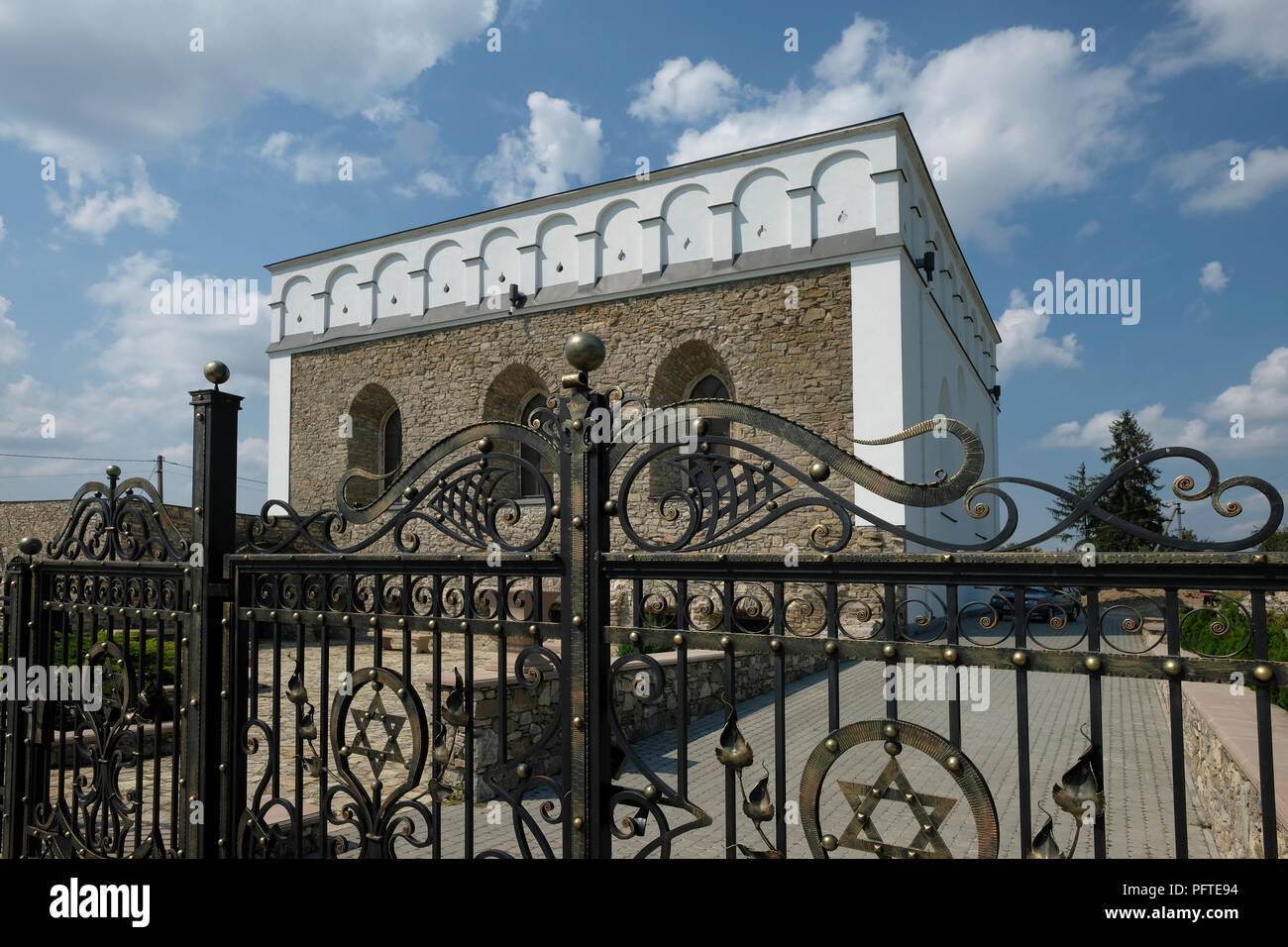 Exterior of the renovated 17th century synagogue which was built as a fortress to allow the Jews to defend themselves against attacks by the Tatars and Cossacks in the town of Sataniv which was once home to a large Jewish community and was annihilated, brutally, by the Germans during the Second World War in the Horodok Raion, Khmelnytskyi Oblast, Ukraine. Stock Photohttps://www.alamy.com/image-license-details/?v=1https://www.alamy.com/exterior-of-the-renovated-17th-century-synagogue-which-was-built-as-a-fortress-to-allow-the-jews-to-defend-themselves-against-attacks-by-the-tatars-and-cossacks-in-the-town-of-sataniv-which-was-once-home-to-a-large-jewish-community-and-was-annihilated-brutally-by-the-germans-during-the-second-world-war-in-the-horodok-raion-khmelnytskyi-oblast-ukraine-image216282336.html
Exterior of the renovated 17th century synagogue which was built as a fortress to allow the Jews to defend themselves against attacks by the Tatars and Cossacks in the town of Sataniv which was once home to a large Jewish community and was annihilated, brutally, by the Germans during the Second World War in the Horodok Raion, Khmelnytskyi Oblast, Ukraine. Stock Photohttps://www.alamy.com/image-license-details/?v=1https://www.alamy.com/exterior-of-the-renovated-17th-century-synagogue-which-was-built-as-a-fortress-to-allow-the-jews-to-defend-themselves-against-attacks-by-the-tatars-and-cossacks-in-the-town-of-sataniv-which-was-once-home-to-a-large-jewish-community-and-was-annihilated-brutally-by-the-germans-during-the-second-world-war-in-the-horodok-raion-khmelnytskyi-oblast-ukraine-image216282336.htmlRMPFTE94–Exterior of the renovated 17th century synagogue which was built as a fortress to allow the Jews to defend themselves against attacks by the Tatars and Cossacks in the town of Sataniv which was once home to a large Jewish community and was annihilated, brutally, by the Germans during the Second World War in the Horodok Raion, Khmelnytskyi Oblast, Ukraine.
 Usti Nad Labem, Czech Republic. 17th Nov, 2021. Opening of permanent exhibition Our Germans in the presence of guests from Czechia and Germany was held on November 17, 2021, in Usti nad Labem, Czech Republic. Exhibition highlights history of Czech-German coexistence in territory of current Czech Republic from Middle Ages until 20th century. On the photo is seen Petr Koura, historian and head of the Collegium Bohemicum. Credit: Ondrej Hajek/CTK Photo/Alamy Live News Stock Photohttps://www.alamy.com/image-license-details/?v=1https://www.alamy.com/usti-nad-labem-czech-republic-17th-nov-2021-opening-of-permanent-exhibition-our-germans-in-the-presence-of-guests-from-czechia-and-germany-was-held-on-november-17-2021-in-usti-nad-labem-czech-republic-exhibition-highlights-history-of-czech-german-coexistence-in-territory-of-current-czech-republic-from-middle-ages-until-20th-century-on-the-photo-is-seen-petr-koura-historian-and-head-of-the-collegium-bohemicum-credit-ondrej-hajekctk-photoalamy-live-news-image451651498.html
Usti Nad Labem, Czech Republic. 17th Nov, 2021. Opening of permanent exhibition Our Germans in the presence of guests from Czechia and Germany was held on November 17, 2021, in Usti nad Labem, Czech Republic. Exhibition highlights history of Czech-German coexistence in territory of current Czech Republic from Middle Ages until 20th century. On the photo is seen Petr Koura, historian and head of the Collegium Bohemicum. Credit: Ondrej Hajek/CTK Photo/Alamy Live News Stock Photohttps://www.alamy.com/image-license-details/?v=1https://www.alamy.com/usti-nad-labem-czech-republic-17th-nov-2021-opening-of-permanent-exhibition-our-germans-in-the-presence-of-guests-from-czechia-and-germany-was-held-on-november-17-2021-in-usti-nad-labem-czech-republic-exhibition-highlights-history-of-czech-german-coexistence-in-territory-of-current-czech-republic-from-middle-ages-until-20th-century-on-the-photo-is-seen-petr-koura-historian-and-head-of-the-collegium-bohemicum-credit-ondrej-hajekctk-photoalamy-live-news-image451651498.htmlRM2H6PE2J–Usti Nad Labem, Czech Republic. 17th Nov, 2021. Opening of permanent exhibition Our Germans in the presence of guests from Czechia and Germany was held on November 17, 2021, in Usti nad Labem, Czech Republic. Exhibition highlights history of Czech-German coexistence in territory of current Czech Republic from Middle Ages until 20th century. On the photo is seen Petr Koura, historian and head of the Collegium Bohemicum. Credit: Ondrej Hajek/CTK Photo/Alamy Live News
 Cardinal Angelo Amato, a representative of the Vatican, pictured during the ceremony of beatification of fourteen Franciscan friars who were tortured to death in the 17th century, St Vitus Cathedral at Prague Castle, Czech Republic, October 13, 2012. This has been the first beatification in the Prague archdiocese. The group of 14 Franciscan friars from various European countries, including the French, Dutch, Germans and Italians, were sent to Prague, which was predominantly Protestant then, at the beginning of the 17th century to preach for the Catholic minority. After the Passau army's invasi Stock Photohttps://www.alamy.com/image-license-details/?v=1https://www.alamy.com/stock-photo-cardinal-angelo-amato-a-representative-of-the-vatican-pictured-during-46853653.html
Cardinal Angelo Amato, a representative of the Vatican, pictured during the ceremony of beatification of fourteen Franciscan friars who were tortured to death in the 17th century, St Vitus Cathedral at Prague Castle, Czech Republic, October 13, 2012. This has been the first beatification in the Prague archdiocese. The group of 14 Franciscan friars from various European countries, including the French, Dutch, Germans and Italians, were sent to Prague, which was predominantly Protestant then, at the beginning of the 17th century to preach for the Catholic minority. After the Passau army's invasi Stock Photohttps://www.alamy.com/image-license-details/?v=1https://www.alamy.com/stock-photo-cardinal-angelo-amato-a-representative-of-the-vatican-pictured-during-46853653.htmlRMCM6A8N–Cardinal Angelo Amato, a representative of the Vatican, pictured during the ceremony of beatification of fourteen Franciscan friars who were tortured to death in the 17th century, St Vitus Cathedral at Prague Castle, Czech Republic, October 13, 2012. This has been the first beatification in the Prague archdiocese. The group of 14 Franciscan friars from various European countries, including the French, Dutch, Germans and Italians, were sent to Prague, which was predominantly Protestant then, at the beginning of the 17th century to preach for the Catholic minority. After the Passau army's invasi
 Plate 32: Dutch and Germans Atttack the Roman Camp and Capture Cerialis' Boat, from The War of the Romans Against the Batavians (Romanorvm et Batavorvm societas). Artist: Antonio Tempesta (Italian, Florence 1555-1630 Rome); After Otto van Veen (Netherlandish, Leiden 1556-1629 Brussels). Dimensions: Sheet: 6 3/8 × 8 1/8 in. (16.2 × 20.6 cm). Date: 1611. Museum: Metropolitan Museum of Art, New York, USA. Stock Photohttps://www.alamy.com/image-license-details/?v=1https://www.alamy.com/plate-32-dutch-and-germans-atttack-the-roman-camp-and-capture-cerialis-boat-from-the-war-of-the-romans-against-the-batavians-romanorvm-et-batavorvm-societas-artist-antonio-tempesta-italian-florence-1555-1630-rome-after-otto-van-veen-netherlandish-leiden-1556-1629-brussels-dimensions-sheet-6-38-8-18-in-162-206-cm-date-1611-museum-metropolitan-museum-of-art-new-york-usa-image233245805.html
Plate 32: Dutch and Germans Atttack the Roman Camp and Capture Cerialis' Boat, from The War of the Romans Against the Batavians (Romanorvm et Batavorvm societas). Artist: Antonio Tempesta (Italian, Florence 1555-1630 Rome); After Otto van Veen (Netherlandish, Leiden 1556-1629 Brussels). Dimensions: Sheet: 6 3/8 × 8 1/8 in. (16.2 × 20.6 cm). Date: 1611. Museum: Metropolitan Museum of Art, New York, USA. Stock Photohttps://www.alamy.com/image-license-details/?v=1https://www.alamy.com/plate-32-dutch-and-germans-atttack-the-roman-camp-and-capture-cerialis-boat-from-the-war-of-the-romans-against-the-batavians-romanorvm-et-batavorvm-societas-artist-antonio-tempesta-italian-florence-1555-1630-rome-after-otto-van-veen-netherlandish-leiden-1556-1629-brussels-dimensions-sheet-6-38-8-18-in-162-206-cm-date-1611-museum-metropolitan-museum-of-art-new-york-usa-image233245805.htmlRMRFD7B9–Plate 32: Dutch and Germans Atttack the Roman Camp and Capture Cerialis' Boat, from The War of the Romans Against the Batavians (Romanorvm et Batavorvm societas). Artist: Antonio Tempesta (Italian, Florence 1555-1630 Rome); After Otto van Veen (Netherlandish, Leiden 1556-1629 Brussels). Dimensions: Sheet: 6 3/8 × 8 1/8 in. (16.2 × 20.6 cm). Date: 1611. Museum: Metropolitan Museum of Art, New York, USA.
 Exterior of the renovated 17th century synagogue which was built as a fortress to allow the Jews to defend themselves against attacks by the Tatars and Cossacks in the town of Sataniv which was once home to a large Jewish community and was annihilated, brutally, by the Germans during the Second World War in the Horodok Raion, Khmelnytskyi Oblast, Ukraine. Stock Photohttps://www.alamy.com/image-license-details/?v=1https://www.alamy.com/exterior-of-the-renovated-17th-century-synagogue-which-was-built-as-a-fortress-to-allow-the-jews-to-defend-themselves-against-attacks-by-the-tatars-and-cossacks-in-the-town-of-sataniv-which-was-once-home-to-a-large-jewish-community-and-was-annihilated-brutally-by-the-germans-during-the-second-world-war-in-the-horodok-raion-khmelnytskyi-oblast-ukraine-image216282330.html
Exterior of the renovated 17th century synagogue which was built as a fortress to allow the Jews to defend themselves against attacks by the Tatars and Cossacks in the town of Sataniv which was once home to a large Jewish community and was annihilated, brutally, by the Germans during the Second World War in the Horodok Raion, Khmelnytskyi Oblast, Ukraine. Stock Photohttps://www.alamy.com/image-license-details/?v=1https://www.alamy.com/exterior-of-the-renovated-17th-century-synagogue-which-was-built-as-a-fortress-to-allow-the-jews-to-defend-themselves-against-attacks-by-the-tatars-and-cossacks-in-the-town-of-sataniv-which-was-once-home-to-a-large-jewish-community-and-was-annihilated-brutally-by-the-germans-during-the-second-world-war-in-the-horodok-raion-khmelnytskyi-oblast-ukraine-image216282330.htmlRMPFTE8X–Exterior of the renovated 17th century synagogue which was built as a fortress to allow the Jews to defend themselves against attacks by the Tatars and Cossacks in the town of Sataniv which was once home to a large Jewish community and was annihilated, brutally, by the Germans during the Second World War in the Horodok Raion, Khmelnytskyi Oblast, Ukraine.